Utilisation of IOT (IOT ) based smart cars to make travelling
VerifiedAdded on 2022/10/01
|49
|14217
|8
AI Summary
Hello there,
I need a quotation for my dissertation final report. I would like the topic to be based on automotive industry.
Structure of the work:
1. EA2 is the topic theme form suggestion which needs completing 600-700 words this by 15th of August 2019 (see attached guidance and form)
2. PowerPoint presentation before before 19th of August
(5 min presentation is required for me to present to my tutor which will need to match the EA2 form and work in conjunction with the suggested topic)
3. 10.000 words dissertation report before 31st of October 2019 as per the handbook instruction.
4. CMI accreditation 1200 words as per the handbook instruction.
I'm looking for merit or distinction mark, top quality work required.
Please let me know if you can do all the work and in time as requested ?
Regards
Raz
Contribute Materials
Your contribution can guide someone’s learning journey. Share your
documents today.
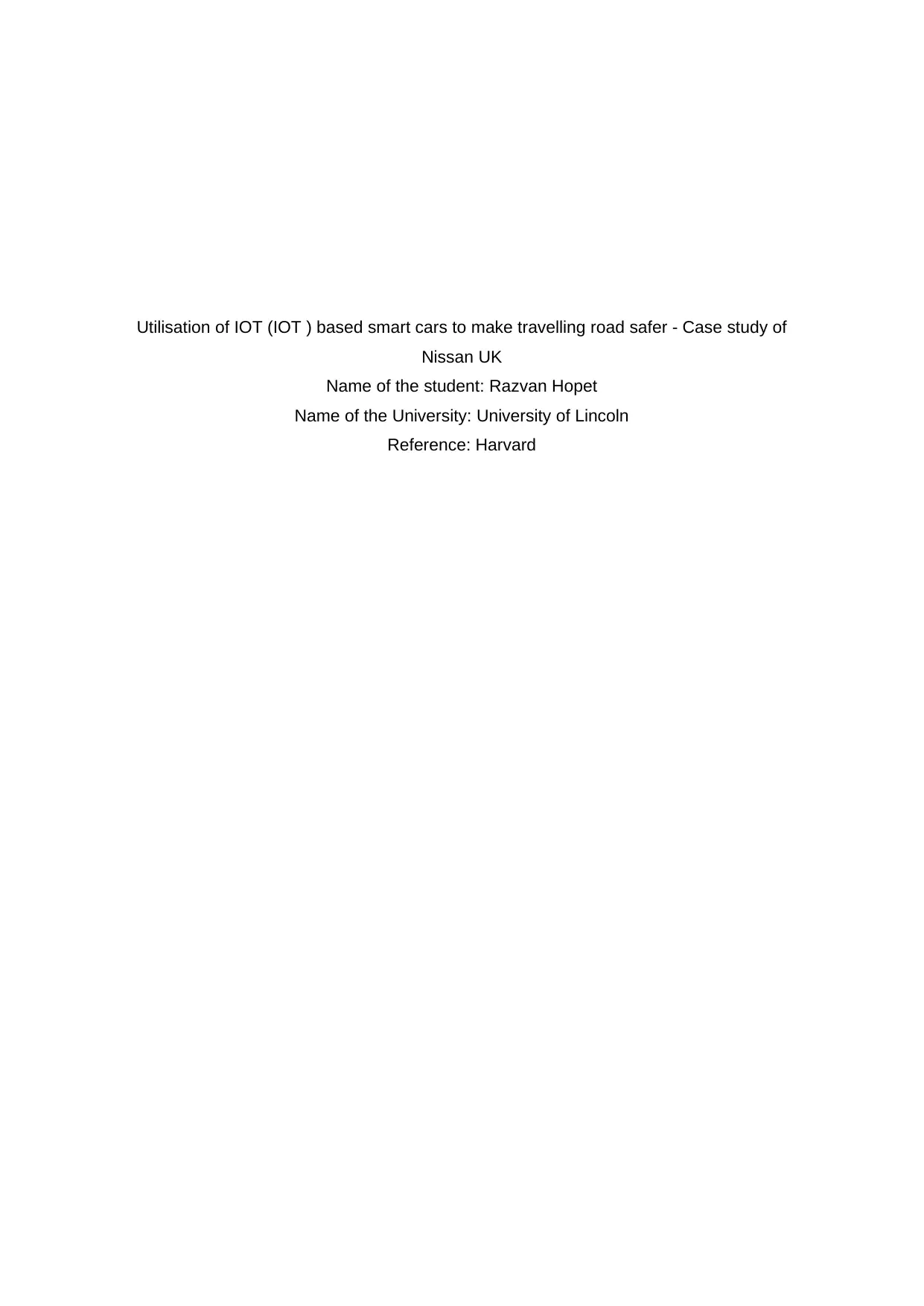
Utilisation of IOT (IOT ) based smart cars to make travelling road safer - Case study of
Nissan UK
Name of the student: Razvan Hopet
Name of the University: University of Lincoln
Reference: Harvard
Nissan UK
Name of the student: Razvan Hopet
Name of the University: University of Lincoln
Reference: Harvard
Secure Best Marks with AI Grader
Need help grading? Try our AI Grader for instant feedback on your assignments.

Acknowledgment:
I would like to thank all staff from University of Lincoln that I collaborated with for the past
two years. Besides this, I would like to thank my juniors as well as senior for their support to
toward completion of the research paper. I would like to extend my gratitude towards the
Module leader Phil for his appreciation and guidance that has helped me to complete my
paper. Lastly, I would like to thank Dr. Ion Gabriel Tudorache without whom I would not been
able to complete my educational journey in engineering for the past five years. I believe his
support and guidance will continue to inspire me in my future career. Their continuous
mental, moral and enthusiastic support helped me complete this final report.
I would like to thank all staff from University of Lincoln that I collaborated with for the past
two years. Besides this, I would like to thank my juniors as well as senior for their support to
toward completion of the research paper. I would like to extend my gratitude towards the
Module leader Phil for his appreciation and guidance that has helped me to complete my
paper. Lastly, I would like to thank Dr. Ion Gabriel Tudorache without whom I would not been
able to complete my educational journey in engineering for the past five years. I believe his
support and guidance will continue to inspire me in my future career. Their continuous
mental, moral and enthusiastic support helped me complete this final report.
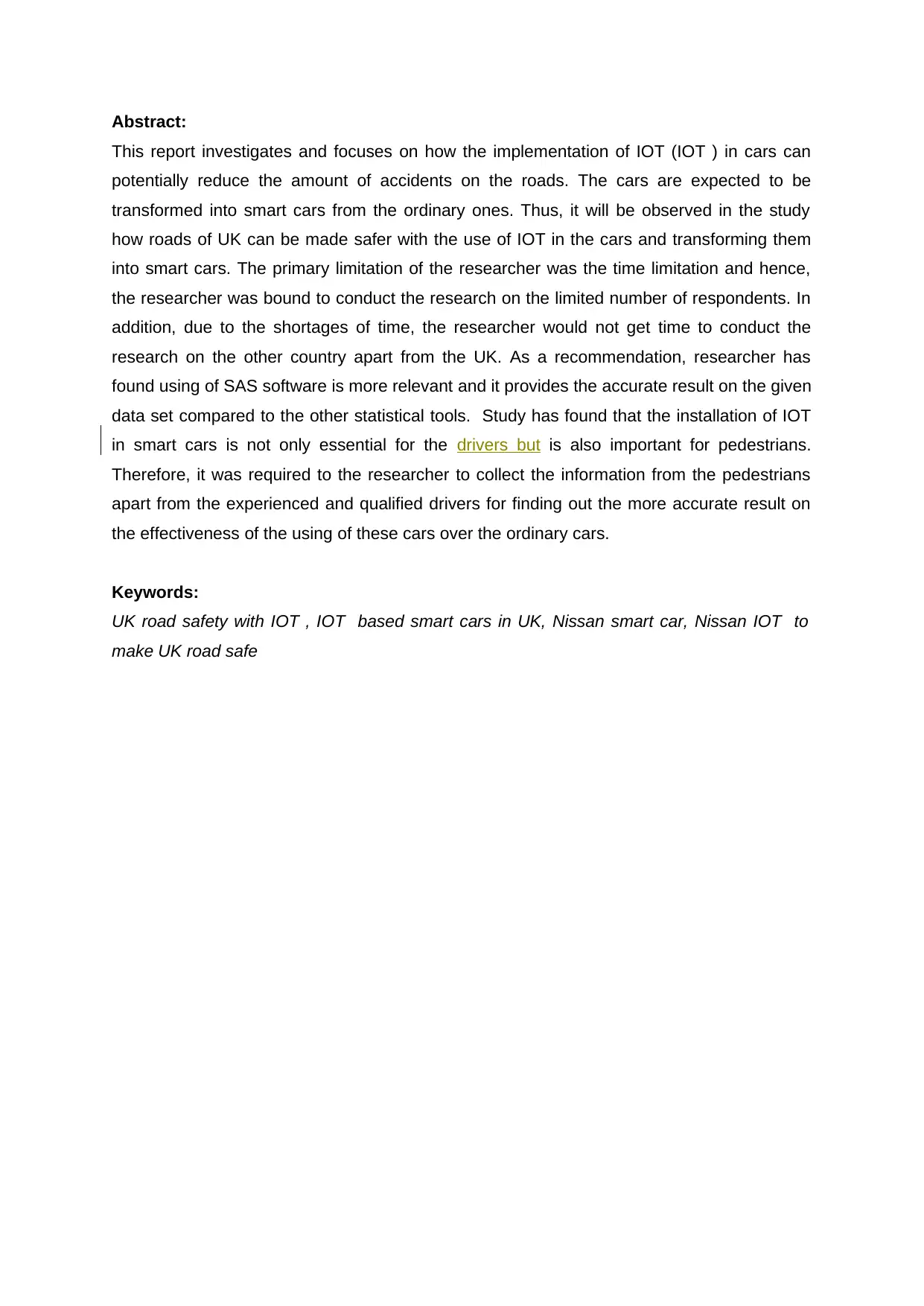
Abstract:
This report investigates and focuses on how the implementation of IOT (IOT ) in cars can
potentially reduce the amount of accidents on the roads. The cars are expected to be
transformed into smart cars from the ordinary ones. Thus, it will be observed in the study
how roads of UK can be made safer with the use of IOT in the cars and transforming them
into smart cars. The primary limitation of the researcher was the time limitation and hence,
the researcher was bound to conduct the research on the limited number of respondents. In
addition, due to the shortages of time, the researcher would not get time to conduct the
research on the other country apart from the UK. As a recommendation, researcher has
found using of SAS software is more relevant and it provides the accurate result on the given
data set compared to the other statistical tools. Study has found that the installation of IOT
in smart cars is not only essential for the drivers but is also important for pedestrians.
Therefore, it was required to the researcher to collect the information from the pedestrians
apart from the experienced and qualified drivers for finding out the more accurate result on
the effectiveness of the using of these cars over the ordinary cars.
Keywords:
UK road safety with IOT , IOT based smart cars in UK, Nissan smart car, Nissan IOT to
make UK road safe
This report investigates and focuses on how the implementation of IOT (IOT ) in cars can
potentially reduce the amount of accidents on the roads. The cars are expected to be
transformed into smart cars from the ordinary ones. Thus, it will be observed in the study
how roads of UK can be made safer with the use of IOT in the cars and transforming them
into smart cars. The primary limitation of the researcher was the time limitation and hence,
the researcher was bound to conduct the research on the limited number of respondents. In
addition, due to the shortages of time, the researcher would not get time to conduct the
research on the other country apart from the UK. As a recommendation, researcher has
found using of SAS software is more relevant and it provides the accurate result on the given
data set compared to the other statistical tools. Study has found that the installation of IOT
in smart cars is not only essential for the drivers but is also important for pedestrians.
Therefore, it was required to the researcher to collect the information from the pedestrians
apart from the experienced and qualified drivers for finding out the more accurate result on
the effectiveness of the using of these cars over the ordinary cars.
Keywords:
UK road safety with IOT , IOT based smart cars in UK, Nissan smart car, Nissan IOT to
make UK road safe
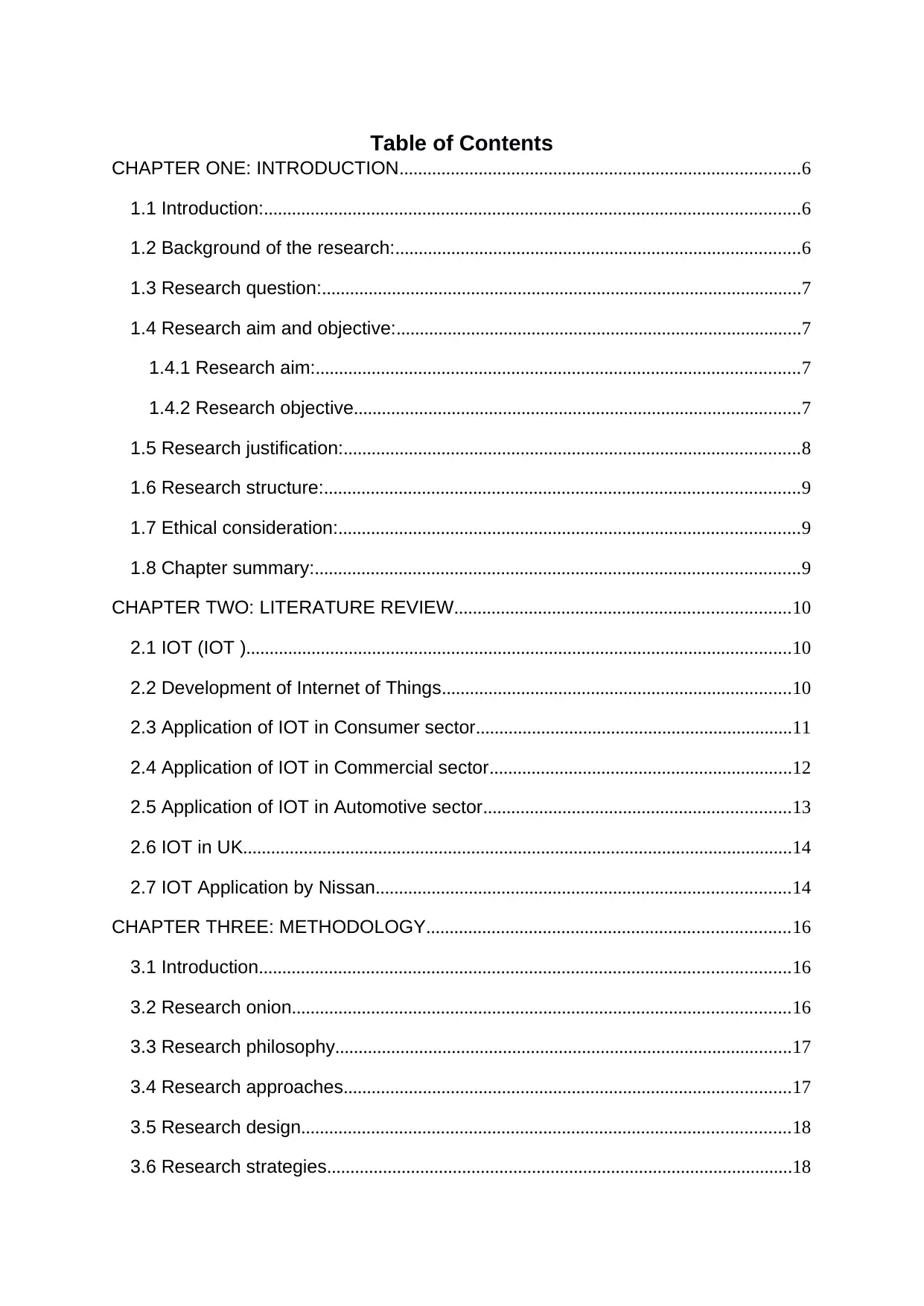
Table of Contents
CHAPTER ONE: INTRODUCTION......................................................................................6
1.1 Introduction:...................................................................................................................6
1.2 Background of the research:.......................................................................................6
1.3 Research question:.......................................................................................................7
1.4 Research aim and objective:.......................................................................................7
1.4.1 Research aim:........................................................................................................7
1.4.2 Research objective................................................................................................7
1.5 Research justification:..................................................................................................8
1.6 Research structure:......................................................................................................9
1.7 Ethical consideration:...................................................................................................9
1.8 Chapter summary:........................................................................................................9
CHAPTER TWO: LITERATURE REVIEW........................................................................10
2.1 IOT (IOT ).....................................................................................................................10
2.2 Development of Internet of Things...........................................................................10
2.3 Application of IOT in Consumer sector....................................................................11
2.4 Application of IOT in Commercial sector.................................................................12
2.5 Application of IOT in Automotive sector..................................................................13
2.6 IOT in UK......................................................................................................................14
2.7 IOT Application by Nissan.........................................................................................14
CHAPTER THREE: METHODOLOGY..............................................................................16
3.1 Introduction..................................................................................................................16
3.2 Research onion...........................................................................................................16
3.3 Research philosophy..................................................................................................17
3.4 Research approaches................................................................................................17
3.5 Research design.........................................................................................................18
3.6 Research strategies....................................................................................................18
CHAPTER ONE: INTRODUCTION......................................................................................6
1.1 Introduction:...................................................................................................................6
1.2 Background of the research:.......................................................................................6
1.3 Research question:.......................................................................................................7
1.4 Research aim and objective:.......................................................................................7
1.4.1 Research aim:........................................................................................................7
1.4.2 Research objective................................................................................................7
1.5 Research justification:..................................................................................................8
1.6 Research structure:......................................................................................................9
1.7 Ethical consideration:...................................................................................................9
1.8 Chapter summary:........................................................................................................9
CHAPTER TWO: LITERATURE REVIEW........................................................................10
2.1 IOT (IOT ).....................................................................................................................10
2.2 Development of Internet of Things...........................................................................10
2.3 Application of IOT in Consumer sector....................................................................11
2.4 Application of IOT in Commercial sector.................................................................12
2.5 Application of IOT in Automotive sector..................................................................13
2.6 IOT in UK......................................................................................................................14
2.7 IOT Application by Nissan.........................................................................................14
CHAPTER THREE: METHODOLOGY..............................................................................16
3.1 Introduction..................................................................................................................16
3.2 Research onion...........................................................................................................16
3.3 Research philosophy..................................................................................................17
3.4 Research approaches................................................................................................17
3.5 Research design.........................................................................................................18
3.6 Research strategies....................................................................................................18
Secure Best Marks with AI Grader
Need help grading? Try our AI Grader for instant feedback on your assignments.
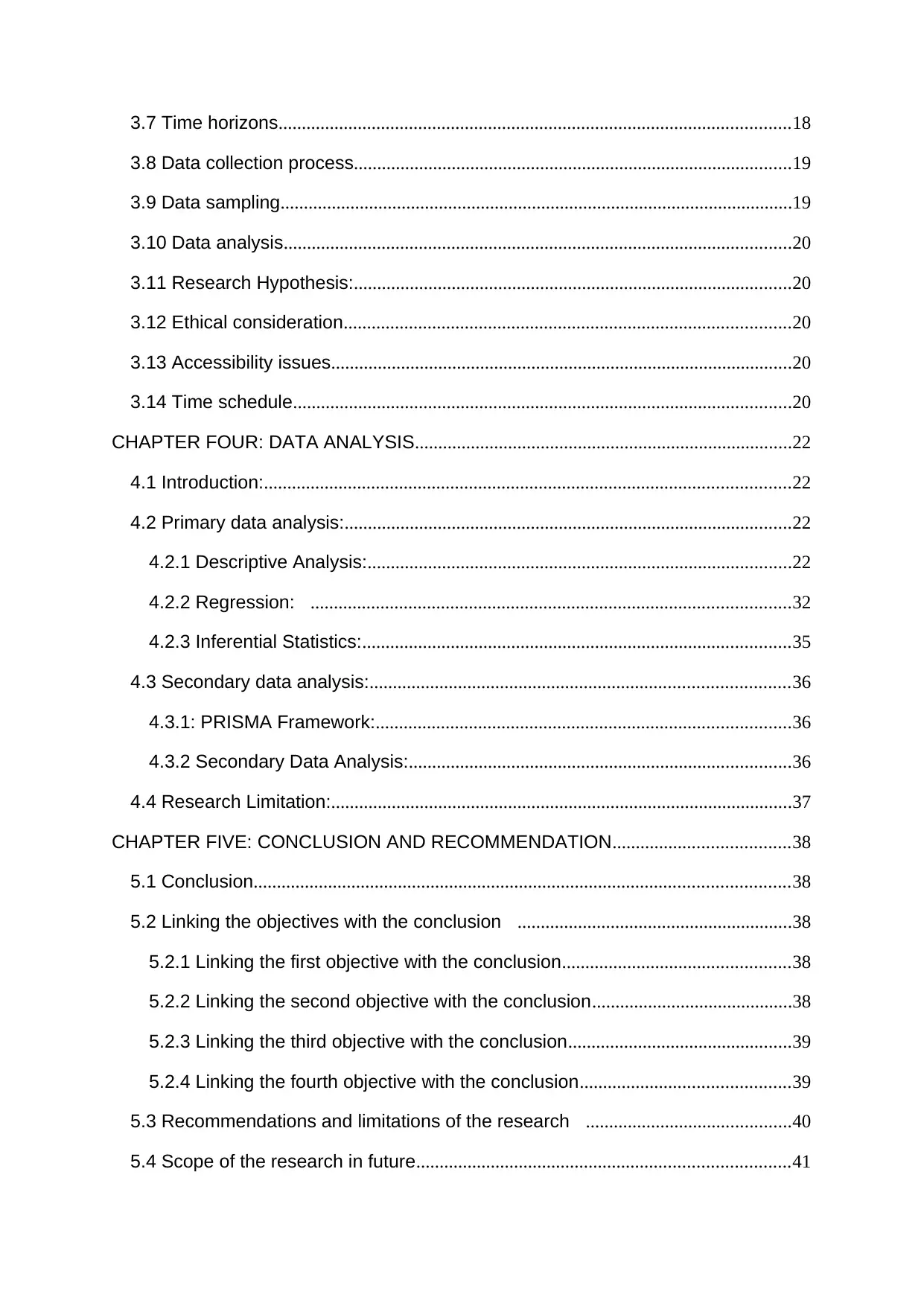
3.7 Time horizons..............................................................................................................18
3.8 Data collection process..............................................................................................19
3.9 Data sampling..............................................................................................................19
3.10 Data analysis.............................................................................................................20
3.11 Research Hypothesis:..............................................................................................20
3.12 Ethical consideration................................................................................................20
3.13 Accessibility issues...................................................................................................20
3.14 Time schedule...........................................................................................................20
CHAPTER FOUR: DATA ANALYSIS.................................................................................22
4.1 Introduction:.................................................................................................................22
4.2 Primary data analysis:................................................................................................22
4.2.1 Descriptive Analysis:...........................................................................................22
4.2.2 Regression: .......................................................................................................32
4.2.3 Inferential Statistics:............................................................................................35
4.3 Secondary data analysis:..........................................................................................36
4.3.1: PRISMA Framework:.........................................................................................36
4.3.2 Secondary Data Analysis:..................................................................................36
4.4 Research Limitation:...................................................................................................37
CHAPTER FIVE: CONCLUSION AND RECOMMENDATION......................................38
5.1 Conclusion...................................................................................................................38
5.2 Linking the objectives with the conclusion ...........................................................38
5.2.1 Linking the first objective with the conclusion.................................................38
5.2.2 Linking the second objective with the conclusion...........................................38
5.2.3 Linking the third objective with the conclusion................................................39
5.2.4 Linking the fourth objective with the conclusion.............................................39
5.3 Recommendations and limitations of the research ............................................40
5.4 Scope of the research in future................................................................................41
3.8 Data collection process..............................................................................................19
3.9 Data sampling..............................................................................................................19
3.10 Data analysis.............................................................................................................20
3.11 Research Hypothesis:..............................................................................................20
3.12 Ethical consideration................................................................................................20
3.13 Accessibility issues...................................................................................................20
3.14 Time schedule...........................................................................................................20
CHAPTER FOUR: DATA ANALYSIS.................................................................................22
4.1 Introduction:.................................................................................................................22
4.2 Primary data analysis:................................................................................................22
4.2.1 Descriptive Analysis:...........................................................................................22
4.2.2 Regression: .......................................................................................................32
4.2.3 Inferential Statistics:............................................................................................35
4.3 Secondary data analysis:..........................................................................................36
4.3.1: PRISMA Framework:.........................................................................................36
4.3.2 Secondary Data Analysis:..................................................................................36
4.4 Research Limitation:...................................................................................................37
CHAPTER FIVE: CONCLUSION AND RECOMMENDATION......................................38
5.1 Conclusion...................................................................................................................38
5.2 Linking the objectives with the conclusion ...........................................................38
5.2.1 Linking the first objective with the conclusion.................................................38
5.2.2 Linking the second objective with the conclusion...........................................38
5.2.3 Linking the third objective with the conclusion................................................39
5.2.4 Linking the fourth objective with the conclusion.............................................39
5.3 Recommendations and limitations of the research ............................................40
5.4 Scope of the research in future................................................................................41

Reference list: .....................................................................................................................42
Appendix:................................................................................................................................47
Appendix:................................................................................................................................47
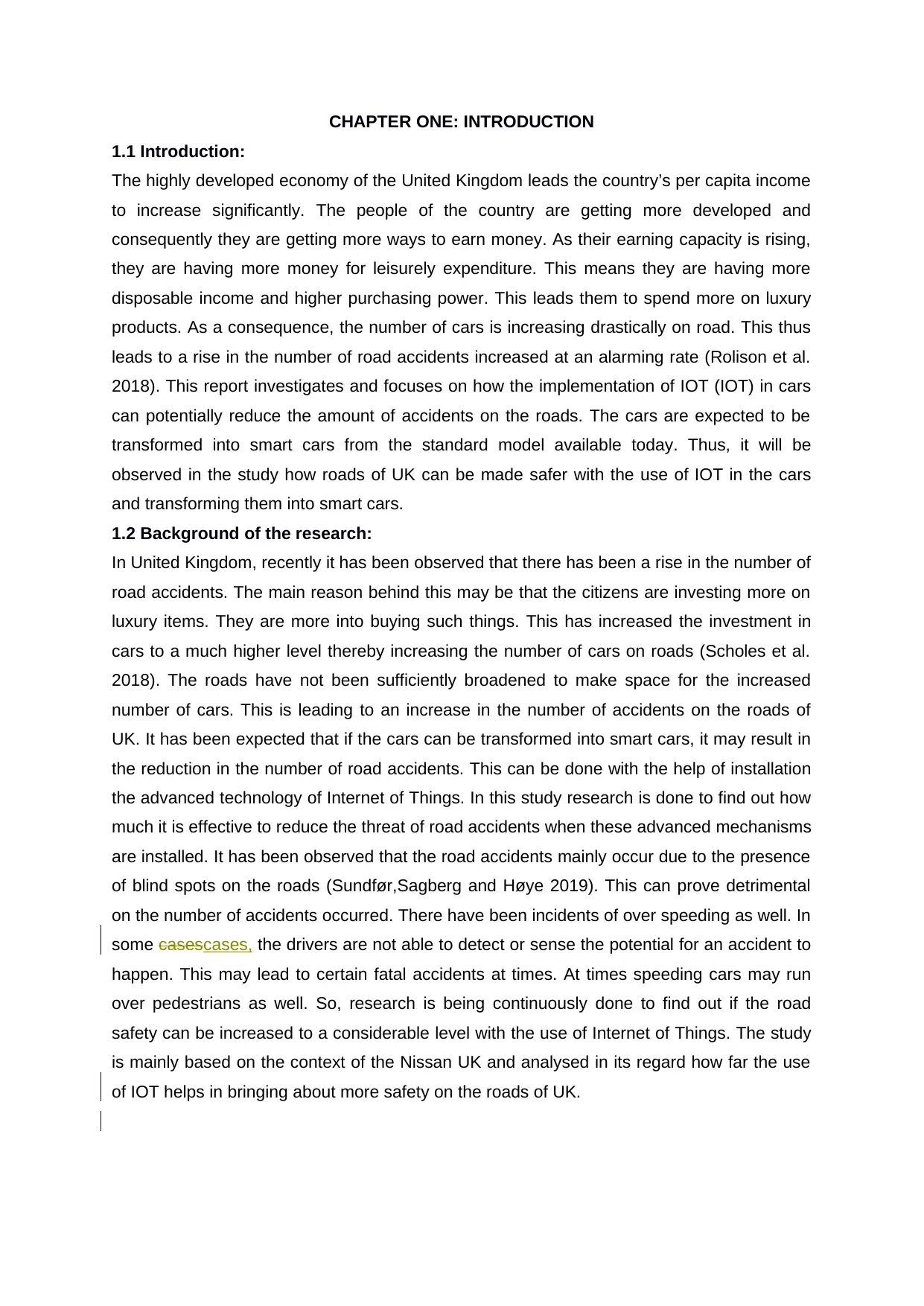
CHAPTER ONE: INTRODUCTION
1.1 Introduction:
The highly developed economy of the United Kingdom leads the country’s per capita income
to increase significantly. The people of the country are getting more developed and
consequently they are getting more ways to earn money. As their earning capacity is rising,
they are having more money for leisurely expenditure. This means they are having more
disposable income and higher purchasing power. This leads them to spend more on luxury
products. As a consequence, the number of cars is increasing drastically on road. This thus
leads to a rise in the number of road accidents increased at an alarming rate (Rolison et al.
2018). This report investigates and focuses on how the implementation of IOT (IOT) in cars
can potentially reduce the amount of accidents on the roads. The cars are expected to be
transformed into smart cars from the standard model available today. Thus, it will be
observed in the study how roads of UK can be made safer with the use of IOT in the cars
and transforming them into smart cars.
1.2 Background of the research:
In United Kingdom, recently it has been observed that there has been a rise in the number of
road accidents. The main reason behind this may be that the citizens are investing more on
luxury items. They are more into buying such things. This has increased the investment in
cars to a much higher level thereby increasing the number of cars on roads (Scholes et al.
2018). The roads have not been sufficiently broadened to make space for the increased
number of cars. This is leading to an increase in the number of accidents on the roads of
UK. It has been expected that if the cars can be transformed into smart cars, it may result in
the reduction in the number of road accidents. This can be done with the help of installation
the advanced technology of Internet of Things. In this study research is done to find out how
much it is effective to reduce the threat of road accidents when these advanced mechanisms
are installed. It has been observed that the road accidents mainly occur due to the presence
of blind spots on the roads (Sundfør,Sagberg and Høye 2019). This can prove detrimental
on the number of accidents occurred. There have been incidents of over speeding as well. In
some casescases, the drivers are not able to detect or sense the potential for an accident to
happen. This may lead to certain fatal accidents at times. At times speeding cars may run
over pedestrians as well. So, research is being continuously done to find out if the road
safety can be increased to a considerable level with the use of Internet of Things. The study
is mainly based on the context of the Nissan UK and analysed in its regard how far the use
of IOT helps in bringing about more safety on the roads of UK.
1.1 Introduction:
The highly developed economy of the United Kingdom leads the country’s per capita income
to increase significantly. The people of the country are getting more developed and
consequently they are getting more ways to earn money. As their earning capacity is rising,
they are having more money for leisurely expenditure. This means they are having more
disposable income and higher purchasing power. This leads them to spend more on luxury
products. As a consequence, the number of cars is increasing drastically on road. This thus
leads to a rise in the number of road accidents increased at an alarming rate (Rolison et al.
2018). This report investigates and focuses on how the implementation of IOT (IOT) in cars
can potentially reduce the amount of accidents on the roads. The cars are expected to be
transformed into smart cars from the standard model available today. Thus, it will be
observed in the study how roads of UK can be made safer with the use of IOT in the cars
and transforming them into smart cars.
1.2 Background of the research:
In United Kingdom, recently it has been observed that there has been a rise in the number of
road accidents. The main reason behind this may be that the citizens are investing more on
luxury items. They are more into buying such things. This has increased the investment in
cars to a much higher level thereby increasing the number of cars on roads (Scholes et al.
2018). The roads have not been sufficiently broadened to make space for the increased
number of cars. This is leading to an increase in the number of accidents on the roads of
UK. It has been expected that if the cars can be transformed into smart cars, it may result in
the reduction in the number of road accidents. This can be done with the help of installation
the advanced technology of Internet of Things. In this study research is done to find out how
much it is effective to reduce the threat of road accidents when these advanced mechanisms
are installed. It has been observed that the road accidents mainly occur due to the presence
of blind spots on the roads (Sundfør,Sagberg and Høye 2019). This can prove detrimental
on the number of accidents occurred. There have been incidents of over speeding as well. In
some casescases, the drivers are not able to detect or sense the potential for an accident to
happen. This may lead to certain fatal accidents at times. At times speeding cars may run
over pedestrians as well. So, research is being continuously done to find out if the road
safety can be increased to a considerable level with the use of Internet of Things. The study
is mainly based on the context of the Nissan UK and analysed in its regard how far the use
of IOT helps in bringing about more safety on the roads of UK.
Paraphrase This Document
Need a fresh take? Get an instant paraphrase of this document with our AI Paraphraser
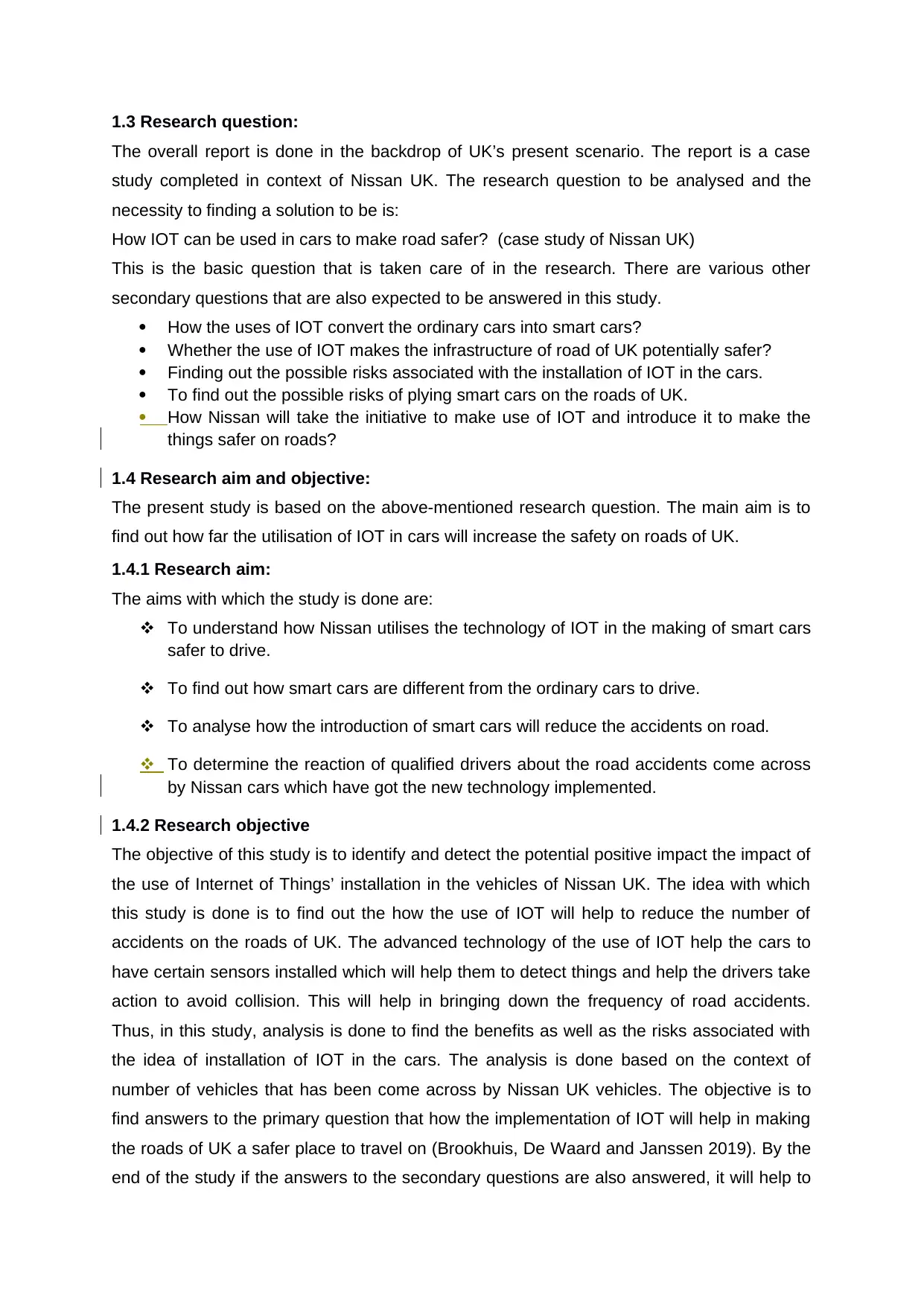
1.3 Research question:
The overall report is done in the backdrop of UK’s present scenario. The report is a case
study completed in context of Nissan UK. The research question to be analysed and the
necessity to finding a solution to be is:
How IOT can be used in cars to make road safer? (case study of Nissan UK)
This is the basic question that is taken care of in the research. There are various other
secondary questions that are also expected to be answered in this study.
How the uses of IOT convert the ordinary cars into smart cars?
Whether the use of IOT makes the infrastructure of road of UK potentially safer?
Finding out the possible risks associated with the installation of IOT in the cars.
To find out the possible risks of plying smart cars on the roads of UK.
How Nissan will take the initiative to make use of IOT and introduce it to make the
things safer on roads?
1.4 Research aim and objective:
The present study is based on the above-mentioned research question. The main aim is to
find out how far the utilisation of IOT in cars will increase the safety on roads of UK.
1.4.1 Research aim:
The aims with which the study is done are:
To understand how Nissan utilises the technology of IOT in the making of smart cars
safer to drive.
To find out how smart cars are different from the ordinary cars to drive.
To analyse how the introduction of smart cars will reduce the accidents on road.
To determine the reaction of qualified drivers about the road accidents come across
by Nissan cars which have got the new technology implemented.
1.4.2 Research objective
The objective of this study is to identify and detect the potential positive impact the impact of
the use of Internet of Things’ installation in the vehicles of Nissan UK. The idea with which
this study is done is to find out the how the use of IOT will help to reduce the number of
accidents on the roads of UK. The advanced technology of the use of IOT help the cars to
have certain sensors installed which will help them to detect things and help the drivers take
action to avoid collision. This will help in bringing down the frequency of road accidents.
Thus, in this study, analysis is done to find the benefits as well as the risks associated with
the idea of installation of IOT in the cars. The analysis is done based on the context of
number of vehicles that has been come across by Nissan UK vehicles. The objective is to
find answers to the primary question that how the implementation of IOT will help in making
the roads of UK a safer place to travel on (Brookhuis, De Waard and Janssen 2019). By the
end of the study if the answers to the secondary questions are also answered, it will help to
The overall report is done in the backdrop of UK’s present scenario. The report is a case
study completed in context of Nissan UK. The research question to be analysed and the
necessity to finding a solution to be is:
How IOT can be used in cars to make road safer? (case study of Nissan UK)
This is the basic question that is taken care of in the research. There are various other
secondary questions that are also expected to be answered in this study.
How the uses of IOT convert the ordinary cars into smart cars?
Whether the use of IOT makes the infrastructure of road of UK potentially safer?
Finding out the possible risks associated with the installation of IOT in the cars.
To find out the possible risks of plying smart cars on the roads of UK.
How Nissan will take the initiative to make use of IOT and introduce it to make the
things safer on roads?
1.4 Research aim and objective:
The present study is based on the above-mentioned research question. The main aim is to
find out how far the utilisation of IOT in cars will increase the safety on roads of UK.
1.4.1 Research aim:
The aims with which the study is done are:
To understand how Nissan utilises the technology of IOT in the making of smart cars
safer to drive.
To find out how smart cars are different from the ordinary cars to drive.
To analyse how the introduction of smart cars will reduce the accidents on road.
To determine the reaction of qualified drivers about the road accidents come across
by Nissan cars which have got the new technology implemented.
1.4.2 Research objective
The objective of this study is to identify and detect the potential positive impact the impact of
the use of Internet of Things’ installation in the vehicles of Nissan UK. The idea with which
this study is done is to find out the how the use of IOT will help to reduce the number of
accidents on the roads of UK. The advanced technology of the use of IOT help the cars to
have certain sensors installed which will help them to detect things and help the drivers take
action to avoid collision. This will help in bringing down the frequency of road accidents.
Thus, in this study, analysis is done to find the benefits as well as the risks associated with
the idea of installation of IOT in the cars. The analysis is done based on the context of
number of vehicles that has been come across by Nissan UK vehicles. The objective is to
find answers to the primary question that how the implementation of IOT will help in making
the roads of UK a safer place to travel on (Brookhuis, De Waard and Janssen 2019). By the
end of the study if the answers to the secondary questions are also answered, it will help to
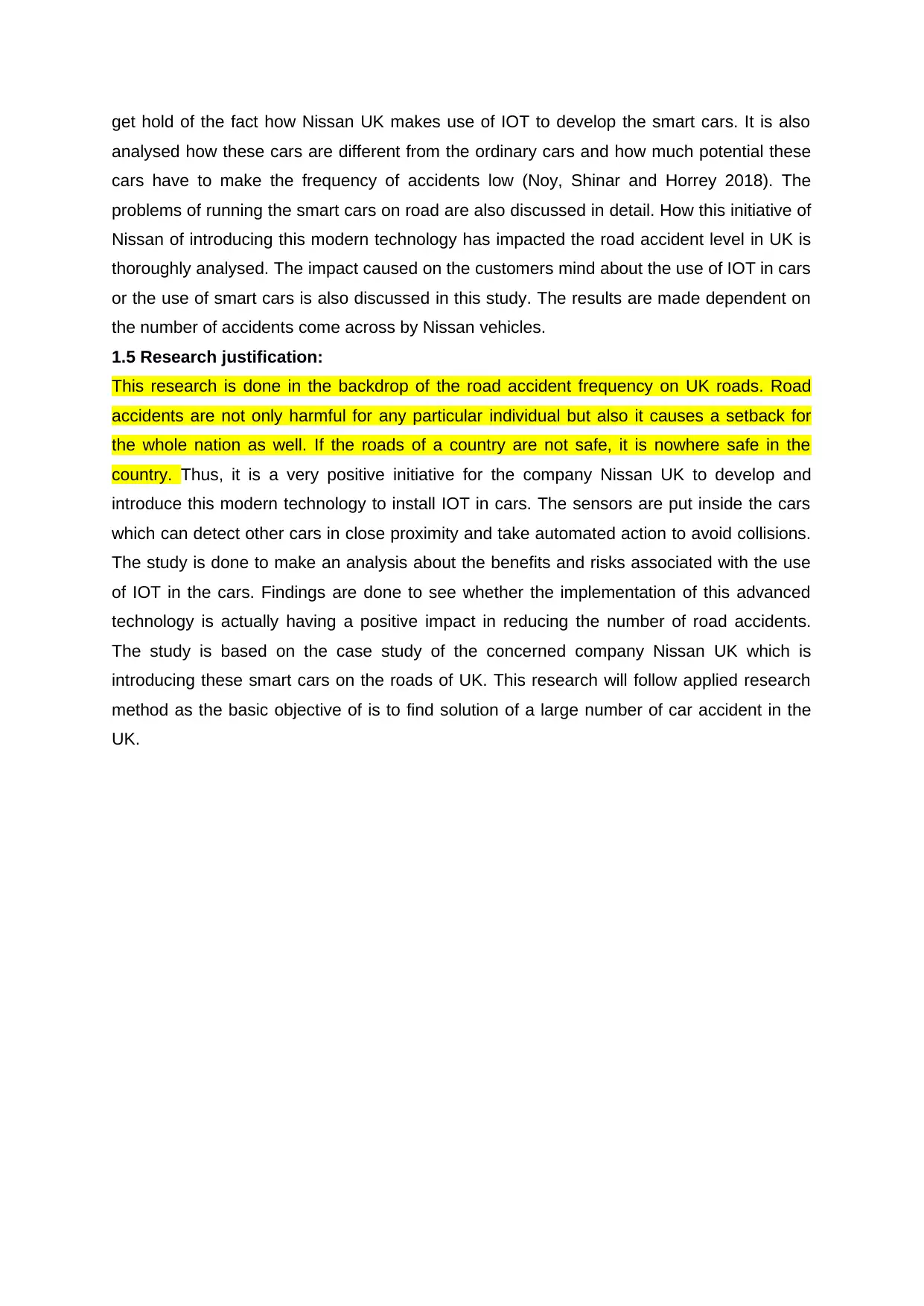
get hold of the fact how Nissan UK makes use of IOT to develop the smart cars. It is also
analysed how these cars are different from the ordinary cars and how much potential these
cars have to make the frequency of accidents low (Noy, Shinar and Horrey 2018). The
problems of running the smart cars on road are also discussed in detail. How this initiative of
Nissan of introducing this modern technology has impacted the road accident level in UK is
thoroughly analysed. The impact caused on the customers mind about the use of IOT in cars
or the use of smart cars is also discussed in this study. The results are made dependent on
the number of accidents come across by Nissan vehicles.
1.5 Research justification:
This research is done in the backdrop of the road accident frequency on UK roads. Road
accidents are not only harmful for any particular individual but also it causes a setback for
the whole nation as well. If the roads of a country are not safe, it is nowhere safe in the
country. Thus, it is a very positive initiative for the company Nissan UK to develop and
introduce this modern technology to install IOT in cars. The sensors are put inside the cars
which can detect other cars in close proximity and take automated action to avoid collisions.
The study is done to make an analysis about the benefits and risks associated with the use
of IOT in the cars. Findings are done to see whether the implementation of this advanced
technology is actually having a positive impact in reducing the number of road accidents.
The study is based on the case study of the concerned company Nissan UK which is
introducing these smart cars on the roads of UK. This research will follow applied research
method as the basic objective of is to find solution of a large number of car accident in the
UK.
analysed how these cars are different from the ordinary cars and how much potential these
cars have to make the frequency of accidents low (Noy, Shinar and Horrey 2018). The
problems of running the smart cars on road are also discussed in detail. How this initiative of
Nissan of introducing this modern technology has impacted the road accident level in UK is
thoroughly analysed. The impact caused on the customers mind about the use of IOT in cars
or the use of smart cars is also discussed in this study. The results are made dependent on
the number of accidents come across by Nissan vehicles.
1.5 Research justification:
This research is done in the backdrop of the road accident frequency on UK roads. Road
accidents are not only harmful for any particular individual but also it causes a setback for
the whole nation as well. If the roads of a country are not safe, it is nowhere safe in the
country. Thus, it is a very positive initiative for the company Nissan UK to develop and
introduce this modern technology to install IOT in cars. The sensors are put inside the cars
which can detect other cars in close proximity and take automated action to avoid collisions.
The study is done to make an analysis about the benefits and risks associated with the use
of IOT in the cars. Findings are done to see whether the implementation of this advanced
technology is actually having a positive impact in reducing the number of road accidents.
The study is based on the case study of the concerned company Nissan UK which is
introducing these smart cars on the roads of UK. This research will follow applied research
method as the basic objective of is to find solution of a large number of car accident in the
UK.
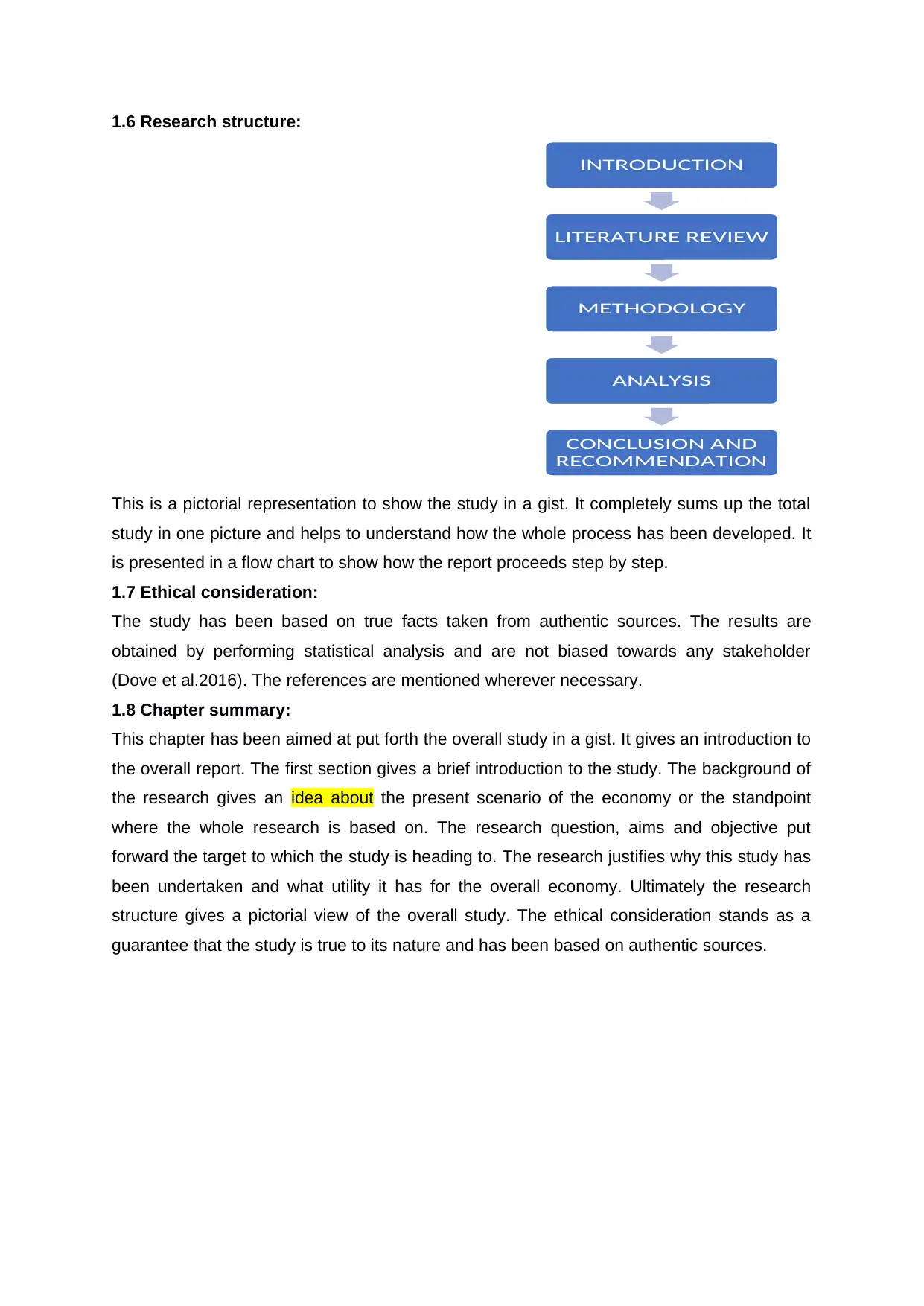
1.6 Research structure:
This is a pictorial representation to show the study in a gist. It completely sums up the total
study in one picture and helps to understand how the whole process has been developed. It
is presented in a flow chart to show how the report proceeds step by step.
1.7 Ethical consideration:
The study has been based on true facts taken from authentic sources. The results are
obtained by performing statistical analysis and are not biased towards any stakeholder
(Dove et al.2016). The references are mentioned wherever necessary.
1.8 Chapter summary:
This chapter has been aimed at put forth the overall study in a gist. It gives an introduction to
the overall report. The first section gives a brief introduction to the study. The background of
the research gives an idea about the present scenario of the economy or the standpoint
where the whole research is based on. The research question, aims and objective put
forward the target to which the study is heading to. The research justifies why this study has
been undertaken and what utility it has for the overall economy. Ultimately the research
structure gives a pictorial view of the overall study. The ethical consideration stands as a
guarantee that the study is true to its nature and has been based on authentic sources.
INTRODUCTION
LITERATURE REVIEW
METHODOLOGY
ANALYSIS
CONCLUSION AND
RECOMMENDATION
This is a pictorial representation to show the study in a gist. It completely sums up the total
study in one picture and helps to understand how the whole process has been developed. It
is presented in a flow chart to show how the report proceeds step by step.
1.7 Ethical consideration:
The study has been based on true facts taken from authentic sources. The results are
obtained by performing statistical analysis and are not biased towards any stakeholder
(Dove et al.2016). The references are mentioned wherever necessary.
1.8 Chapter summary:
This chapter has been aimed at put forth the overall study in a gist. It gives an introduction to
the overall report. The first section gives a brief introduction to the study. The background of
the research gives an idea about the present scenario of the economy or the standpoint
where the whole research is based on. The research question, aims and objective put
forward the target to which the study is heading to. The research justifies why this study has
been undertaken and what utility it has for the overall economy. Ultimately the research
structure gives a pictorial view of the overall study. The ethical consideration stands as a
guarantee that the study is true to its nature and has been based on authentic sources.
INTRODUCTION
LITERATURE REVIEW
METHODOLOGY
ANALYSIS
CONCLUSION AND
RECOMMENDATION
Secure Best Marks with AI Grader
Need help grading? Try our AI Grader for instant feedback on your assignments.
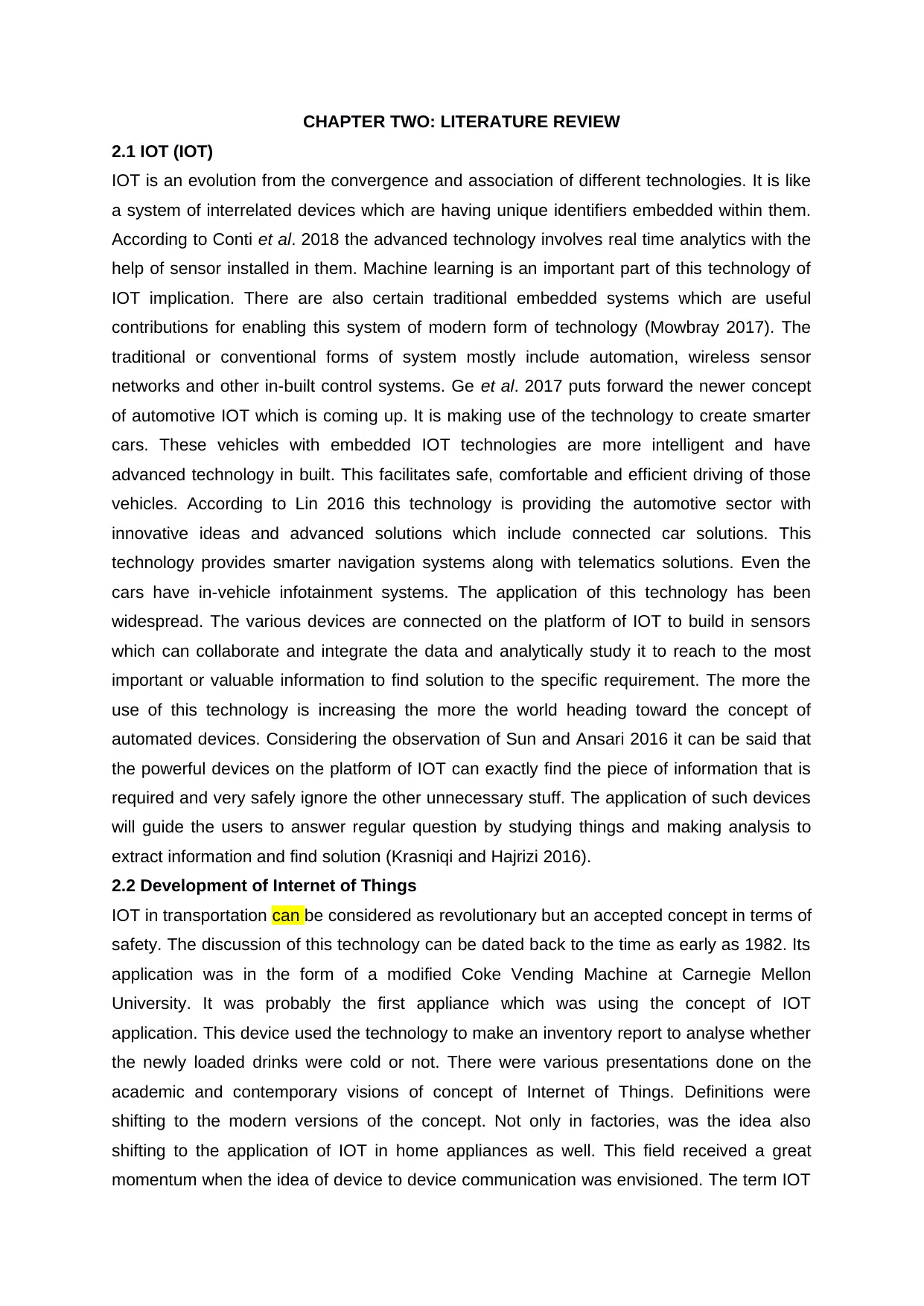
CHAPTER TWO: LITERATURE REVIEW
2.1 IOT (IOT)
IOT is an evolution from the convergence and association of different technologies. It is like
a system of interrelated devices which are having unique identifiers embedded within them.
According to Conti et al. 2018 the advanced technology involves real time analytics with the
help of sensor installed in them. Machine learning is an important part of this technology of
IOT implication. There are also certain traditional embedded systems which are useful
contributions for enabling this system of modern form of technology (Mowbray 2017). The
traditional or conventional forms of system mostly include automation, wireless sensor
networks and other in-built control systems. Ge et al. 2017 puts forward the newer concept
of automotive IOT which is coming up. It is making use of the technology to create smarter
cars. These vehicles with embedded IOT technologies are more intelligent and have
advanced technology in built. This facilitates safe, comfortable and efficient driving of those
vehicles. According to Lin 2016 this technology is providing the automotive sector with
innovative ideas and advanced solutions which include connected car solutions. This
technology provides smarter navigation systems along with telematics solutions. Even the
cars have in-vehicle infotainment systems. The application of this technology has been
widespread. The various devices are connected on the platform of IOT to build in sensors
which can collaborate and integrate the data and analytically study it to reach to the most
important or valuable information to find solution to the specific requirement. The more the
use of this technology is increasing the more the world heading toward the concept of
automated devices. Considering the observation of Sun and Ansari 2016 it can be said that
the powerful devices on the platform of IOT can exactly find the piece of information that is
required and very safely ignore the other unnecessary stuff. The application of such devices
will guide the users to answer regular question by studying things and making analysis to
extract information and find solution (Krasniqi and Hajrizi 2016).
2.2 Development of Internet of Things
IOT in transportation can be considered as revolutionary but an accepted concept in terms of
safety. The discussion of this technology can be dated back to the time as early as 1982. Its
application was in the form of a modified Coke Vending Machine at Carnegie Mellon
University. It was probably the first appliance which was using the concept of IOT
application. This device used the technology to make an inventory report to analyse whether
the newly loaded drinks were cold or not. There were various presentations done on the
academic and contemporary visions of concept of Internet of Things. Definitions were
shifting to the modern versions of the concept. Not only in factories, was the idea also
shifting to the application of IOT in home appliances as well. This field received a great
momentum when the idea of device to device communication was envisioned. The term IOT
2.1 IOT (IOT)
IOT is an evolution from the convergence and association of different technologies. It is like
a system of interrelated devices which are having unique identifiers embedded within them.
According to Conti et al. 2018 the advanced technology involves real time analytics with the
help of sensor installed in them. Machine learning is an important part of this technology of
IOT implication. There are also certain traditional embedded systems which are useful
contributions for enabling this system of modern form of technology (Mowbray 2017). The
traditional or conventional forms of system mostly include automation, wireless sensor
networks and other in-built control systems. Ge et al. 2017 puts forward the newer concept
of automotive IOT which is coming up. It is making use of the technology to create smarter
cars. These vehicles with embedded IOT technologies are more intelligent and have
advanced technology in built. This facilitates safe, comfortable and efficient driving of those
vehicles. According to Lin 2016 this technology is providing the automotive sector with
innovative ideas and advanced solutions which include connected car solutions. This
technology provides smarter navigation systems along with telematics solutions. Even the
cars have in-vehicle infotainment systems. The application of this technology has been
widespread. The various devices are connected on the platform of IOT to build in sensors
which can collaborate and integrate the data and analytically study it to reach to the most
important or valuable information to find solution to the specific requirement. The more the
use of this technology is increasing the more the world heading toward the concept of
automated devices. Considering the observation of Sun and Ansari 2016 it can be said that
the powerful devices on the platform of IOT can exactly find the piece of information that is
required and very safely ignore the other unnecessary stuff. The application of such devices
will guide the users to answer regular question by studying things and making analysis to
extract information and find solution (Krasniqi and Hajrizi 2016).
2.2 Development of Internet of Things
IOT in transportation can be considered as revolutionary but an accepted concept in terms of
safety. The discussion of this technology can be dated back to the time as early as 1982. Its
application was in the form of a modified Coke Vending Machine at Carnegie Mellon
University. It was probably the first appliance which was using the concept of IOT
application. This device used the technology to make an inventory report to analyse whether
the newly loaded drinks were cold or not. There were various presentations done on the
academic and contemporary visions of concept of Internet of Things. Definitions were
shifting to the modern versions of the concept. Not only in factories, was the idea also
shifting to the application of IOT in home appliances as well. This field received a great
momentum when the idea of device to device communication was envisioned. The term IOT
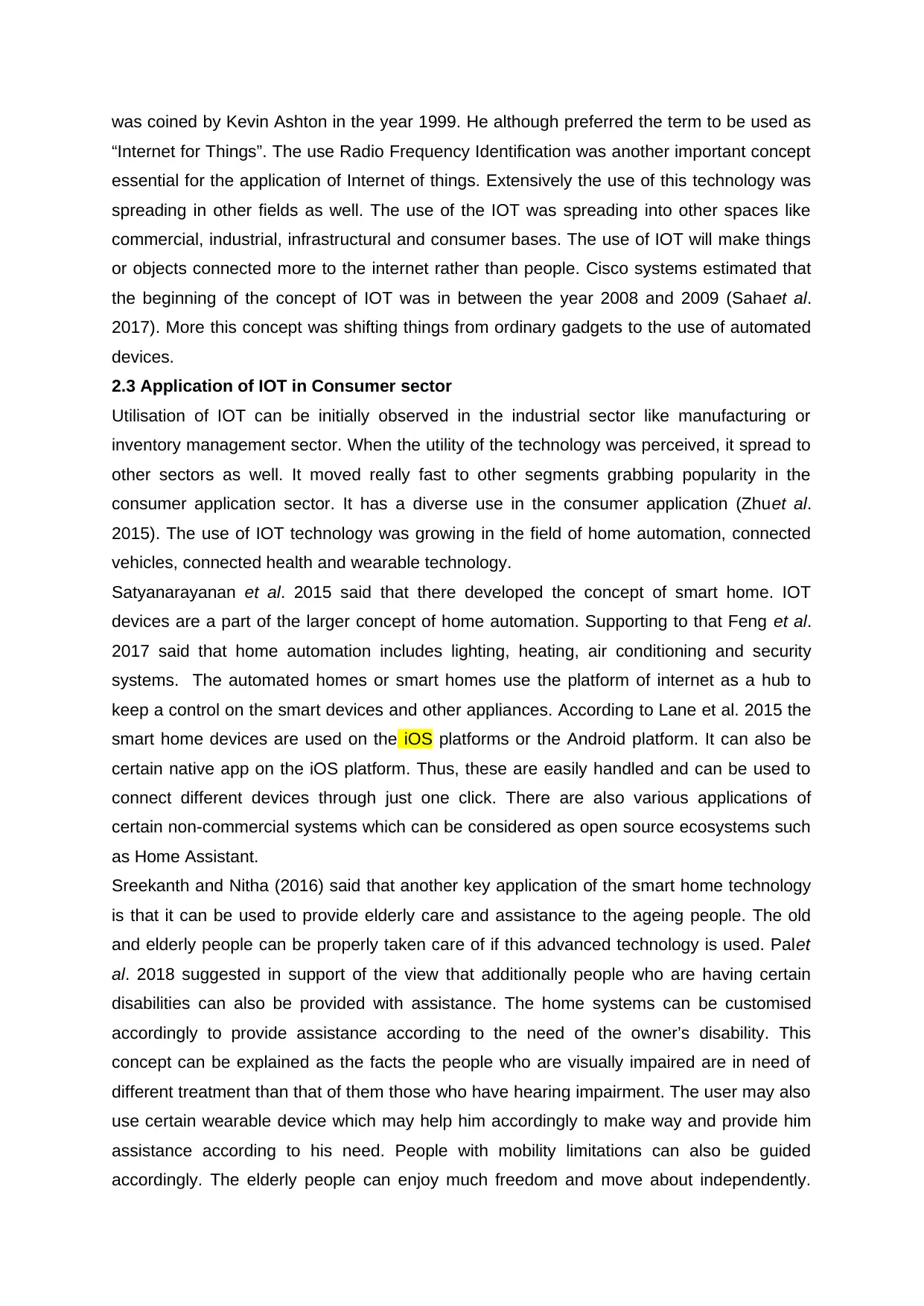
was coined by Kevin Ashton in the year 1999. He although preferred the term to be used as
“Internet for Things”. The use Radio Frequency Identification was another important concept
essential for the application of Internet of things. Extensively the use of this technology was
spreading in other fields as well. The use of the IOT was spreading into other spaces like
commercial, industrial, infrastructural and consumer bases. The use of IOT will make things
or objects connected more to the internet rather than people. Cisco systems estimated that
the beginning of the concept of IOT was in between the year 2008 and 2009 (Sahaet al.
2017). More this concept was shifting things from ordinary gadgets to the use of automated
devices.
2.3 Application of IOT in Consumer sector
Utilisation of IOT can be initially observed in the industrial sector like manufacturing or
inventory management sector. When the utility of the technology was perceived, it spread to
other sectors as well. It moved really fast to other segments grabbing popularity in the
consumer application sector. It has a diverse use in the consumer application (Zhuet al.
2015). The use of IOT technology was growing in the field of home automation, connected
vehicles, connected health and wearable technology.
Satyanarayanan et al. 2015 said that there developed the concept of smart home. IOT
devices are a part of the larger concept of home automation. Supporting to that Feng et al.
2017 said that home automation includes lighting, heating, air conditioning and security
systems. The automated homes or smart homes use the platform of internet as a hub to
keep a control on the smart devices and other appliances. According to Lane et al. 2015 the
smart home devices are used on the iOS platforms or the Android platform. It can also be
certain native app on the iOS platform. Thus, these are easily handled and can be used to
connect different devices through just one click. There are also various applications of
certain non-commercial systems which can be considered as open source ecosystems such
as Home Assistant.
Sreekanth and Nitha (2016) said that another key application of the smart home technology
is that it can be used to provide elderly care and assistance to the ageing people. The old
and elderly people can be properly taken care of if this advanced technology is used. Palet
al. 2018 suggested in support of the view that additionally people who are having certain
disabilities can also be provided with assistance. The home systems can be customised
accordingly to provide assistance according to the need of the owner’s disability. This
concept can be explained as the facts the people who are visually impaired are in need of
different treatment than that of them those who have hearing impairment. The user may also
use certain wearable device which may help him accordingly to make way and provide him
assistance according to his need. People with mobility limitations can also be guided
accordingly. The elderly people can enjoy much freedom and move about independently.
“Internet for Things”. The use Radio Frequency Identification was another important concept
essential for the application of Internet of things. Extensively the use of this technology was
spreading in other fields as well. The use of the IOT was spreading into other spaces like
commercial, industrial, infrastructural and consumer bases. The use of IOT will make things
or objects connected more to the internet rather than people. Cisco systems estimated that
the beginning of the concept of IOT was in between the year 2008 and 2009 (Sahaet al.
2017). More this concept was shifting things from ordinary gadgets to the use of automated
devices.
2.3 Application of IOT in Consumer sector
Utilisation of IOT can be initially observed in the industrial sector like manufacturing or
inventory management sector. When the utility of the technology was perceived, it spread to
other sectors as well. It moved really fast to other segments grabbing popularity in the
consumer application sector. It has a diverse use in the consumer application (Zhuet al.
2015). The use of IOT technology was growing in the field of home automation, connected
vehicles, connected health and wearable technology.
Satyanarayanan et al. 2015 said that there developed the concept of smart home. IOT
devices are a part of the larger concept of home automation. Supporting to that Feng et al.
2017 said that home automation includes lighting, heating, air conditioning and security
systems. The automated homes or smart homes use the platform of internet as a hub to
keep a control on the smart devices and other appliances. According to Lane et al. 2015 the
smart home devices are used on the iOS platforms or the Android platform. It can also be
certain native app on the iOS platform. Thus, these are easily handled and can be used to
connect different devices through just one click. There are also various applications of
certain non-commercial systems which can be considered as open source ecosystems such
as Home Assistant.
Sreekanth and Nitha (2016) said that another key application of the smart home technology
is that it can be used to provide elderly care and assistance to the ageing people. The old
and elderly people can be properly taken care of if this advanced technology is used. Palet
al. 2018 suggested in support of the view that additionally people who are having certain
disabilities can also be provided with assistance. The home systems can be customised
accordingly to provide assistance according to the need of the owner’s disability. This
concept can be explained as the facts the people who are visually impaired are in need of
different treatment than that of them those who have hearing impairment. The user may also
use certain wearable device which may help him accordingly to make way and provide him
assistance according to his need. People with mobility limitations can also be guided
accordingly. The elderly people can enjoy much freedom and move about independently.
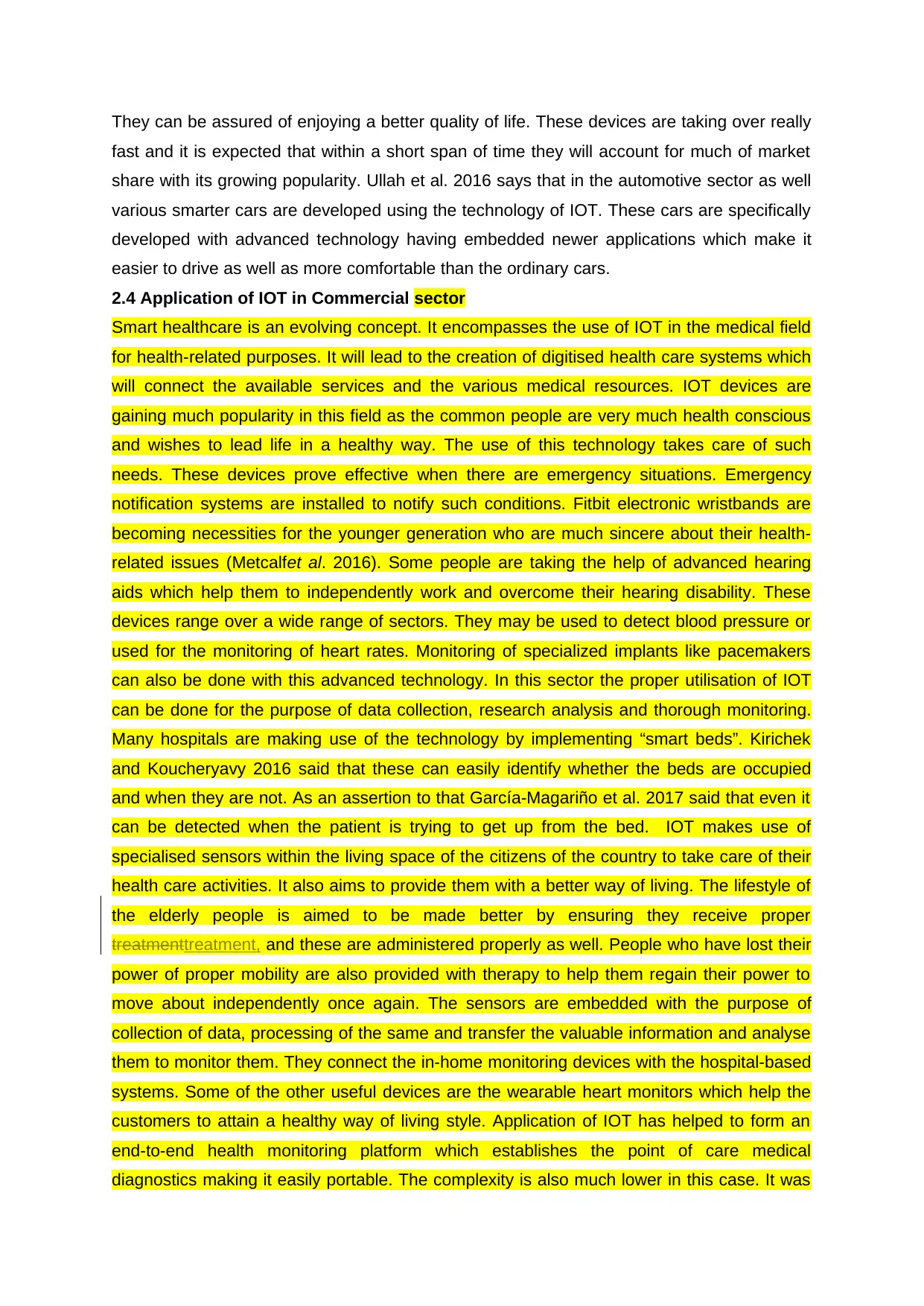
They can be assured of enjoying a better quality of life. These devices are taking over really
fast and it is expected that within a short span of time they will account for much of market
share with its growing popularity. Ullah et al. 2016 says that in the automotive sector as well
various smarter cars are developed using the technology of IOT. These cars are specifically
developed with advanced technology having embedded newer applications which make it
easier to drive as well as more comfortable than the ordinary cars.
2.4 Application of IOT in Commercial sector
Smart healthcare is an evolving concept. It encompasses the use of IOT in the medical field
for health-related purposes. It will lead to the creation of digitised health care systems which
will connect the available services and the various medical resources. IOT devices are
gaining much popularity in this field as the common people are very much health conscious
and wishes to lead life in a healthy way. The use of this technology takes care of such
needs. These devices prove effective when there are emergency situations. Emergency
notification systems are installed to notify such conditions. Fitbit electronic wristbands are
becoming necessities for the younger generation who are much sincere about their health-
related issues (Metcalfet al. 2016). Some people are taking the help of advanced hearing
aids which help them to independently work and overcome their hearing disability. These
devices range over a wide range of sectors. They may be used to detect blood pressure or
used for the monitoring of heart rates. Monitoring of specialized implants like pacemakers
can also be done with this advanced technology. In this sector the proper utilisation of IOT
can be done for the purpose of data collection, research analysis and thorough monitoring.
Many hospitals are making use of the technology by implementing “smart beds”. Kirichek
and Koucheryavy 2016 said that these can easily identify whether the beds are occupied
and when they are not. As an assertion to that García-Magariño et al. 2017 said that even it
can be detected when the patient is trying to get up from the bed. IOT makes use of
specialised sensors within the living space of the citizens of the country to take care of their
health care activities. It also aims to provide them with a better way of living. The lifestyle of
the elderly people is aimed to be made better by ensuring they receive proper
treatmenttreatment, and these are administered properly as well. People who have lost their
power of proper mobility are also provided with therapy to help them regain their power to
move about independently once again. The sensors are embedded with the purpose of
collection of data, processing of the same and transfer the valuable information and analyse
them to monitor them. They connect the in-home monitoring devices with the hospital-based
systems. Some of the other useful devices are the wearable heart monitors which help the
customers to attain a healthy way of living style. Application of IOT has helped to form an
end-to-end health monitoring platform which establishes the point of care medical
diagnostics making it easily portable. The complexity is also much lower in this case. It was
fast and it is expected that within a short span of time they will account for much of market
share with its growing popularity. Ullah et al. 2016 says that in the automotive sector as well
various smarter cars are developed using the technology of IOT. These cars are specifically
developed with advanced technology having embedded newer applications which make it
easier to drive as well as more comfortable than the ordinary cars.
2.4 Application of IOT in Commercial sector
Smart healthcare is an evolving concept. It encompasses the use of IOT in the medical field
for health-related purposes. It will lead to the creation of digitised health care systems which
will connect the available services and the various medical resources. IOT devices are
gaining much popularity in this field as the common people are very much health conscious
and wishes to lead life in a healthy way. The use of this technology takes care of such
needs. These devices prove effective when there are emergency situations. Emergency
notification systems are installed to notify such conditions. Fitbit electronic wristbands are
becoming necessities for the younger generation who are much sincere about their health-
related issues (Metcalfet al. 2016). Some people are taking the help of advanced hearing
aids which help them to independently work and overcome their hearing disability. These
devices range over a wide range of sectors. They may be used to detect blood pressure or
used for the monitoring of heart rates. Monitoring of specialized implants like pacemakers
can also be done with this advanced technology. In this sector the proper utilisation of IOT
can be done for the purpose of data collection, research analysis and thorough monitoring.
Many hospitals are making use of the technology by implementing “smart beds”. Kirichek
and Koucheryavy 2016 said that these can easily identify whether the beds are occupied
and when they are not. As an assertion to that García-Magariño et al. 2017 said that even it
can be detected when the patient is trying to get up from the bed. IOT makes use of
specialised sensors within the living space of the citizens of the country to take care of their
health care activities. It also aims to provide them with a better way of living. The lifestyle of
the elderly people is aimed to be made better by ensuring they receive proper
treatmenttreatment, and these are administered properly as well. People who have lost their
power of proper mobility are also provided with therapy to help them regain their power to
move about independently once again. The sensors are embedded with the purpose of
collection of data, processing of the same and transfer the valuable information and analyse
them to monitor them. They connect the in-home monitoring devices with the hospital-based
systems. Some of the other useful devices are the wearable heart monitors which help the
customers to attain a healthy way of living style. Application of IOT has helped to form an
end-to-end health monitoring platform which establishes the point of care medical
diagnostics making it easily portable. The complexity is also much lower in this case. It was
Paraphrase This Document
Need a fresh take? Get an instant paraphrase of this document with our AI Paraphraser
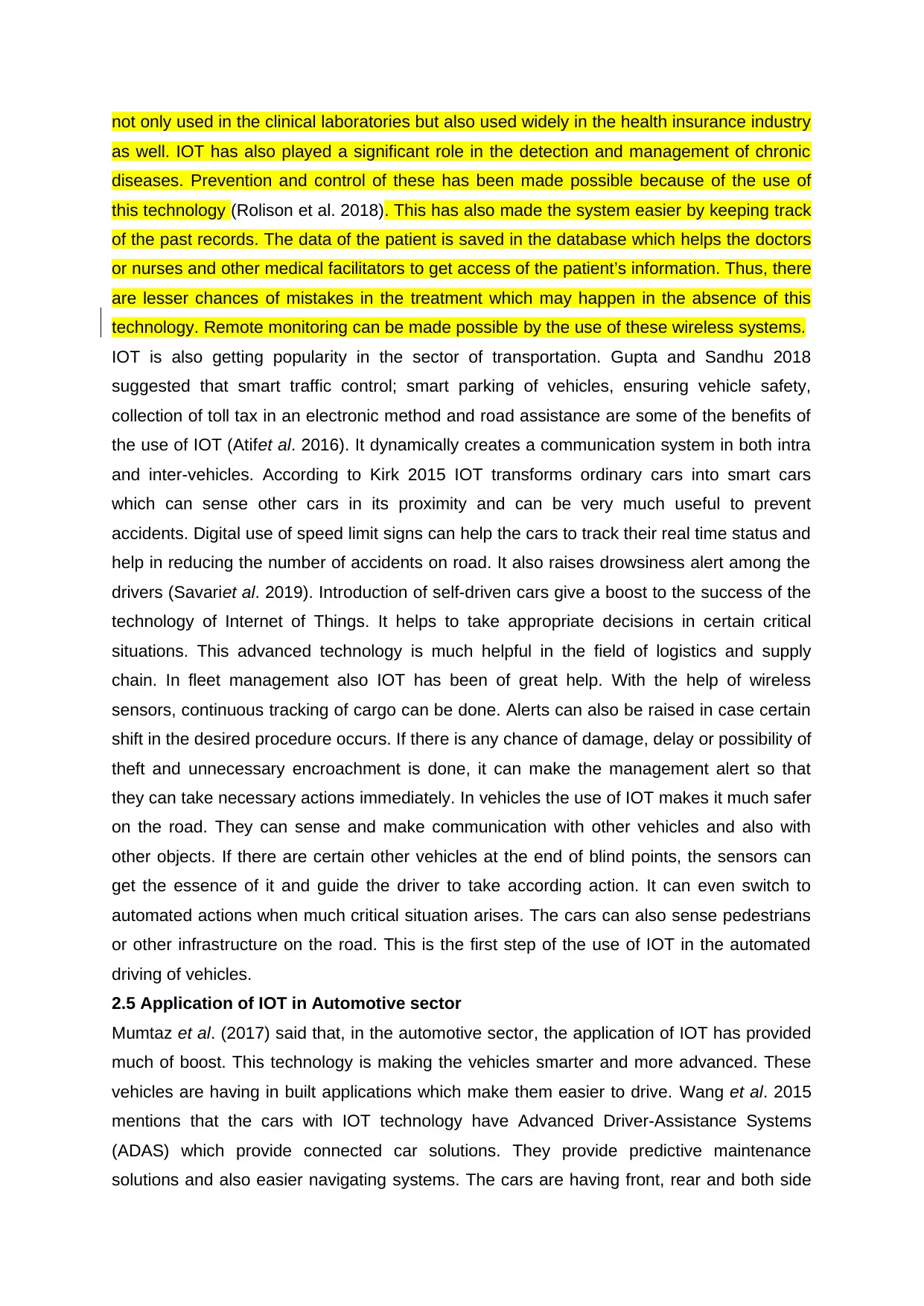
not only used in the clinical laboratories but also used widely in the health insurance industry
as well. IOT has also played a significant role in the detection and management of chronic
diseases. Prevention and control of these has been made possible because of the use of
this technology (Rolison et al. 2018). This has also made the system easier by keeping track
of the past records. The data of the patient is saved in the database which helps the doctors
or nurses and other medical facilitators to get access of the patient’s information. Thus, there
are lesser chances of mistakes in the treatment which may happen in the absence of this
technology. Remote monitoring can be made possible by the use of these wireless systems.
IOT is also getting popularity in the sector of transportation. Gupta and Sandhu 2018
suggested that smart traffic control; smart parking of vehicles, ensuring vehicle safety,
collection of toll tax in an electronic method and road assistance are some of the benefits of
the use of IOT (Atifet al. 2016). It dynamically creates a communication system in both intra
and inter-vehicles. According to Kirk 2015 IOT transforms ordinary cars into smart cars
which can sense other cars in its proximity and can be very much useful to prevent
accidents. Digital use of speed limit signs can help the cars to track their real time status and
help in reducing the number of accidents on road. It also raises drowsiness alert among the
drivers (Savariet al. 2019). Introduction of self-driven cars give a boost to the success of the
technology of Internet of Things. It helps to take appropriate decisions in certain critical
situations. This advanced technology is much helpful in the field of logistics and supply
chain. In fleet management also IOT has been of great help. With the help of wireless
sensors, continuous tracking of cargo can be done. Alerts can also be raised in case certain
shift in the desired procedure occurs. If there is any chance of damage, delay or possibility of
theft and unnecessary encroachment is done, it can make the management alert so that
they can take necessary actions immediately. In vehicles the use of IOT makes it much safer
on the road. They can sense and make communication with other vehicles and also with
other objects. If there are certain other vehicles at the end of blind points, the sensors can
get the essence of it and guide the driver to take according action. It can even switch to
automated actions when much critical situation arises. The cars can also sense pedestrians
or other infrastructure on the road. This is the first step of the use of IOT in the automated
driving of vehicles.
2.5 Application of IOT in Automotive sector
Mumtaz et al. (2017) said that, in the automotive sector, the application of IOT has provided
much of boost. This technology is making the vehicles smarter and more advanced. These
vehicles are having in built applications which make them easier to drive. Wang et al. 2015
mentions that the cars with IOT technology have Advanced Driver-Assistance Systems
(ADAS) which provide connected car solutions. They provide predictive maintenance
solutions and also easier navigating systems. The cars are having front, rear and both side
as well. IOT has also played a significant role in the detection and management of chronic
diseases. Prevention and control of these has been made possible because of the use of
this technology (Rolison et al. 2018). This has also made the system easier by keeping track
of the past records. The data of the patient is saved in the database which helps the doctors
or nurses and other medical facilitators to get access of the patient’s information. Thus, there
are lesser chances of mistakes in the treatment which may happen in the absence of this
technology. Remote monitoring can be made possible by the use of these wireless systems.
IOT is also getting popularity in the sector of transportation. Gupta and Sandhu 2018
suggested that smart traffic control; smart parking of vehicles, ensuring vehicle safety,
collection of toll tax in an electronic method and road assistance are some of the benefits of
the use of IOT (Atifet al. 2016). It dynamically creates a communication system in both intra
and inter-vehicles. According to Kirk 2015 IOT transforms ordinary cars into smart cars
which can sense other cars in its proximity and can be very much useful to prevent
accidents. Digital use of speed limit signs can help the cars to track their real time status and
help in reducing the number of accidents on road. It also raises drowsiness alert among the
drivers (Savariet al. 2019). Introduction of self-driven cars give a boost to the success of the
technology of Internet of Things. It helps to take appropriate decisions in certain critical
situations. This advanced technology is much helpful in the field of logistics and supply
chain. In fleet management also IOT has been of great help. With the help of wireless
sensors, continuous tracking of cargo can be done. Alerts can also be raised in case certain
shift in the desired procedure occurs. If there is any chance of damage, delay or possibility of
theft and unnecessary encroachment is done, it can make the management alert so that
they can take necessary actions immediately. In vehicles the use of IOT makes it much safer
on the road. They can sense and make communication with other vehicles and also with
other objects. If there are certain other vehicles at the end of blind points, the sensors can
get the essence of it and guide the driver to take according action. It can even switch to
automated actions when much critical situation arises. The cars can also sense pedestrians
or other infrastructure on the road. This is the first step of the use of IOT in the automated
driving of vehicles.
2.5 Application of IOT in Automotive sector
Mumtaz et al. (2017) said that, in the automotive sector, the application of IOT has provided
much of boost. This technology is making the vehicles smarter and more advanced. These
vehicles are having in built applications which make them easier to drive. Wang et al. 2015
mentions that the cars with IOT technology have Advanced Driver-Assistance Systems
(ADAS) which provide connected car solutions. They provide predictive maintenance
solutions and also easier navigating systems. The cars are having front, rear and both side
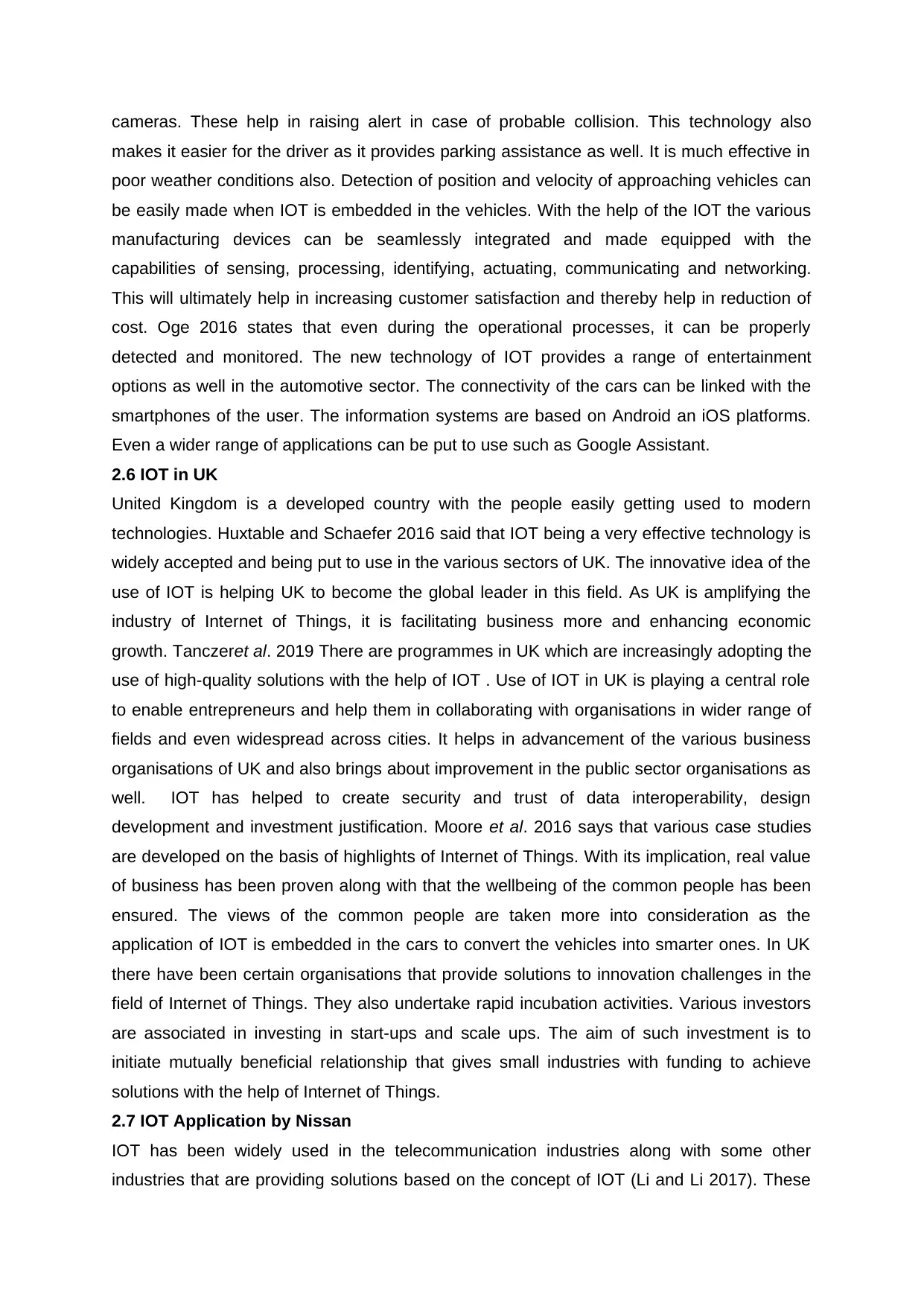
cameras. These help in raising alert in case of probable collision. This technology also
makes it easier for the driver as it provides parking assistance as well. It is much effective in
poor weather conditions also. Detection of position and velocity of approaching vehicles can
be easily made when IOT is embedded in the vehicles. With the help of the IOT the various
manufacturing devices can be seamlessly integrated and made equipped with the
capabilities of sensing, processing, identifying, actuating, communicating and networking.
This will ultimately help in increasing customer satisfaction and thereby help in reduction of
cost. Oge 2016 states that even during the operational processes, it can be properly
detected and monitored. The new technology of IOT provides a range of entertainment
options as well in the automotive sector. The connectivity of the cars can be linked with the
smartphones of the user. The information systems are based on Android an iOS platforms.
Even a wider range of applications can be put to use such as Google Assistant.
2.6 IOT in UK
United Kingdom is a developed country with the people easily getting used to modern
technologies. Huxtable and Schaefer 2016 said that IOT being a very effective technology is
widely accepted and being put to use in the various sectors of UK. The innovative idea of the
use of IOT is helping UK to become the global leader in this field. As UK is amplifying the
industry of Internet of Things, it is facilitating business more and enhancing economic
growth. Tanczeret al. 2019 There are programmes in UK which are increasingly adopting the
use of high-quality solutions with the help of IOT . Use of IOT in UK is playing a central role
to enable entrepreneurs and help them in collaborating with organisations in wider range of
fields and even widespread across cities. It helps in advancement of the various business
organisations of UK and also brings about improvement in the public sector organisations as
well. IOT has helped to create security and trust of data interoperability, design
development and investment justification. Moore et al. 2016 says that various case studies
are developed on the basis of highlights of Internet of Things. With its implication, real value
of business has been proven along with that the wellbeing of the common people has been
ensured. The views of the common people are taken more into consideration as the
application of IOT is embedded in the cars to convert the vehicles into smarter ones. In UK
there have been certain organisations that provide solutions to innovation challenges in the
field of Internet of Things. They also undertake rapid incubation activities. Various investors
are associated in investing in start-ups and scale ups. The aim of such investment is to
initiate mutually beneficial relationship that gives small industries with funding to achieve
solutions with the help of Internet of Things.
2.7 IOT Application by Nissan
IOT has been widely used in the telecommunication industries along with some other
industries that are providing solutions based on the concept of IOT (Li and Li 2017). These
makes it easier for the driver as it provides parking assistance as well. It is much effective in
poor weather conditions also. Detection of position and velocity of approaching vehicles can
be easily made when IOT is embedded in the vehicles. With the help of the IOT the various
manufacturing devices can be seamlessly integrated and made equipped with the
capabilities of sensing, processing, identifying, actuating, communicating and networking.
This will ultimately help in increasing customer satisfaction and thereby help in reduction of
cost. Oge 2016 states that even during the operational processes, it can be properly
detected and monitored. The new technology of IOT provides a range of entertainment
options as well in the automotive sector. The connectivity of the cars can be linked with the
smartphones of the user. The information systems are based on Android an iOS platforms.
Even a wider range of applications can be put to use such as Google Assistant.
2.6 IOT in UK
United Kingdom is a developed country with the people easily getting used to modern
technologies. Huxtable and Schaefer 2016 said that IOT being a very effective technology is
widely accepted and being put to use in the various sectors of UK. The innovative idea of the
use of IOT is helping UK to become the global leader in this field. As UK is amplifying the
industry of Internet of Things, it is facilitating business more and enhancing economic
growth. Tanczeret al. 2019 There are programmes in UK which are increasingly adopting the
use of high-quality solutions with the help of IOT . Use of IOT in UK is playing a central role
to enable entrepreneurs and help them in collaborating with organisations in wider range of
fields and even widespread across cities. It helps in advancement of the various business
organisations of UK and also brings about improvement in the public sector organisations as
well. IOT has helped to create security and trust of data interoperability, design
development and investment justification. Moore et al. 2016 says that various case studies
are developed on the basis of highlights of Internet of Things. With its implication, real value
of business has been proven along with that the wellbeing of the common people has been
ensured. The views of the common people are taken more into consideration as the
application of IOT is embedded in the cars to convert the vehicles into smarter ones. In UK
there have been certain organisations that provide solutions to innovation challenges in the
field of Internet of Things. They also undertake rapid incubation activities. Various investors
are associated in investing in start-ups and scale ups. The aim of such investment is to
initiate mutually beneficial relationship that gives small industries with funding to achieve
solutions with the help of Internet of Things.
2.7 IOT Application by Nissan
IOT has been widely used in the telecommunication industries along with some other
industries that are providing solutions based on the concept of IOT (Li and Li 2017). These
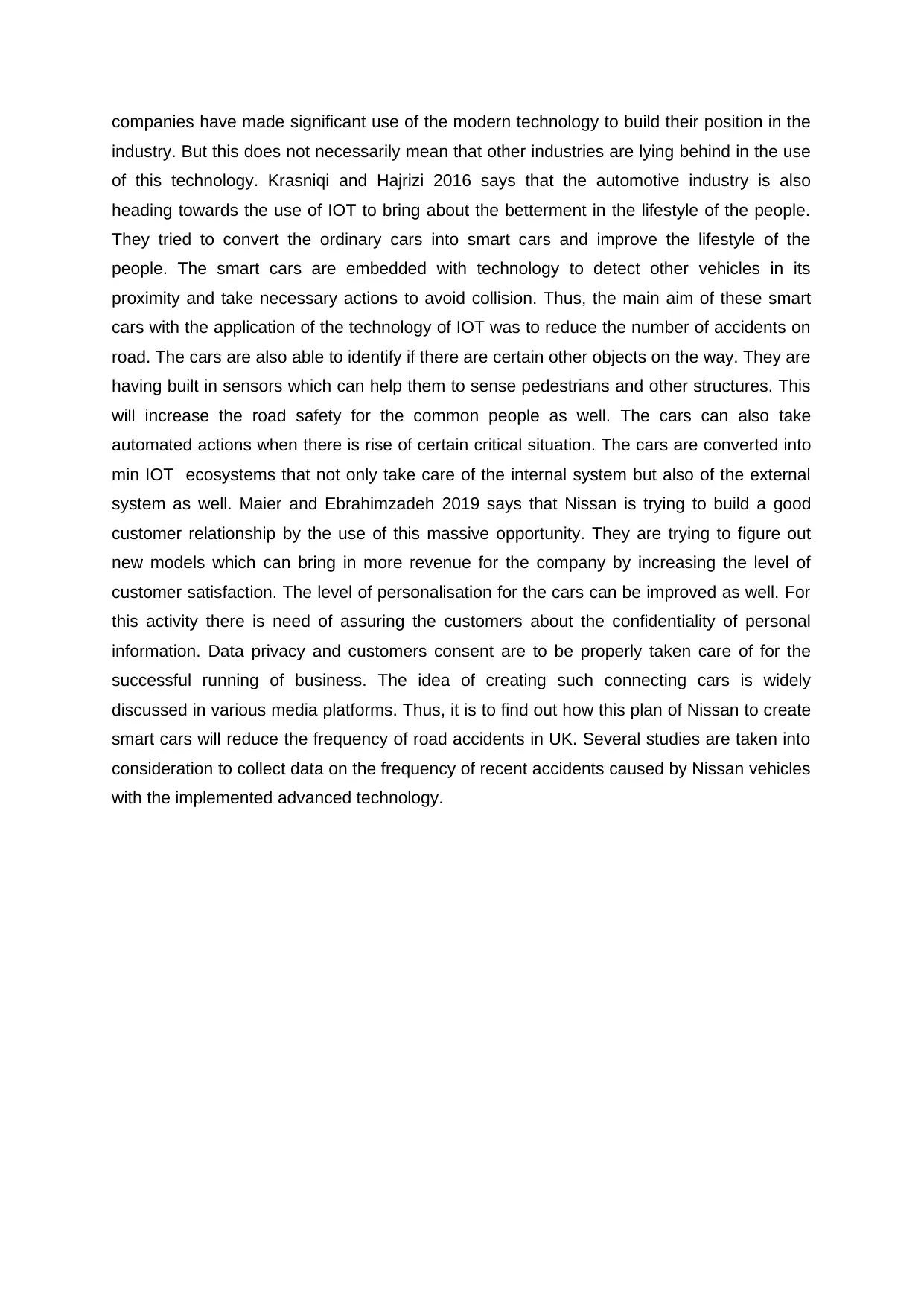
companies have made significant use of the modern technology to build their position in the
industry. But this does not necessarily mean that other industries are lying behind in the use
of this technology. Krasniqi and Hajrizi 2016 says that the automotive industry is also
heading towards the use of IOT to bring about the betterment in the lifestyle of the people.
They tried to convert the ordinary cars into smart cars and improve the lifestyle of the
people. The smart cars are embedded with technology to detect other vehicles in its
proximity and take necessary actions to avoid collision. Thus, the main aim of these smart
cars with the application of the technology of IOT was to reduce the number of accidents on
road. The cars are also able to identify if there are certain other objects on the way. They are
having built in sensors which can help them to sense pedestrians and other structures. This
will increase the road safety for the common people as well. The cars can also take
automated actions when there is rise of certain critical situation. The cars are converted into
min IOT ecosystems that not only take care of the internal system but also of the external
system as well. Maier and Ebrahimzadeh 2019 says that Nissan is trying to build a good
customer relationship by the use of this massive opportunity. They are trying to figure out
new models which can bring in more revenue for the company by increasing the level of
customer satisfaction. The level of personalisation for the cars can be improved as well. For
this activity there is need of assuring the customers about the confidentiality of personal
information. Data privacy and customers consent are to be properly taken care of for the
successful running of business. The idea of creating such connecting cars is widely
discussed in various media platforms. Thus, it is to find out how this plan of Nissan to create
smart cars will reduce the frequency of road accidents in UK. Several studies are taken into
consideration to collect data on the frequency of recent accidents caused by Nissan vehicles
with the implemented advanced technology.
industry. But this does not necessarily mean that other industries are lying behind in the use
of this technology. Krasniqi and Hajrizi 2016 says that the automotive industry is also
heading towards the use of IOT to bring about the betterment in the lifestyle of the people.
They tried to convert the ordinary cars into smart cars and improve the lifestyle of the
people. The smart cars are embedded with technology to detect other vehicles in its
proximity and take necessary actions to avoid collision. Thus, the main aim of these smart
cars with the application of the technology of IOT was to reduce the number of accidents on
road. The cars are also able to identify if there are certain other objects on the way. They are
having built in sensors which can help them to sense pedestrians and other structures. This
will increase the road safety for the common people as well. The cars can also take
automated actions when there is rise of certain critical situation. The cars are converted into
min IOT ecosystems that not only take care of the internal system but also of the external
system as well. Maier and Ebrahimzadeh 2019 says that Nissan is trying to build a good
customer relationship by the use of this massive opportunity. They are trying to figure out
new models which can bring in more revenue for the company by increasing the level of
customer satisfaction. The level of personalisation for the cars can be improved as well. For
this activity there is need of assuring the customers about the confidentiality of personal
information. Data privacy and customers consent are to be properly taken care of for the
successful running of business. The idea of creating such connecting cars is widely
discussed in various media platforms. Thus, it is to find out how this plan of Nissan to create
smart cars will reduce the frequency of road accidents in UK. Several studies are taken into
consideration to collect data on the frequency of recent accidents caused by Nissan vehicles
with the implemented advanced technology.
Secure Best Marks with AI Grader
Need help grading? Try our AI Grader for instant feedback on your assignments.
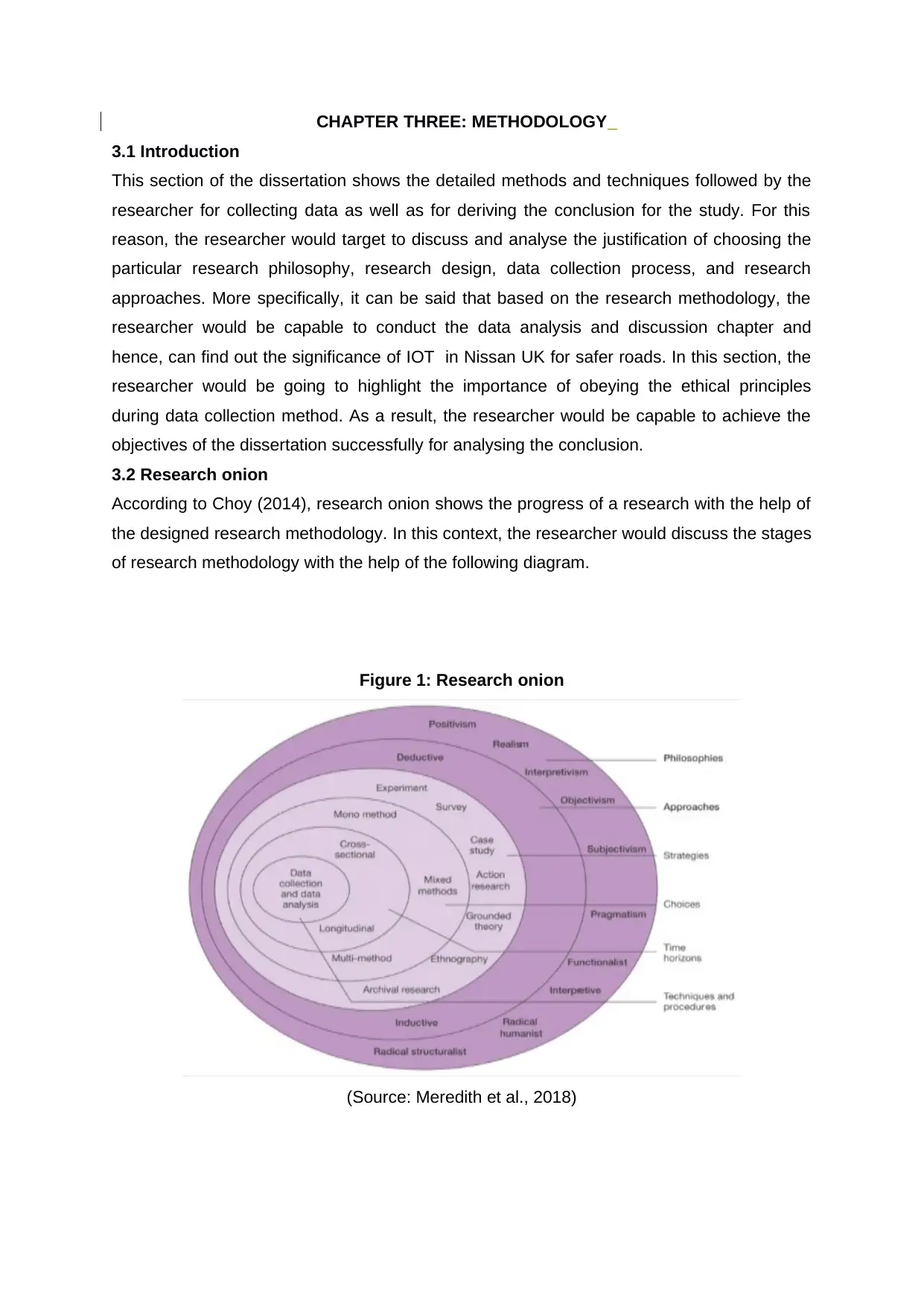
CHAPTER THREE: METHODOLOGY
3.1 Introduction
This section of the dissertation shows the detailed methods and techniques followed by the
researcher for collecting data as well as for deriving the conclusion for the study. For this
reason, the researcher would target to discuss and analyse the justification of choosing the
particular research philosophy, research design, data collection process, and research
approaches. More specifically, it can be said that based on the research methodology, the
researcher would be capable to conduct the data analysis and discussion chapter and
hence, can find out the significance of IOT in Nissan UK for safer roads. In this section, the
researcher would be going to highlight the importance of obeying the ethical principles
during data collection method. As a result, the researcher would be capable to achieve the
objectives of the dissertation successfully for analysing the conclusion.
3.2 Research onion
According to Choy (2014), research onion shows the progress of a research with the help of
the designed research methodology. In this context, the researcher would discuss the stages
of research methodology with the help of the following diagram.
Figure 1: Research onion
(Source: Meredith et al., 2018)
3.1 Introduction
This section of the dissertation shows the detailed methods and techniques followed by the
researcher for collecting data as well as for deriving the conclusion for the study. For this
reason, the researcher would target to discuss and analyse the justification of choosing the
particular research philosophy, research design, data collection process, and research
approaches. More specifically, it can be said that based on the research methodology, the
researcher would be capable to conduct the data analysis and discussion chapter and
hence, can find out the significance of IOT in Nissan UK for safer roads. In this section, the
researcher would be going to highlight the importance of obeying the ethical principles
during data collection method. As a result, the researcher would be capable to achieve the
objectives of the dissertation successfully for analysing the conclusion.
3.2 Research onion
According to Choy (2014), research onion shows the progress of a research with the help of
the designed research methodology. In this context, the researcher would discuss the stages
of research methodology with the help of the following diagram.
Figure 1: Research onion
(Source: Meredith et al., 2018)
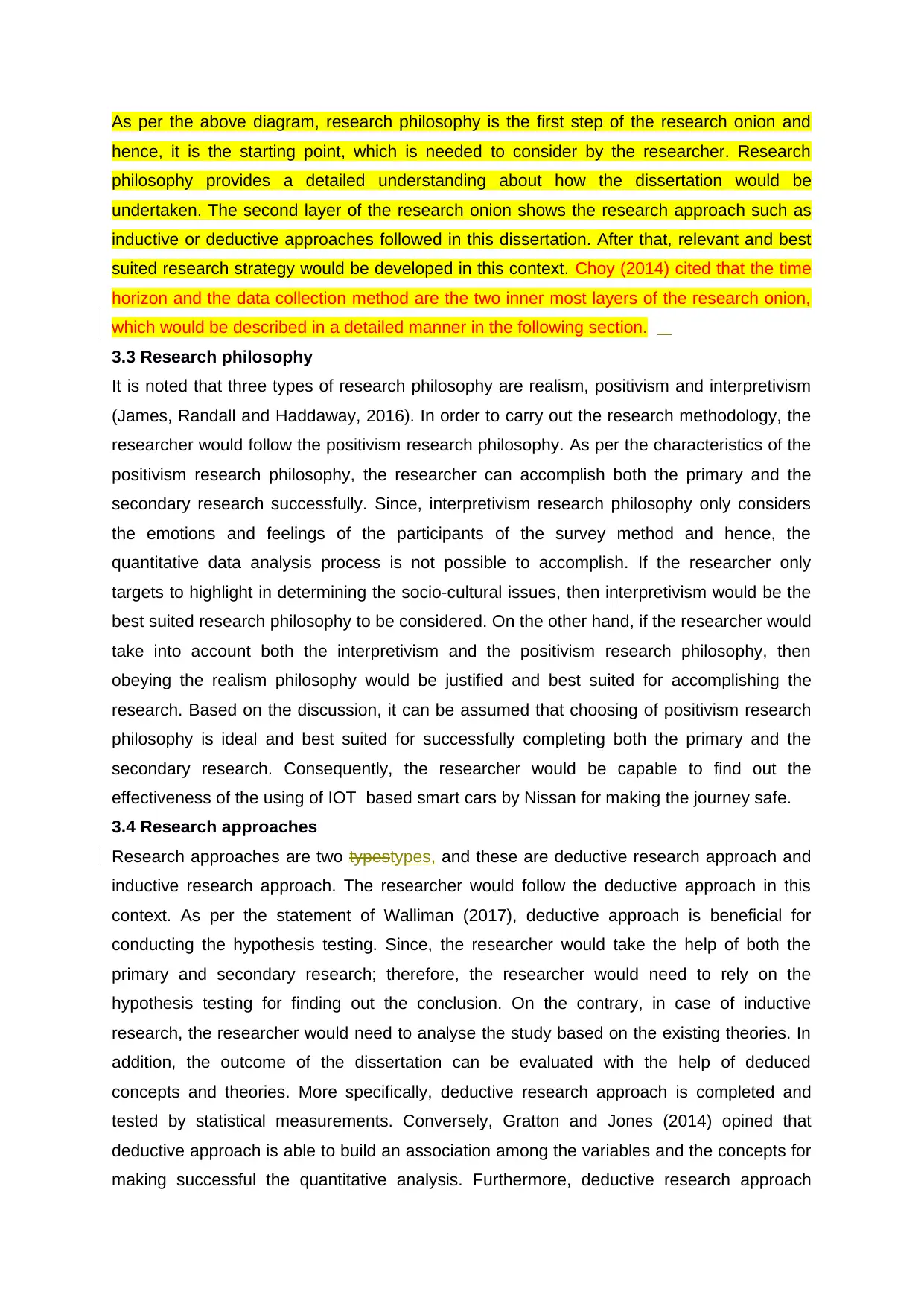
As per the above diagram, research philosophy is the first step of the research onion and
hence, it is the starting point, which is needed to consider by the researcher. Research
philosophy provides a detailed understanding about how the dissertation would be
undertaken. The second layer of the research onion shows the research approach such as
inductive or deductive approaches followed in this dissertation. After that, relevant and best
suited research strategy would be developed in this context. Choy (2014) cited that the time
horizon and the data collection method are the two inner most layers of the research onion,
which would be described in a detailed manner in the following section.
3.3 Research philosophy
It is noted that three types of research philosophy are realism, positivism and interpretivism
(James, Randall and Haddaway, 2016). In order to carry out the research methodology, the
researcher would follow the positivism research philosophy. As per the characteristics of the
positivism research philosophy, the researcher can accomplish both the primary and the
secondary research successfully. Since, interpretivism research philosophy only considers
the emotions and feelings of the participants of the survey method and hence, the
quantitative data analysis process is not possible to accomplish. If the researcher only
targets to highlight in determining the socio-cultural issues, then interpretivism would be the
best suited research philosophy to be considered. On the other hand, if the researcher would
take into account both the interpretivism and the positivism research philosophy, then
obeying the realism philosophy would be justified and best suited for accomplishing the
research. Based on the discussion, it can be assumed that choosing of positivism research
philosophy is ideal and best suited for successfully completing both the primary and the
secondary research. Consequently, the researcher would be capable to find out the
effectiveness of the using of IOT based smart cars by Nissan for making the journey safe.
3.4 Research approaches
Research approaches are two typestypes, and these are deductive research approach and
inductive research approach. The researcher would follow the deductive approach in this
context. As per the statement of Walliman (2017), deductive approach is beneficial for
conducting the hypothesis testing. Since, the researcher would take the help of both the
primary and secondary research; therefore, the researcher would need to rely on the
hypothesis testing for finding out the conclusion. On the contrary, in case of inductive
research, the researcher would need to analyse the study based on the existing theories. In
addition, the outcome of the dissertation can be evaluated with the help of deduced
concepts and theories. More specifically, deductive research approach is completed and
tested by statistical measurements. Conversely, Gratton and Jones (2014) opined that
deductive approach is able to build an association among the variables and the concepts for
making successful the quantitative analysis. Furthermore, deductive research approach
hence, it is the starting point, which is needed to consider by the researcher. Research
philosophy provides a detailed understanding about how the dissertation would be
undertaken. The second layer of the research onion shows the research approach such as
inductive or deductive approaches followed in this dissertation. After that, relevant and best
suited research strategy would be developed in this context. Choy (2014) cited that the time
horizon and the data collection method are the two inner most layers of the research onion,
which would be described in a detailed manner in the following section.
3.3 Research philosophy
It is noted that three types of research philosophy are realism, positivism and interpretivism
(James, Randall and Haddaway, 2016). In order to carry out the research methodology, the
researcher would follow the positivism research philosophy. As per the characteristics of the
positivism research philosophy, the researcher can accomplish both the primary and the
secondary research successfully. Since, interpretivism research philosophy only considers
the emotions and feelings of the participants of the survey method and hence, the
quantitative data analysis process is not possible to accomplish. If the researcher only
targets to highlight in determining the socio-cultural issues, then interpretivism would be the
best suited research philosophy to be considered. On the other hand, if the researcher would
take into account both the interpretivism and the positivism research philosophy, then
obeying the realism philosophy would be justified and best suited for accomplishing the
research. Based on the discussion, it can be assumed that choosing of positivism research
philosophy is ideal and best suited for successfully completing both the primary and the
secondary research. Consequently, the researcher would be capable to find out the
effectiveness of the using of IOT based smart cars by Nissan for making the journey safe.
3.4 Research approaches
Research approaches are two typestypes, and these are deductive research approach and
inductive research approach. The researcher would follow the deductive approach in this
context. As per the statement of Walliman (2017), deductive approach is beneficial for
conducting the hypothesis testing. Since, the researcher would take the help of both the
primary and secondary research; therefore, the researcher would need to rely on the
hypothesis testing for finding out the conclusion. On the contrary, in case of inductive
research, the researcher would need to analyse the study based on the existing theories. In
addition, the outcome of the dissertation can be evaluated with the help of deduced
concepts and theories. More specifically, deductive research approach is completed and
tested by statistical measurements. Conversely, Gratton and Jones (2014) opined that
deductive approach is able to build an association among the variables and the concepts for
making successful the quantitative analysis. Furthermore, deductive research approach
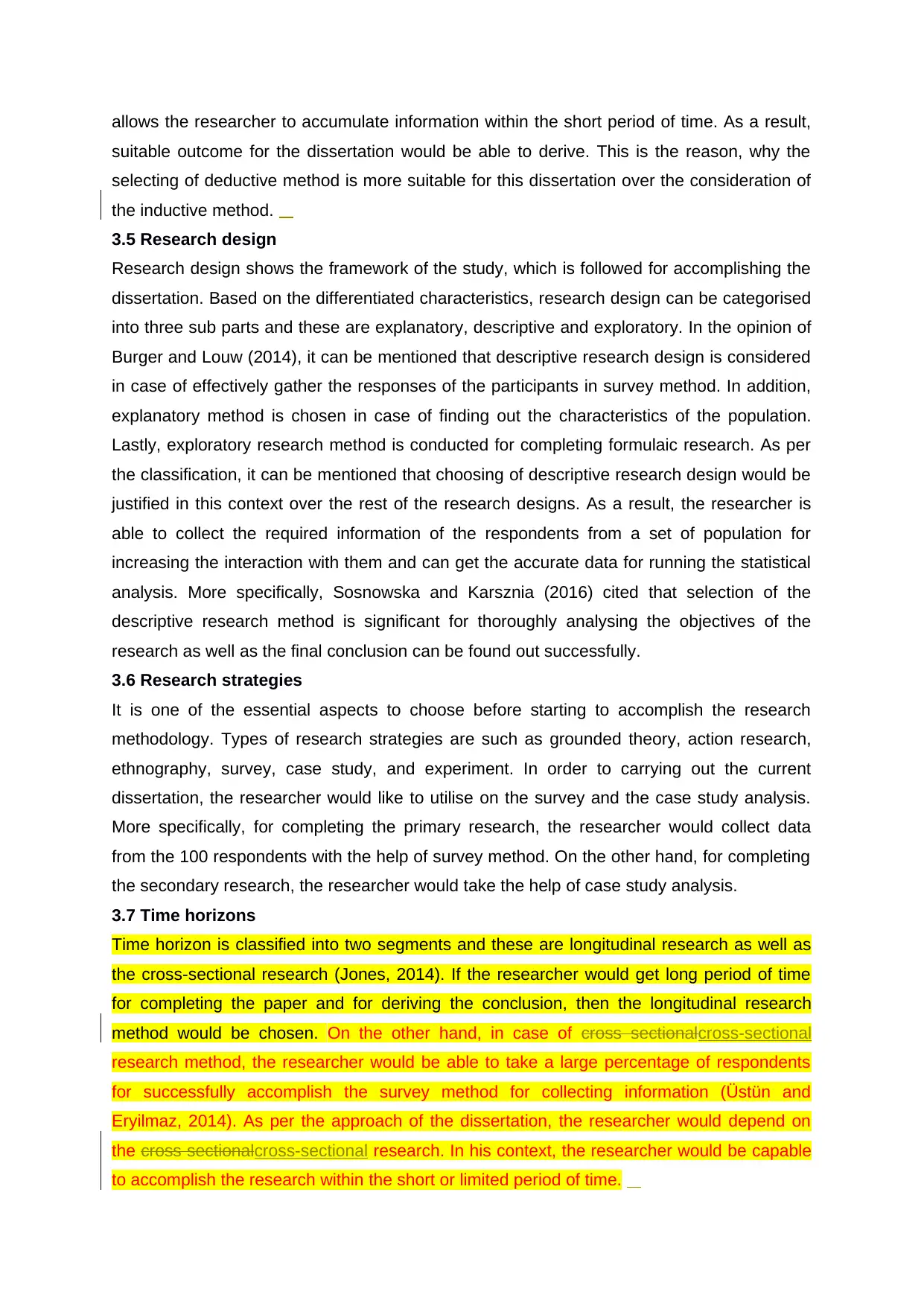
allows the researcher to accumulate information within the short period of time. As a result,
suitable outcome for the dissertation would be able to derive. This is the reason, why the
selecting of deductive method is more suitable for this dissertation over the consideration of
the inductive method.
3.5 Research design
Research design shows the framework of the study, which is followed for accomplishing the
dissertation. Based on the differentiated characteristics, research design can be categorised
into three sub parts and these are explanatory, descriptive and exploratory. In the opinion of
Burger and Louw (2014), it can be mentioned that descriptive research design is considered
in case of effectively gather the responses of the participants in survey method. In addition,
explanatory method is chosen in case of finding out the characteristics of the population.
Lastly, exploratory research method is conducted for completing formulaic research. As per
the classification, it can be mentioned that choosing of descriptive research design would be
justified in this context over the rest of the research designs. As a result, the researcher is
able to collect the required information of the respondents from a set of population for
increasing the interaction with them and can get the accurate data for running the statistical
analysis. More specifically, Sosnowska and Karsznia (2016) cited that selection of the
descriptive research method is significant for thoroughly analysing the objectives of the
research as well as the final conclusion can be found out successfully.
3.6 Research strategies
It is one of the essential aspects to choose before starting to accomplish the research
methodology. Types of research strategies are such as grounded theory, action research,
ethnography, survey, case study, and experiment. In order to carrying out the current
dissertation, the researcher would like to utilise on the survey and the case study analysis.
More specifically, for completing the primary research, the researcher would collect data
from the 100 respondents with the help of survey method. On the other hand, for completing
the secondary research, the researcher would take the help of case study analysis.
3.7 Time horizons
Time horizon is classified into two segments and these are longitudinal research as well as
the cross-sectional research (Jones, 2014). If the researcher would get long period of time
for completing the paper and for deriving the conclusion, then the longitudinal research
method would be chosen. On the other hand, in case of cross sectionalcross-sectional
research method, the researcher would be able to take a large percentage of respondents
for successfully accomplish the survey method for collecting information (Üstün and
Eryilmaz, 2014). As per the approach of the dissertation, the researcher would depend on
the cross sectionalcross-sectional research. In his context, the researcher would be capable
to accomplish the research within the short or limited period of time.
suitable outcome for the dissertation would be able to derive. This is the reason, why the
selecting of deductive method is more suitable for this dissertation over the consideration of
the inductive method.
3.5 Research design
Research design shows the framework of the study, which is followed for accomplishing the
dissertation. Based on the differentiated characteristics, research design can be categorised
into three sub parts and these are explanatory, descriptive and exploratory. In the opinion of
Burger and Louw (2014), it can be mentioned that descriptive research design is considered
in case of effectively gather the responses of the participants in survey method. In addition,
explanatory method is chosen in case of finding out the characteristics of the population.
Lastly, exploratory research method is conducted for completing formulaic research. As per
the classification, it can be mentioned that choosing of descriptive research design would be
justified in this context over the rest of the research designs. As a result, the researcher is
able to collect the required information of the respondents from a set of population for
increasing the interaction with them and can get the accurate data for running the statistical
analysis. More specifically, Sosnowska and Karsznia (2016) cited that selection of the
descriptive research method is significant for thoroughly analysing the objectives of the
research as well as the final conclusion can be found out successfully.
3.6 Research strategies
It is one of the essential aspects to choose before starting to accomplish the research
methodology. Types of research strategies are such as grounded theory, action research,
ethnography, survey, case study, and experiment. In order to carrying out the current
dissertation, the researcher would like to utilise on the survey and the case study analysis.
More specifically, for completing the primary research, the researcher would collect data
from the 100 respondents with the help of survey method. On the other hand, for completing
the secondary research, the researcher would take the help of case study analysis.
3.7 Time horizons
Time horizon is classified into two segments and these are longitudinal research as well as
the cross-sectional research (Jones, 2014). If the researcher would get long period of time
for completing the paper and for deriving the conclusion, then the longitudinal research
method would be chosen. On the other hand, in case of cross sectionalcross-sectional
research method, the researcher would be able to take a large percentage of respondents
for successfully accomplish the survey method for collecting information (Üstün and
Eryilmaz, 2014). As per the approach of the dissertation, the researcher would depend on
the cross sectionalcross-sectional research. In his context, the researcher would be capable
to accomplish the research within the short or limited period of time.
Paraphrase This Document
Need a fresh take? Get an instant paraphrase of this document with our AI Paraphraser
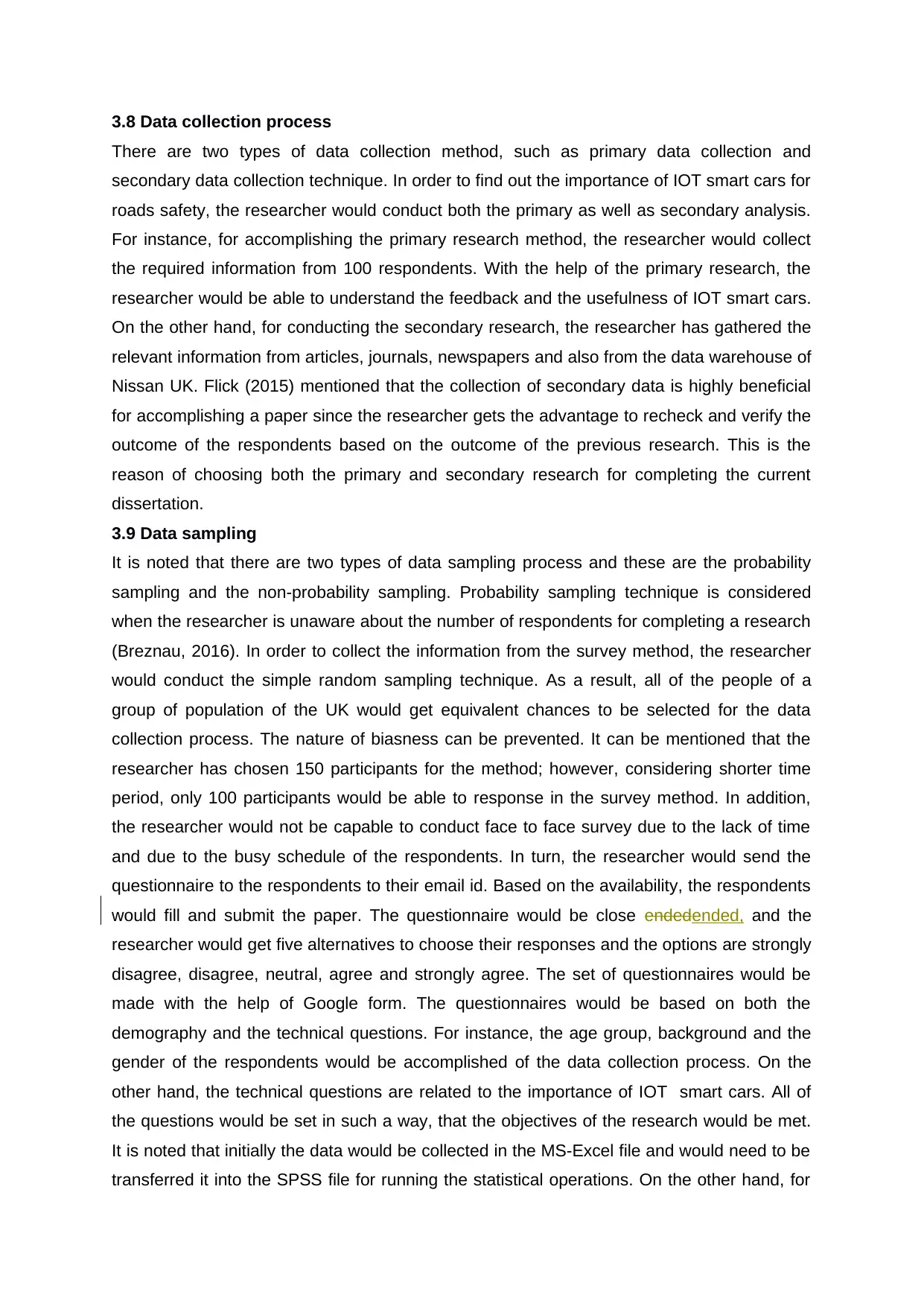
3.8 Data collection process
There are two types of data collection method, such as primary data collection and
secondary data collection technique. In order to find out the importance of IOT smart cars for
roads safety, the researcher would conduct both the primary as well as secondary analysis.
For instance, for accomplishing the primary research method, the researcher would collect
the required information from 100 respondents. With the help of the primary research, the
researcher would be able to understand the feedback and the usefulness of IOT smart cars.
On the other hand, for conducting the secondary research, the researcher has gathered the
relevant information from articles, journals, newspapers and also from the data warehouse of
Nissan UK. Flick (2015) mentioned that the collection of secondary data is highly beneficial
for accomplishing a paper since the researcher gets the advantage to recheck and verify the
outcome of the respondents based on the outcome of the previous research. This is the
reason of choosing both the primary and secondary research for completing the current
dissertation.
3.9 Data sampling
It is noted that there are two types of data sampling process and these are the probability
sampling and the non-probability sampling. Probability sampling technique is considered
when the researcher is unaware about the number of respondents for completing a research
(Breznau, 2016). In order to collect the information from the survey method, the researcher
would conduct the simple random sampling technique. As a result, all of the people of a
group of population of the UK would get equivalent chances to be selected for the data
collection process. The nature of biasness can be prevented. It can be mentioned that the
researcher has chosen 150 participants for the method; however, considering shorter time
period, only 100 participants would be able to response in the survey method. In addition,
the researcher would not be capable to conduct face to face survey due to the lack of time
and due to the busy schedule of the respondents. In turn, the researcher would send the
questionnaire to the respondents to their email id. Based on the availability, the respondents
would fill and submit the paper. The questionnaire would be close endedended, and the
researcher would get five alternatives to choose their responses and the options are strongly
disagree, disagree, neutral, agree and strongly agree. The set of questionnaires would be
made with the help of Google form. The questionnaires would be based on both the
demography and the technical questions. For instance, the age group, background and the
gender of the respondents would be accomplished of the data collection process. On the
other hand, the technical questions are related to the importance of IOT smart cars. All of
the questions would be set in such a way, that the objectives of the research would be met.
It is noted that initially the data would be collected in the MS-Excel file and would need to be
transferred it into the SPSS file for running the statistical operations. On the other hand, for
There are two types of data collection method, such as primary data collection and
secondary data collection technique. In order to find out the importance of IOT smart cars for
roads safety, the researcher would conduct both the primary as well as secondary analysis.
For instance, for accomplishing the primary research method, the researcher would collect
the required information from 100 respondents. With the help of the primary research, the
researcher would be able to understand the feedback and the usefulness of IOT smart cars.
On the other hand, for conducting the secondary research, the researcher has gathered the
relevant information from articles, journals, newspapers and also from the data warehouse of
Nissan UK. Flick (2015) mentioned that the collection of secondary data is highly beneficial
for accomplishing a paper since the researcher gets the advantage to recheck and verify the
outcome of the respondents based on the outcome of the previous research. This is the
reason of choosing both the primary and secondary research for completing the current
dissertation.
3.9 Data sampling
It is noted that there are two types of data sampling process and these are the probability
sampling and the non-probability sampling. Probability sampling technique is considered
when the researcher is unaware about the number of respondents for completing a research
(Breznau, 2016). In order to collect the information from the survey method, the researcher
would conduct the simple random sampling technique. As a result, all of the people of a
group of population of the UK would get equivalent chances to be selected for the data
collection process. The nature of biasness can be prevented. It can be mentioned that the
researcher has chosen 150 participants for the method; however, considering shorter time
period, only 100 participants would be able to response in the survey method. In addition,
the researcher would not be capable to conduct face to face survey due to the lack of time
and due to the busy schedule of the respondents. In turn, the researcher would send the
questionnaire to the respondents to their email id. Based on the availability, the respondents
would fill and submit the paper. The questionnaire would be close endedended, and the
researcher would get five alternatives to choose their responses and the options are strongly
disagree, disagree, neutral, agree and strongly agree. The set of questionnaires would be
made with the help of Google form. The questionnaires would be based on both the
demography and the technical questions. For instance, the age group, background and the
gender of the respondents would be accomplished of the data collection process. On the
other hand, the technical questions are related to the importance of IOT smart cars. All of
the questions would be set in such a way, that the objectives of the research would be met.
It is noted that initially the data would be collected in the MS-Excel file and would need to be
transferred it into the SPSS file for running the statistical operations. On the other hand, for
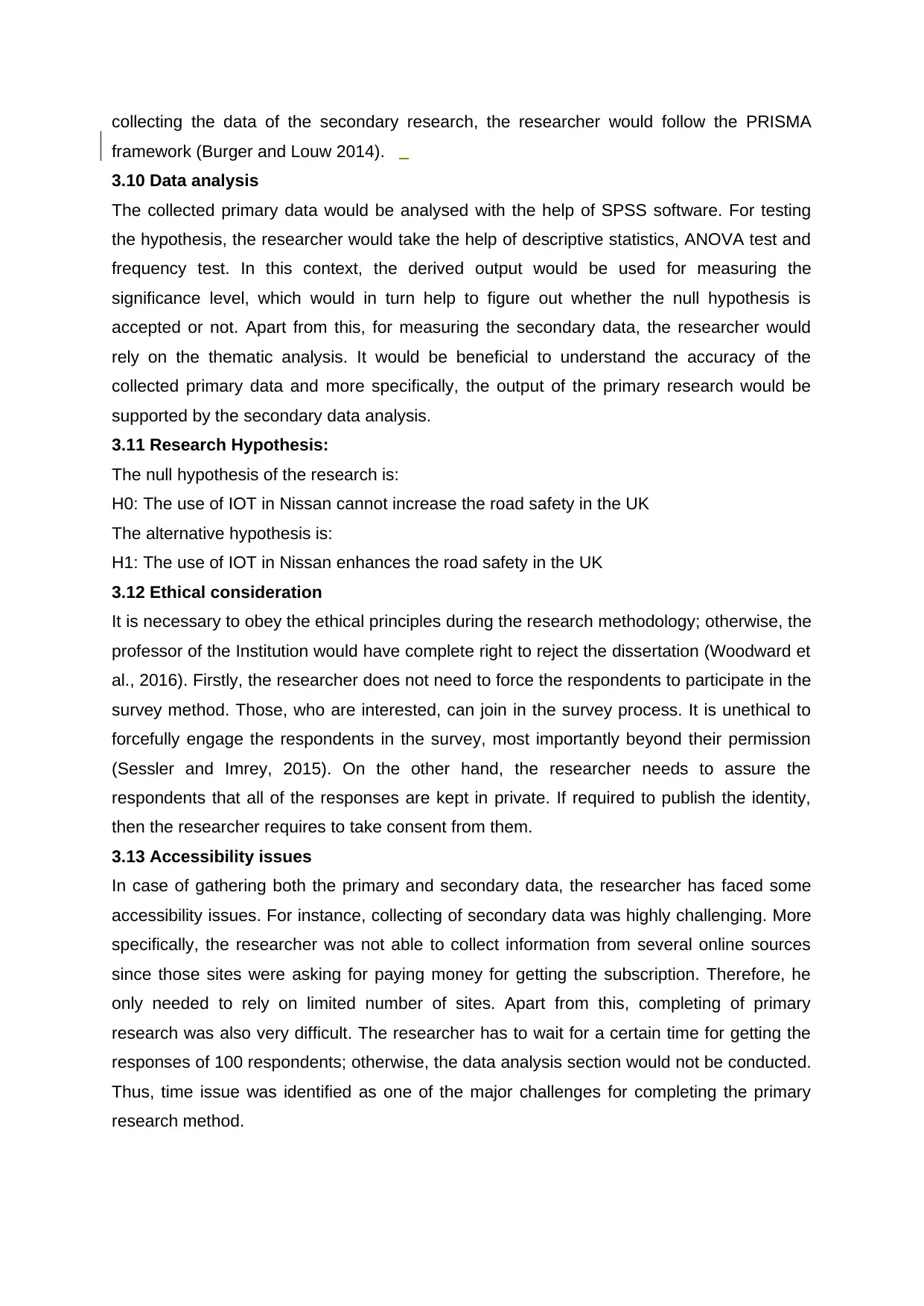
collecting the data of the secondary research, the researcher would follow the PRISMA
framework (Burger and Louw 2014).
3.10 Data analysis
The collected primary data would be analysed with the help of SPSS software. For testing
the hypothesis, the researcher would take the help of descriptive statistics, ANOVA test and
frequency test. In this context, the derived output would be used for measuring the
significance level, which would in turn help to figure out whether the null hypothesis is
accepted or not. Apart from this, for measuring the secondary data, the researcher would
rely on the thematic analysis. It would be beneficial to understand the accuracy of the
collected primary data and more specifically, the output of the primary research would be
supported by the secondary data analysis.
3.11 Research Hypothesis:
The null hypothesis of the research is:
H0: The use of IOT in Nissan cannot increase the road safety in the UK
The alternative hypothesis is:
H1: The use of IOT in Nissan enhances the road safety in the UK
3.12 Ethical consideration
It is necessary to obey the ethical principles during the research methodology; otherwise, the
professor of the Institution would have complete right to reject the dissertation (Woodward et
al., 2016). Firstly, the researcher does not need to force the respondents to participate in the
survey method. Those, who are interested, can join in the survey process. It is unethical to
forcefully engage the respondents in the survey, most importantly beyond their permission
(Sessler and Imrey, 2015). On the other hand, the researcher needs to assure the
respondents that all of the responses are kept in private. If required to publish the identity,
then the researcher requires to take consent from them.
3.13 Accessibility issues
In case of gathering both the primary and secondary data, the researcher has faced some
accessibility issues. For instance, collecting of secondary data was highly challenging. More
specifically, the researcher was not able to collect information from several online sources
since those sites were asking for paying money for getting the subscription. Therefore, he
only needed to rely on limited number of sites. Apart from this, completing of primary
research was also very difficult. The researcher has to wait for a certain time for getting the
responses of 100 respondents; otherwise, the data analysis section would not be conducted.
Thus, time issue was identified as one of the major challenges for completing the primary
research method.
framework (Burger and Louw 2014).
3.10 Data analysis
The collected primary data would be analysed with the help of SPSS software. For testing
the hypothesis, the researcher would take the help of descriptive statistics, ANOVA test and
frequency test. In this context, the derived output would be used for measuring the
significance level, which would in turn help to figure out whether the null hypothesis is
accepted or not. Apart from this, for measuring the secondary data, the researcher would
rely on the thematic analysis. It would be beneficial to understand the accuracy of the
collected primary data and more specifically, the output of the primary research would be
supported by the secondary data analysis.
3.11 Research Hypothesis:
The null hypothesis of the research is:
H0: The use of IOT in Nissan cannot increase the road safety in the UK
The alternative hypothesis is:
H1: The use of IOT in Nissan enhances the road safety in the UK
3.12 Ethical consideration
It is necessary to obey the ethical principles during the research methodology; otherwise, the
professor of the Institution would have complete right to reject the dissertation (Woodward et
al., 2016). Firstly, the researcher does not need to force the respondents to participate in the
survey method. Those, who are interested, can join in the survey process. It is unethical to
forcefully engage the respondents in the survey, most importantly beyond their permission
(Sessler and Imrey, 2015). On the other hand, the researcher needs to assure the
respondents that all of the responses are kept in private. If required to publish the identity,
then the researcher requires to take consent from them.
3.13 Accessibility issues
In case of gathering both the primary and secondary data, the researcher has faced some
accessibility issues. For instance, collecting of secondary data was highly challenging. More
specifically, the researcher was not able to collect information from several online sources
since those sites were asking for paying money for getting the subscription. Therefore, he
only needed to rely on limited number of sites. Apart from this, completing of primary
research was also very difficult. The researcher has to wait for a certain time for getting the
responses of 100 respondents; otherwise, the data analysis section would not be conducted.
Thus, time issue was identified as one of the major challenges for completing the primary
research method.
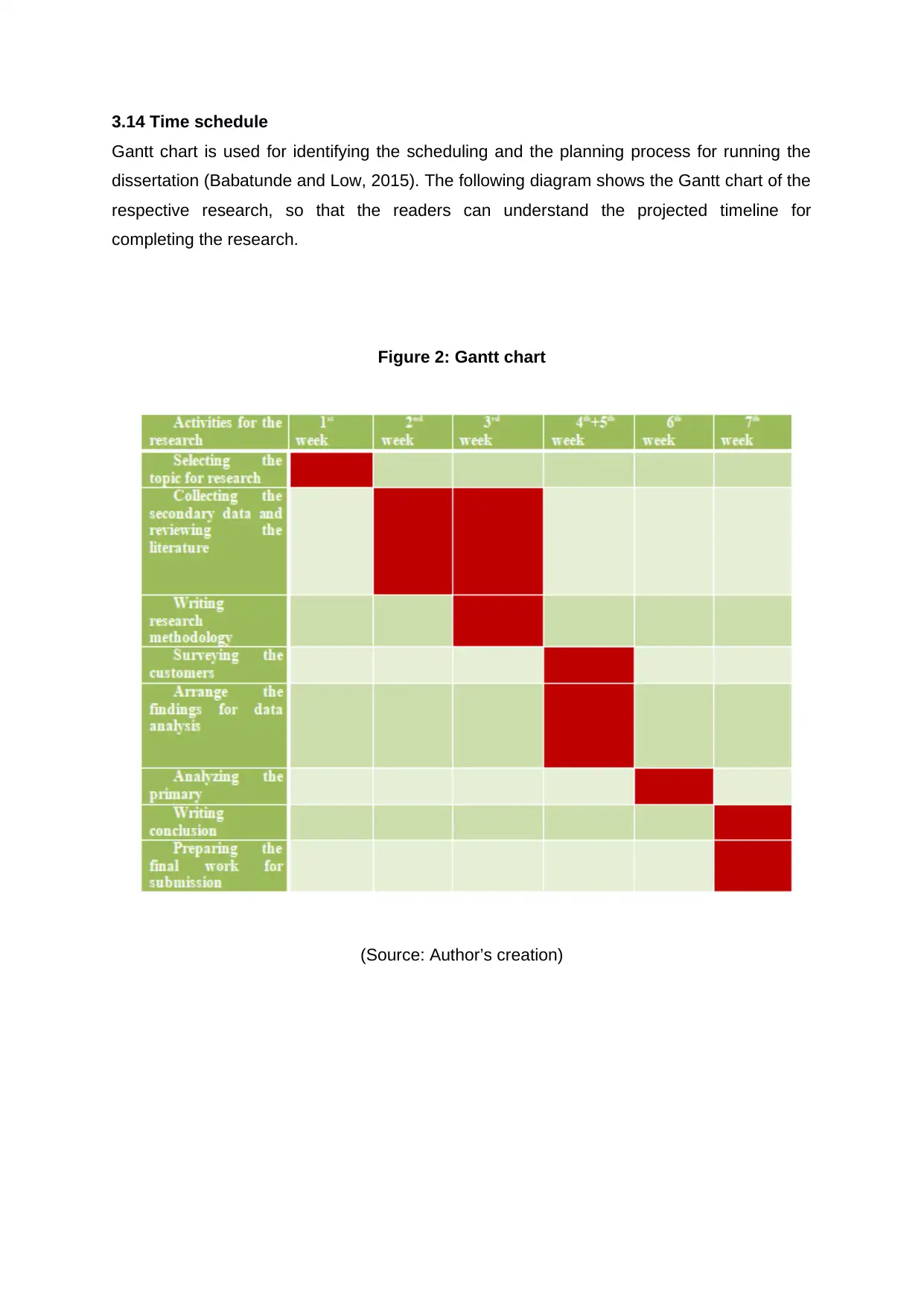
3.14 Time schedule
Gantt chart is used for identifying the scheduling and the planning process for running the
dissertation (Babatunde and Low, 2015). The following diagram shows the Gantt chart of the
respective research, so that the readers can understand the projected timeline for
completing the research.
Figure 2: Gantt chart
(Source: Author’s creation)
Gantt chart is used for identifying the scheduling and the planning process for running the
dissertation (Babatunde and Low, 2015). The following diagram shows the Gantt chart of the
respective research, so that the readers can understand the projected timeline for
completing the research.
Figure 2: Gantt chart
(Source: Author’s creation)
Secure Best Marks with AI Grader
Need help grading? Try our AI Grader for instant feedback on your assignments.
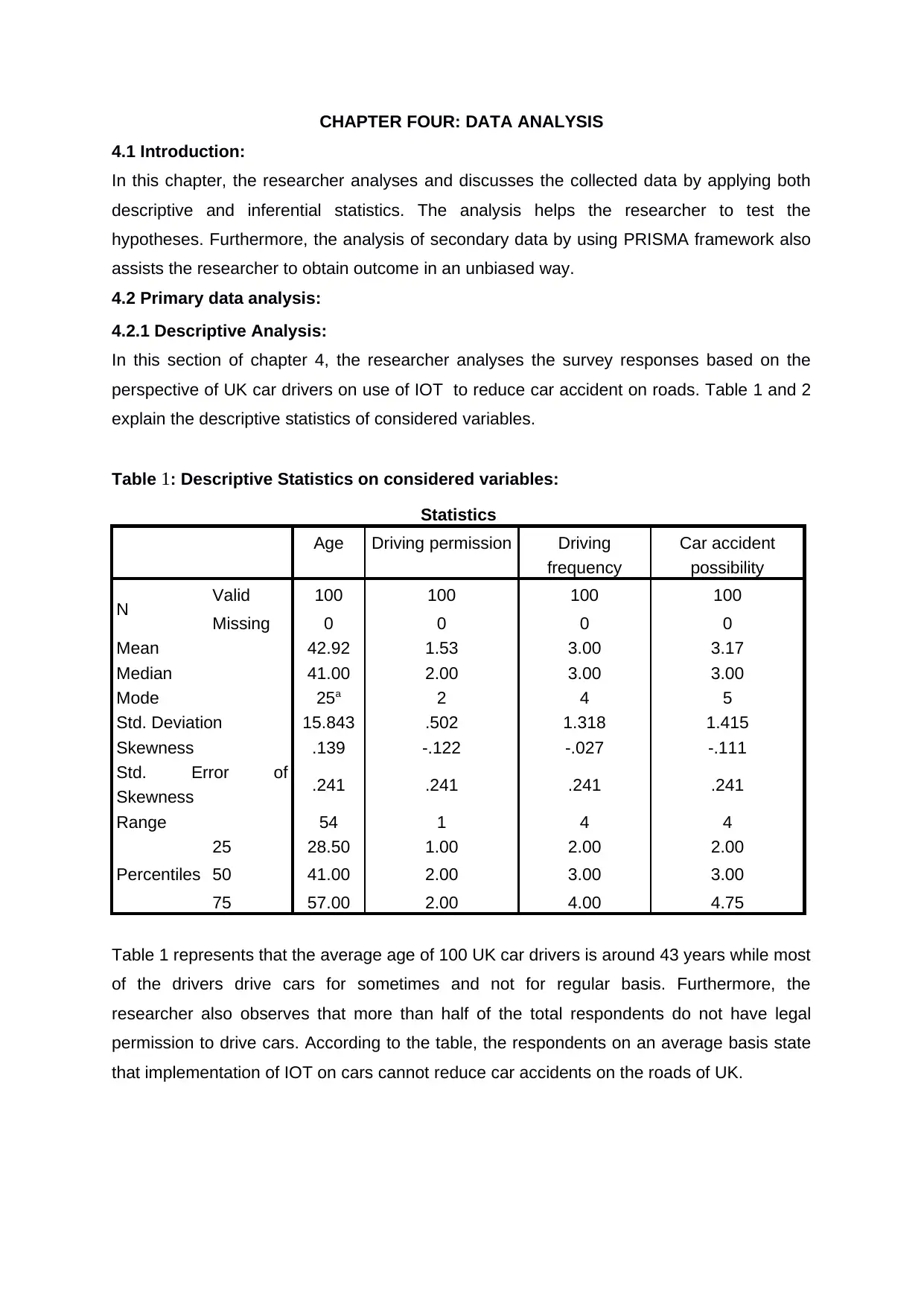
CHAPTER FOUR: DATA ANALYSIS
4.1 Introduction:
In this chapter, the researcher analyses and discusses the collected data by applying both
descriptive and inferential statistics. The analysis helps the researcher to test the
hypotheses. Furthermore, the analysis of secondary data by using PRISMA framework also
assists the researcher to obtain outcome in an unbiased way.
4.2 Primary data analysis:
4.2.1 Descriptive Analysis:
In this section of chapter 4, the researcher analyses the survey responses based on the
perspective of UK car drivers on use of IOT to reduce car accident on roads. Table 1 and 2
explain the descriptive statistics of considered variables.
Table 1: Descriptive Statistics on considered variables:
Statistics
Age Driving permission Driving
frequency
Car accident
possibility
N Valid 100 100 100 100
Missing 0 0 0 0
Mean 42.92 1.53 3.00 3.17
Median 41.00 2.00 3.00 3.00
Mode 25a 2 4 5
Std. Deviation 15.843 .502 1.318 1.415
Skewness .139 -.122 -.027 -.111
Std. Error of
Skewness .241 .241 .241 .241
Range 54 1 4 4
Percentiles
25 28.50 1.00 2.00 2.00
50 41.00 2.00 3.00 3.00
75 57.00 2.00 4.00 4.75
Table 1 represents that the average age of 100 UK car drivers is around 43 years while most
of the drivers drive cars for sometimes and not for regular basis. Furthermore, the
researcher also observes that more than half of the total respondents do not have legal
permission to drive cars. According to the table, the respondents on an average basis state
that implementation of IOT on cars cannot reduce car accidents on the roads of UK.
4.1 Introduction:
In this chapter, the researcher analyses and discusses the collected data by applying both
descriptive and inferential statistics. The analysis helps the researcher to test the
hypotheses. Furthermore, the analysis of secondary data by using PRISMA framework also
assists the researcher to obtain outcome in an unbiased way.
4.2 Primary data analysis:
4.2.1 Descriptive Analysis:
In this section of chapter 4, the researcher analyses the survey responses based on the
perspective of UK car drivers on use of IOT to reduce car accident on roads. Table 1 and 2
explain the descriptive statistics of considered variables.
Table 1: Descriptive Statistics on considered variables:
Statistics
Age Driving permission Driving
frequency
Car accident
possibility
N Valid 100 100 100 100
Missing 0 0 0 0
Mean 42.92 1.53 3.00 3.17
Median 41.00 2.00 3.00 3.00
Mode 25a 2 4 5
Std. Deviation 15.843 .502 1.318 1.415
Skewness .139 -.122 -.027 -.111
Std. Error of
Skewness .241 .241 .241 .241
Range 54 1 4 4
Percentiles
25 28.50 1.00 2.00 2.00
50 41.00 2.00 3.00 3.00
75 57.00 2.00 4.00 4.75
Table 1 represents that the average age of 100 UK car drivers is around 43 years while most
of the drivers drive cars for sometimes and not for regular basis. Furthermore, the
researcher also observes that more than half of the total respondents do not have legal
permission to drive cars. According to the table, the respondents on an average basis state
that implementation of IOT on cars cannot reduce car accidents on the roads of UK.
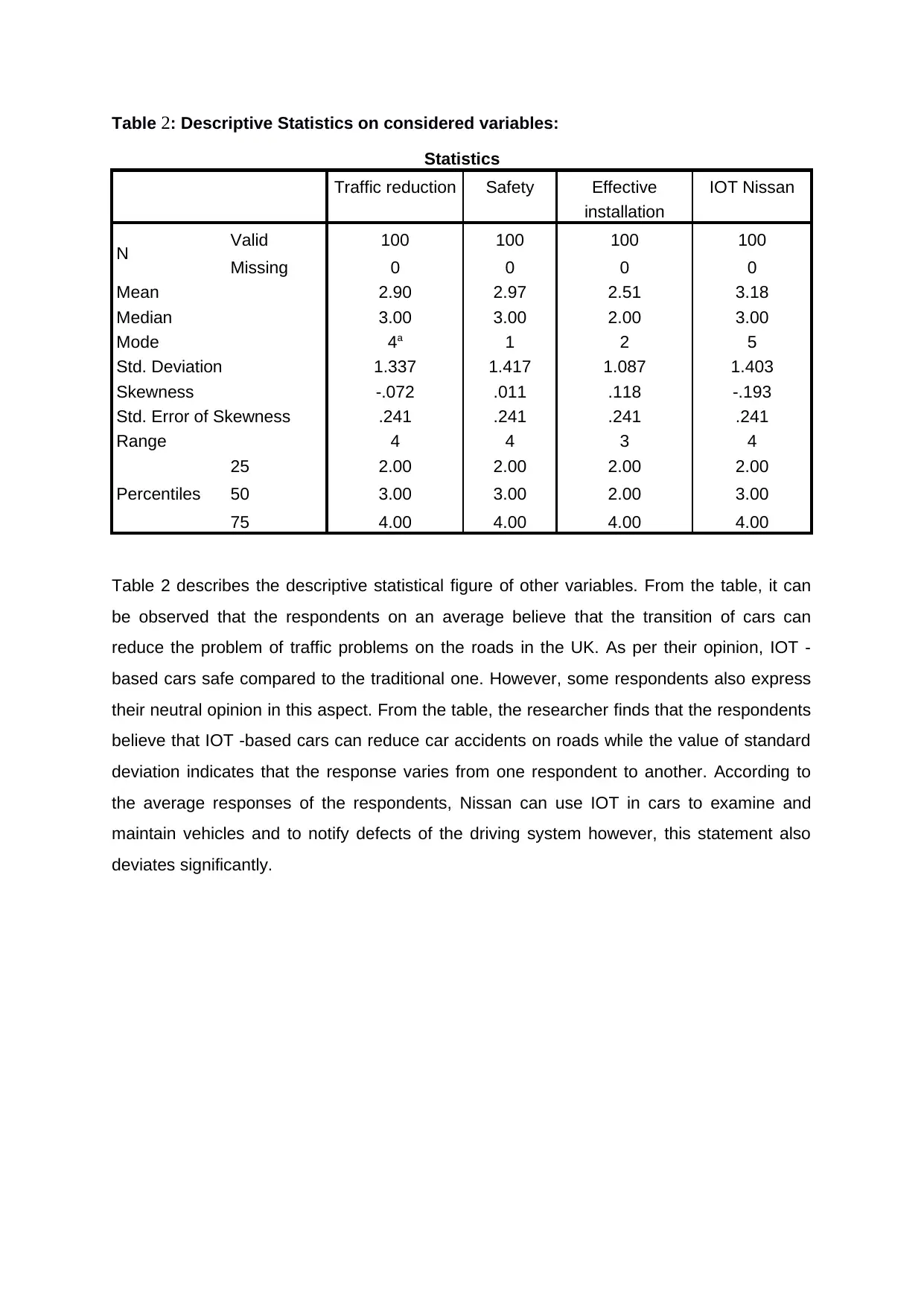
Table 2: Descriptive Statistics on considered variables:
Statistics
Traffic reduction Safety Effective
installation
IOT Nissan
N Valid 100 100 100 100
Missing 0 0 0 0
Mean 2.90 2.97 2.51 3.18
Median 3.00 3.00 2.00 3.00
Mode 4a 1 2 5
Std. Deviation 1.337 1.417 1.087 1.403
Skewness -.072 .011 .118 -.193
Std. Error of Skewness .241 .241 .241 .241
Range 4 4 3 4
Percentiles
25 2.00 2.00 2.00 2.00
50 3.00 3.00 2.00 3.00
75 4.00 4.00 4.00 4.00
Table 2 describes the descriptive statistical figure of other variables. From the table, it can
be observed that the respondents on an average believe that the transition of cars can
reduce the problem of traffic problems on the roads in the UK. As per their opinion, IOT -
based cars safe compared to the traditional one. However, some respondents also express
their neutral opinion in this aspect. From the table, the researcher finds that the respondents
believe that IOT -based cars can reduce car accidents on roads while the value of standard
deviation indicates that the response varies from one respondent to another. According to
the average responses of the respondents, Nissan can use IOT in cars to examine and
maintain vehicles and to notify defects of the driving system however, this statement also
deviates significantly.
Statistics
Traffic reduction Safety Effective
installation
IOT Nissan
N Valid 100 100 100 100
Missing 0 0 0 0
Mean 2.90 2.97 2.51 3.18
Median 3.00 3.00 2.00 3.00
Mode 4a 1 2 5
Std. Deviation 1.337 1.417 1.087 1.403
Skewness -.072 .011 .118 -.193
Std. Error of Skewness .241 .241 .241 .241
Range 4 4 3 4
Percentiles
25 2.00 2.00 2.00 2.00
50 3.00 3.00 2.00 3.00
75 4.00 4.00 4.00 4.00
Table 2 describes the descriptive statistical figure of other variables. From the table, it can
be observed that the respondents on an average believe that the transition of cars can
reduce the problem of traffic problems on the roads in the UK. As per their opinion, IOT -
based cars safe compared to the traditional one. However, some respondents also express
their neutral opinion in this aspect. From the table, the researcher finds that the respondents
believe that IOT -based cars can reduce car accidents on roads while the value of standard
deviation indicates that the response varies from one respondent to another. According to
the average responses of the respondents, Nissan can use IOT in cars to examine and
maintain vehicles and to notify defects of the driving system however, this statement also
deviates significantly.
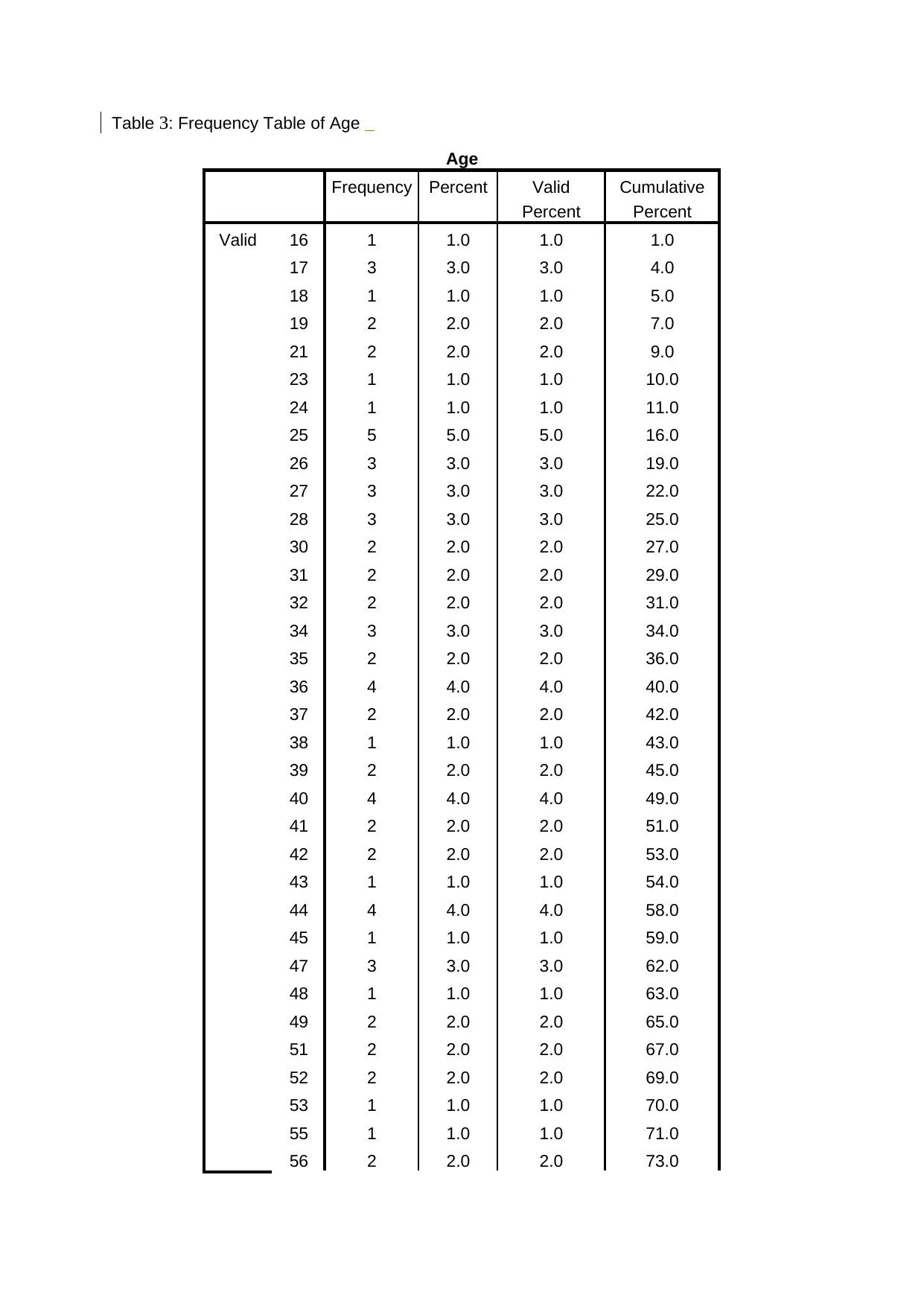
Table 3: Frequency Table of Age
Age
Frequency Percent Valid
Percent
Cumulative
Percent
Valid 16 1 1.0 1.0 1.0
17 3 3.0 3.0 4.0
18 1 1.0 1.0 5.0
19 2 2.0 2.0 7.0
21 2 2.0 2.0 9.0
23 1 1.0 1.0 10.0
24 1 1.0 1.0 11.0
25 5 5.0 5.0 16.0
26 3 3.0 3.0 19.0
27 3 3.0 3.0 22.0
28 3 3.0 3.0 25.0
30 2 2.0 2.0 27.0
31 2 2.0 2.0 29.0
32 2 2.0 2.0 31.0
34 3 3.0 3.0 34.0
35 2 2.0 2.0 36.0
36 4 4.0 4.0 40.0
37 2 2.0 2.0 42.0
38 1 1.0 1.0 43.0
39 2 2.0 2.0 45.0
40 4 4.0 4.0 49.0
41 2 2.0 2.0 51.0
42 2 2.0 2.0 53.0
43 1 1.0 1.0 54.0
44 4 4.0 4.0 58.0
45 1 1.0 1.0 59.0
47 3 3.0 3.0 62.0
48 1 1.0 1.0 63.0
49 2 2.0 2.0 65.0
51 2 2.0 2.0 67.0
52 2 2.0 2.0 69.0
53 1 1.0 1.0 70.0
55 1 1.0 1.0 71.0
56 2 2.0 2.0 73.0
Age
Frequency Percent Valid
Percent
Cumulative
Percent
Valid 16 1 1.0 1.0 1.0
17 3 3.0 3.0 4.0
18 1 1.0 1.0 5.0
19 2 2.0 2.0 7.0
21 2 2.0 2.0 9.0
23 1 1.0 1.0 10.0
24 1 1.0 1.0 11.0
25 5 5.0 5.0 16.0
26 3 3.0 3.0 19.0
27 3 3.0 3.0 22.0
28 3 3.0 3.0 25.0
30 2 2.0 2.0 27.0
31 2 2.0 2.0 29.0
32 2 2.0 2.0 31.0
34 3 3.0 3.0 34.0
35 2 2.0 2.0 36.0
36 4 4.0 4.0 40.0
37 2 2.0 2.0 42.0
38 1 1.0 1.0 43.0
39 2 2.0 2.0 45.0
40 4 4.0 4.0 49.0
41 2 2.0 2.0 51.0
42 2 2.0 2.0 53.0
43 1 1.0 1.0 54.0
44 4 4.0 4.0 58.0
45 1 1.0 1.0 59.0
47 3 3.0 3.0 62.0
48 1 1.0 1.0 63.0
49 2 2.0 2.0 65.0
51 2 2.0 2.0 67.0
52 2 2.0 2.0 69.0
53 1 1.0 1.0 70.0
55 1 1.0 1.0 71.0
56 2 2.0 2.0 73.0
Paraphrase This Document
Need a fresh take? Get an instant paraphrase of this document with our AI Paraphraser
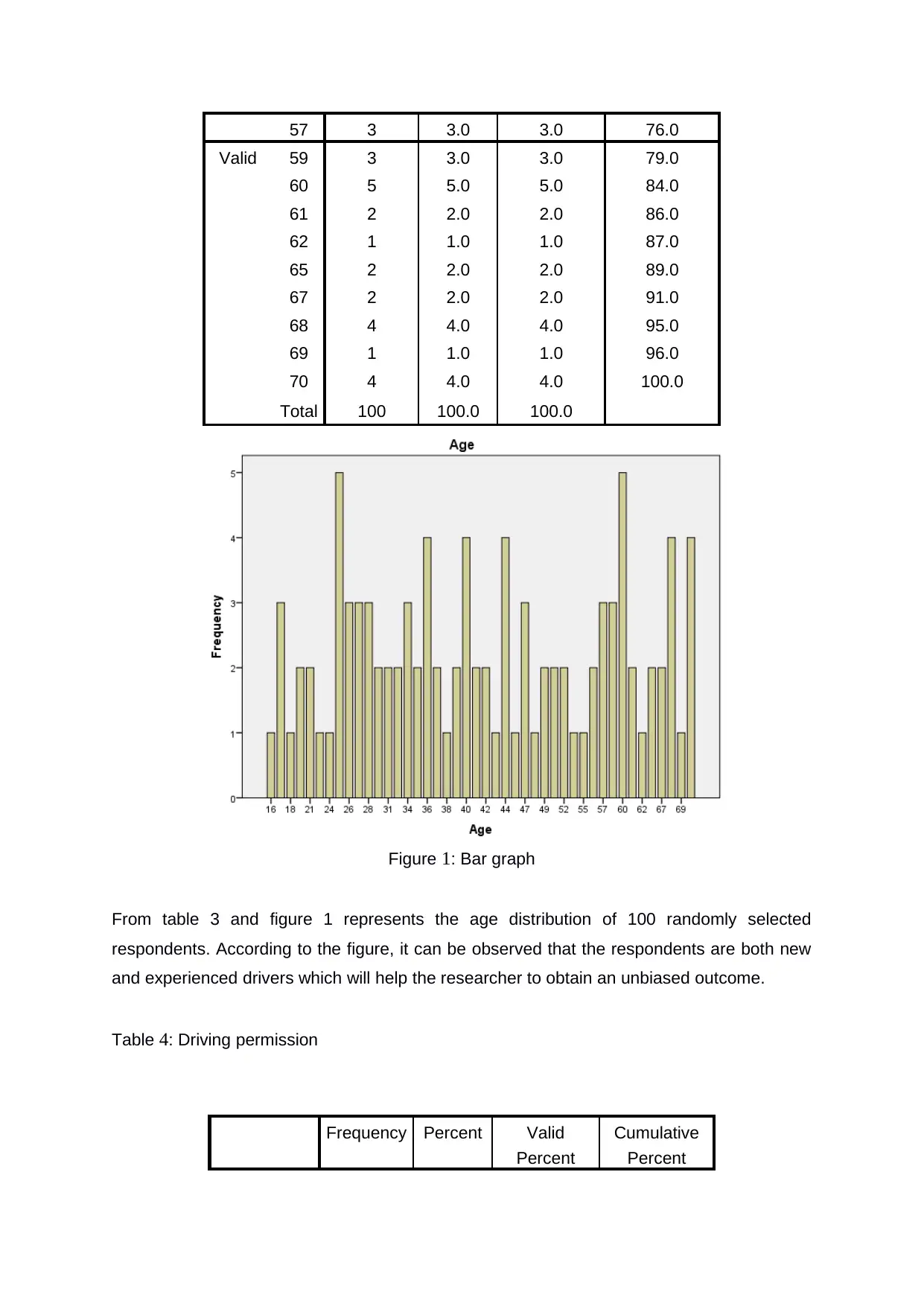
57 3 3.0 3.0 76.0
Valid 59 3 3.0 3.0 79.0
60 5 5.0 5.0 84.0
61 2 2.0 2.0 86.0
62 1 1.0 1.0 87.0
65 2 2.0 2.0 89.0
67 2 2.0 2.0 91.0
68 4 4.0 4.0 95.0
69 1 1.0 1.0 96.0
70 4 4.0 4.0 100.0
Total 100 100.0 100.0
Figure 1: Bar graph
From table 3 and figure 1 represents the age distribution of 100 randomly selected
respondents. According to the figure, it can be observed that the respondents are both new
and experienced drivers which will help the researcher to obtain an unbiased outcome.
Table 4: Driving permission
Frequency Percent Valid
Percent
Cumulative
Percent
Valid 59 3 3.0 3.0 79.0
60 5 5.0 5.0 84.0
61 2 2.0 2.0 86.0
62 1 1.0 1.0 87.0
65 2 2.0 2.0 89.0
67 2 2.0 2.0 91.0
68 4 4.0 4.0 95.0
69 1 1.0 1.0 96.0
70 4 4.0 4.0 100.0
Total 100 100.0 100.0
Figure 1: Bar graph
From table 3 and figure 1 represents the age distribution of 100 randomly selected
respondents. According to the figure, it can be observed that the respondents are both new
and experienced drivers which will help the researcher to obtain an unbiased outcome.
Table 4: Driving permission
Frequency Percent Valid
Percent
Cumulative
Percent
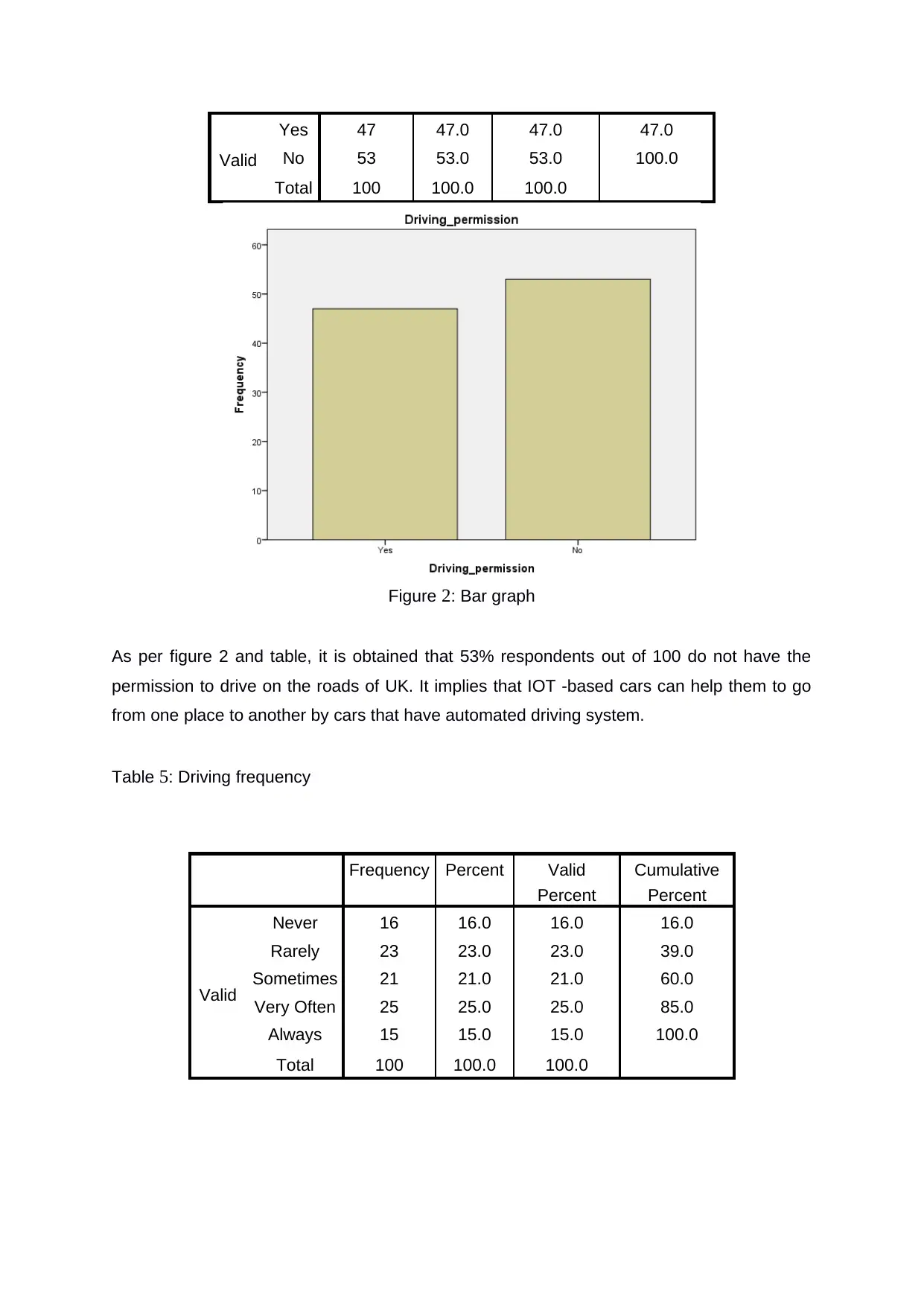
Valid
Yes 47 47.0 47.0 47.0
No 53 53.0 53.0 100.0
Total 100 100.0 100.0
Figure 2: Bar graph
As per figure 2 and table, it is obtained that 53% respondents out of 100 do not have the
permission to drive on the roads of UK. It implies that IOT -based cars can help them to go
from one place to another by cars that have automated driving system.
Table 5: Driving frequency
Frequency Percent Valid
Percent
Cumulative
Percent
Valid
Never 16 16.0 16.0 16.0
Rarely 23 23.0 23.0 39.0
Sometimes 21 21.0 21.0 60.0
Very Often 25 25.0 25.0 85.0
Always 15 15.0 15.0 100.0
Total 100 100.0 100.0
Yes 47 47.0 47.0 47.0
No 53 53.0 53.0 100.0
Total 100 100.0 100.0
Figure 2: Bar graph
As per figure 2 and table, it is obtained that 53% respondents out of 100 do not have the
permission to drive on the roads of UK. It implies that IOT -based cars can help them to go
from one place to another by cars that have automated driving system.
Table 5: Driving frequency
Frequency Percent Valid
Percent
Cumulative
Percent
Valid
Never 16 16.0 16.0 16.0
Rarely 23 23.0 23.0 39.0
Sometimes 21 21.0 21.0 60.0
Very Often 25 25.0 25.0 85.0
Always 15 15.0 15.0 100.0
Total 100 100.0 100.0
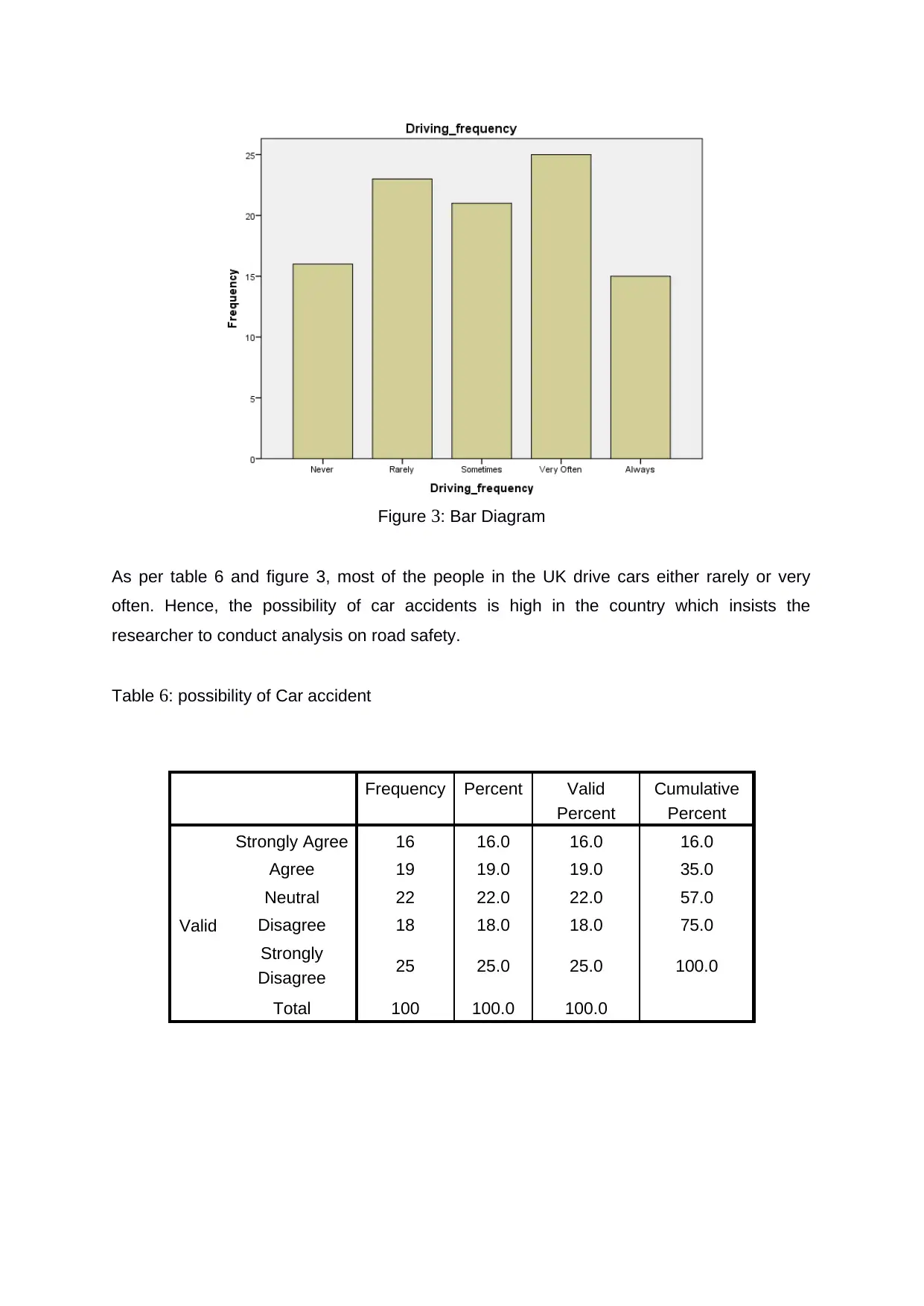
Figure 3: Bar Diagram
As per table 6 and figure 3, most of the people in the UK drive cars either rarely or very
often. Hence, the possibility of car accidents is high in the country which insists the
researcher to conduct analysis on road safety.
Table 6: possibility of Car accident
Frequency Percent Valid
Percent
Cumulative
Percent
Valid
Strongly Agree 16 16.0 16.0 16.0
Agree 19 19.0 19.0 35.0
Neutral 22 22.0 22.0 57.0
Disagree 18 18.0 18.0 75.0
Strongly
Disagree 25 25.0 25.0 100.0
Total 100 100.0 100.0
As per table 6 and figure 3, most of the people in the UK drive cars either rarely or very
often. Hence, the possibility of car accidents is high in the country which insists the
researcher to conduct analysis on road safety.
Table 6: possibility of Car accident
Frequency Percent Valid
Percent
Cumulative
Percent
Valid
Strongly Agree 16 16.0 16.0 16.0
Agree 19 19.0 19.0 35.0
Neutral 22 22.0 22.0 57.0
Disagree 18 18.0 18.0 75.0
Strongly
Disagree 25 25.0 25.0 100.0
Total 100 100.0 100.0
Secure Best Marks with AI Grader
Need help grading? Try our AI Grader for instant feedback on your assignments.
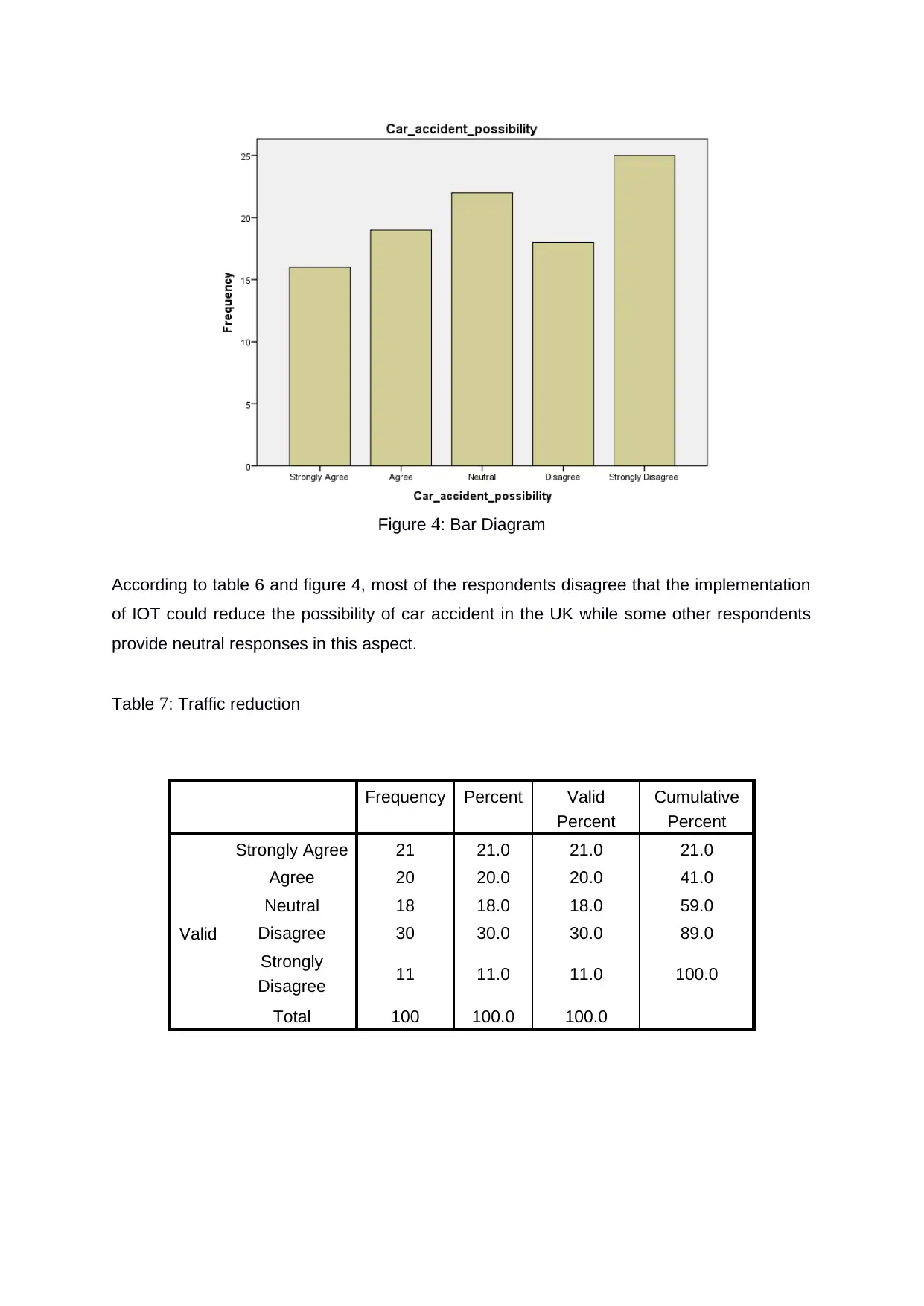
Figure 4: Bar Diagram
According to table 6 and figure 4, most of the respondents disagree that the implementation
of IOT could reduce the possibility of car accident in the UK while some other respondents
provide neutral responses in this aspect.
Table 7: Traffic reduction
Frequency Percent Valid
Percent
Cumulative
Percent
Valid
Strongly Agree 21 21.0 21.0 21.0
Agree 20 20.0 20.0 41.0
Neutral 18 18.0 18.0 59.0
Disagree 30 30.0 30.0 89.0
Strongly
Disagree 11 11.0 11.0 100.0
Total 100 100.0 100.0
According to table 6 and figure 4, most of the respondents disagree that the implementation
of IOT could reduce the possibility of car accident in the UK while some other respondents
provide neutral responses in this aspect.
Table 7: Traffic reduction
Frequency Percent Valid
Percent
Cumulative
Percent
Valid
Strongly Agree 21 21.0 21.0 21.0
Agree 20 20.0 20.0 41.0
Neutral 18 18.0 18.0 59.0
Disagree 30 30.0 30.0 89.0
Strongly
Disagree 11 11.0 11.0 100.0
Total 100 100.0 100.0
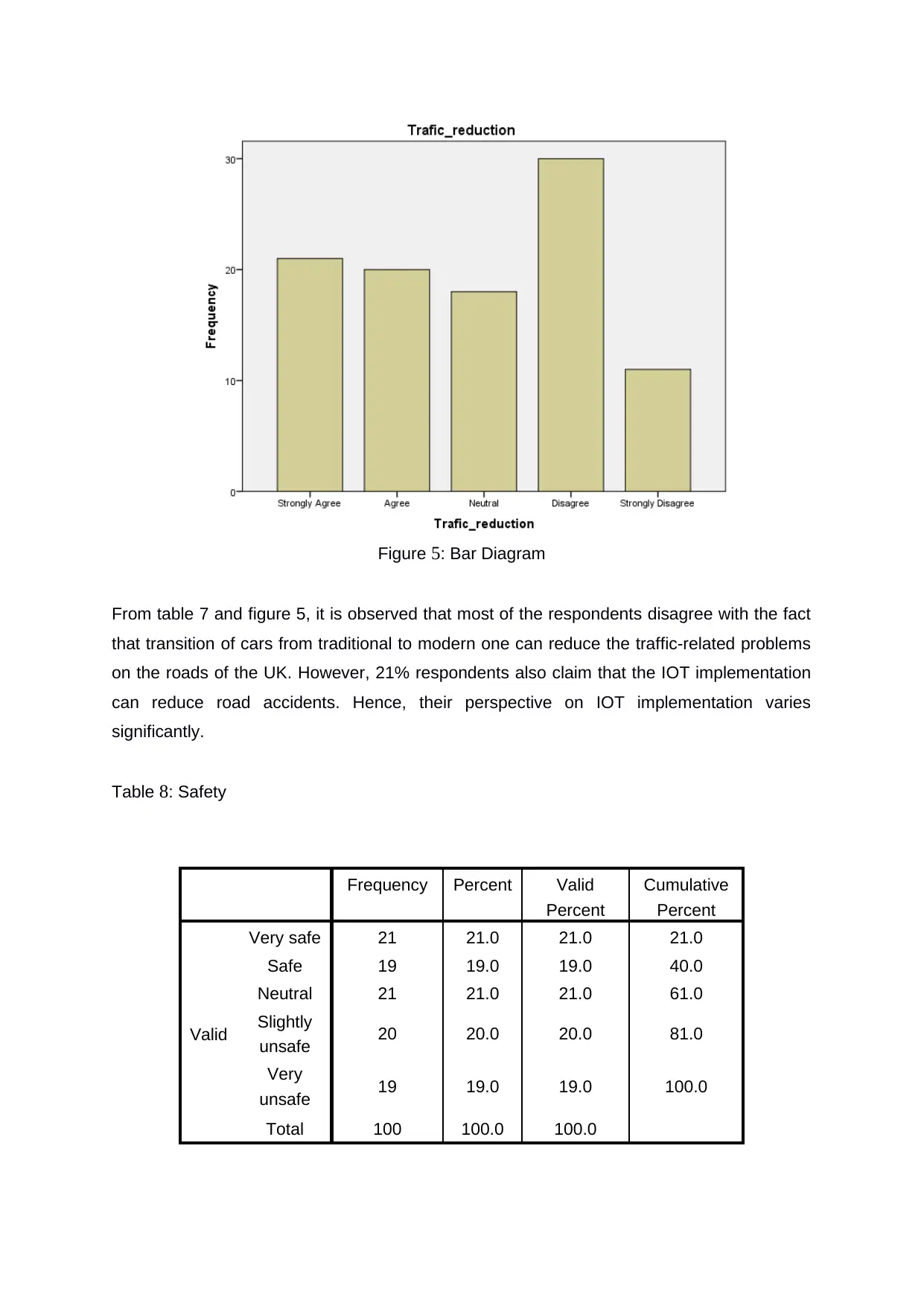
Figure 5: Bar Diagram
From table 7 and figure 5, it is observed that most of the respondents disagree with the fact
that transition of cars from traditional to modern one can reduce the traffic-related problems
on the roads of the UK. However, 21% respondents also claim that the IOT implementation
can reduce road accidents. Hence, their perspective on IOT implementation varies
significantly.
Table 8: Safety
Frequency Percent Valid
Percent
Cumulative
Percent
Valid
Very safe 21 21.0 21.0 21.0
Safe 19 19.0 19.0 40.0
Neutral 21 21.0 21.0 61.0
Slightly
unsafe 20 20.0 20.0 81.0
Very
unsafe 19 19.0 19.0 100.0
Total 100 100.0 100.0
From table 7 and figure 5, it is observed that most of the respondents disagree with the fact
that transition of cars from traditional to modern one can reduce the traffic-related problems
on the roads of the UK. However, 21% respondents also claim that the IOT implementation
can reduce road accidents. Hence, their perspective on IOT implementation varies
significantly.
Table 8: Safety
Frequency Percent Valid
Percent
Cumulative
Percent
Valid
Very safe 21 21.0 21.0 21.0
Safe 19 19.0 19.0 40.0
Neutral 21 21.0 21.0 61.0
Slightly
unsafe 20 20.0 20.0 81.0
Very
unsafe 19 19.0 19.0 100.0
Total 100 100.0 100.0
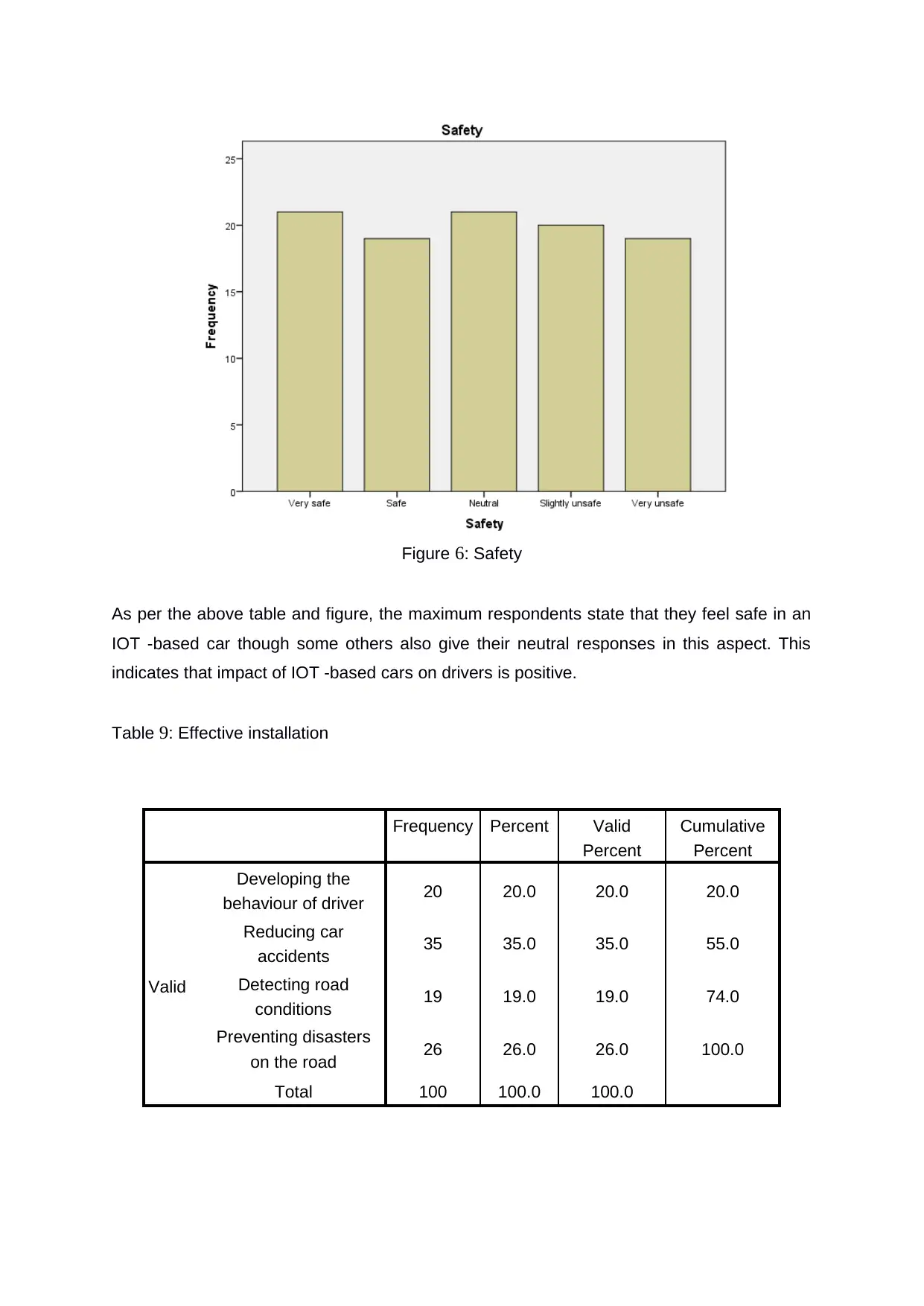
Figure 6: Safety
As per the above table and figure, the maximum respondents state that they feel safe in an
IOT -based car though some others also give their neutral responses in this aspect. This
indicates that impact of IOT -based cars on drivers is positive.
Table 9: Effective installation
Frequency Percent Valid
Percent
Cumulative
Percent
Valid
Developing the
behaviour of driver 20 20.0 20.0 20.0
Reducing car
accidents 35 35.0 35.0 55.0
Detecting road
conditions 19 19.0 19.0 74.0
Preventing disasters
on the road 26 26.0 26.0 100.0
Total 100 100.0 100.0
As per the above table and figure, the maximum respondents state that they feel safe in an
IOT -based car though some others also give their neutral responses in this aspect. This
indicates that impact of IOT -based cars on drivers is positive.
Table 9: Effective installation
Frequency Percent Valid
Percent
Cumulative
Percent
Valid
Developing the
behaviour of driver 20 20.0 20.0 20.0
Reducing car
accidents 35 35.0 35.0 55.0
Detecting road
conditions 19 19.0 19.0 74.0
Preventing disasters
on the road 26 26.0 26.0 100.0
Total 100 100.0 100.0
Paraphrase This Document
Need a fresh take? Get an instant paraphrase of this document with our AI Paraphraser
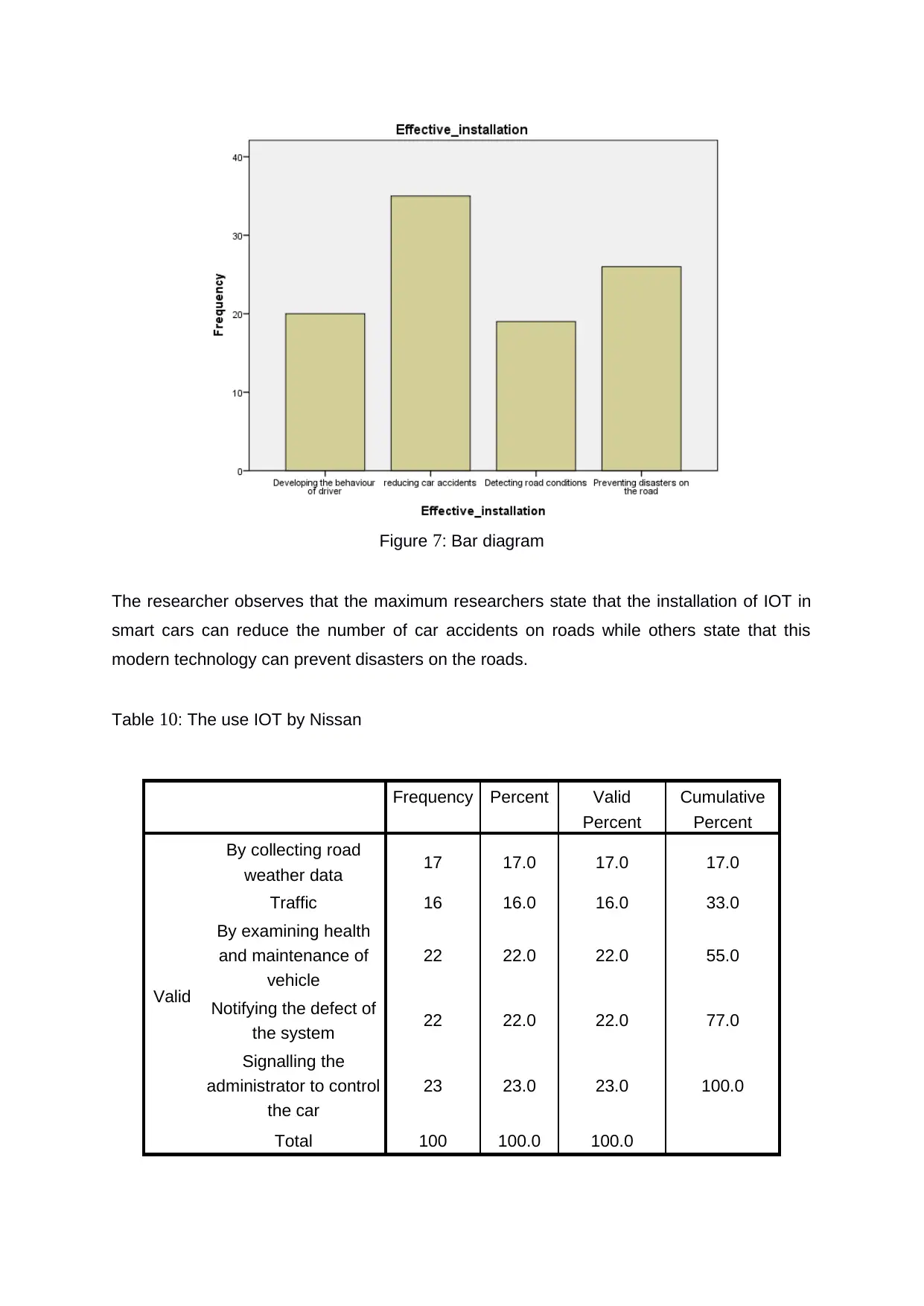
Figure 7: Bar diagram
The researcher observes that the maximum researchers state that the installation of IOT in
smart cars can reduce the number of car accidents on roads while others state that this
modern technology can prevent disasters on the roads.
Table 10: The use IOT by Nissan
Frequency Percent Valid
Percent
Cumulative
Percent
Valid
By collecting road
weather data 17 17.0 17.0 17.0
Traffic 16 16.0 16.0 33.0
By examining health
and maintenance of
vehicle
22 22.0 22.0 55.0
Notifying the defect of
the system 22 22.0 22.0 77.0
Signalling the
administrator to control
the car
23 23.0 23.0 100.0
Total 100 100.0 100.0
The researcher observes that the maximum researchers state that the installation of IOT in
smart cars can reduce the number of car accidents on roads while others state that this
modern technology can prevent disasters on the roads.
Table 10: The use IOT by Nissan
Frequency Percent Valid
Percent
Cumulative
Percent
Valid
By collecting road
weather data 17 17.0 17.0 17.0
Traffic 16 16.0 16.0 33.0
By examining health
and maintenance of
vehicle
22 22.0 22.0 55.0
Notifying the defect of
the system 22 22.0 22.0 77.0
Signalling the
administrator to control
the car
23 23.0 23.0 100.0
Total 100 100.0 100.0
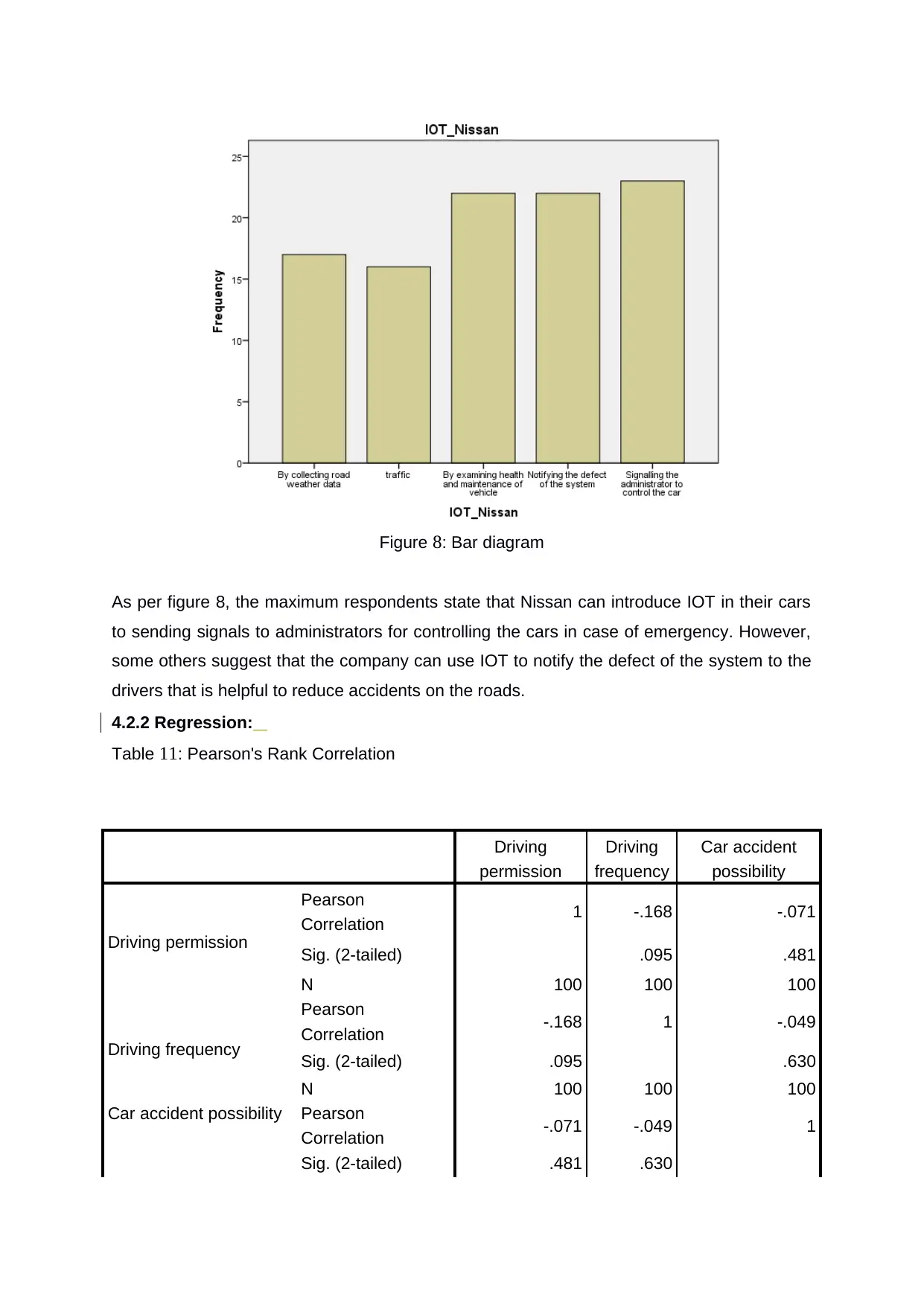
Figure 8: Bar diagram
As per figure 8, the maximum respondents state that Nissan can introduce IOT in their cars
to sending signals to administrators for controlling the cars in case of emergency. However,
some others suggest that the company can use IOT to notify the defect of the system to the
drivers that is helpful to reduce accidents on the roads.
4.2.2 Regression:
Table 11: Pearson's Rank Correlation
Driving
permission
Driving
frequency
Car accident
possibility
Driving permission
Pearson
Correlation 1 -.168 -.071
Sig. (2-tailed) .095 .481
N 100 100 100
Driving frequency
Pearson
Correlation -.168 1 -.049
Sig. (2-tailed) .095 .630
N 100 100 100
Car accident possibility Pearson
Correlation -.071 -.049 1
Sig. (2-tailed) .481 .630
As per figure 8, the maximum respondents state that Nissan can introduce IOT in their cars
to sending signals to administrators for controlling the cars in case of emergency. However,
some others suggest that the company can use IOT to notify the defect of the system to the
drivers that is helpful to reduce accidents on the roads.
4.2.2 Regression:
Table 11: Pearson's Rank Correlation
Driving
permission
Driving
frequency
Car accident
possibility
Driving permission
Pearson
Correlation 1 -.168 -.071
Sig. (2-tailed) .095 .481
N 100 100 100
Driving frequency
Pearson
Correlation -.168 1 -.049
Sig. (2-tailed) .095 .630
N 100 100 100
Car accident possibility Pearson
Correlation -.071 -.049 1
Sig. (2-tailed) .481 .630
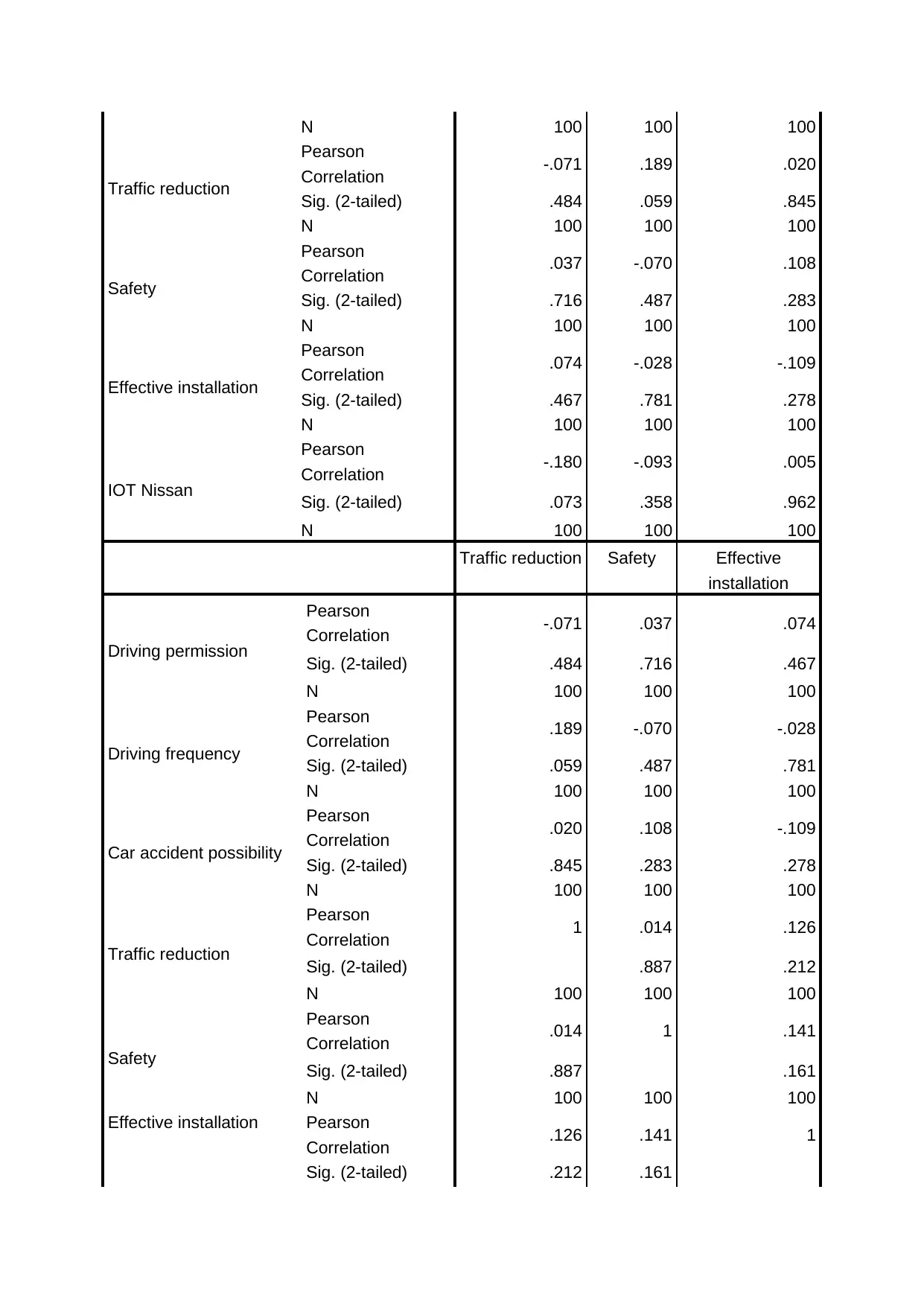
N 100 100 100
Traffic reduction
Pearson
Correlation -.071 .189 .020
Sig. (2-tailed) .484 .059 .845
N 100 100 100
Safety
Pearson
Correlation .037 -.070 .108
Sig. (2-tailed) .716 .487 .283
N 100 100 100
Effective installation
Pearson
Correlation .074 -.028 -.109
Sig. (2-tailed) .467 .781 .278
N 100 100 100
IOT Nissan
Pearson
Correlation -.180 -.093 .005
Sig. (2-tailed) .073 .358 .962
N 100 100 100
Traffic reduction Safety Effective
installation
Driving permission
Pearson
Correlation -.071 .037 .074
Sig. (2-tailed) .484 .716 .467
N 100 100 100
Driving frequency
Pearson
Correlation .189 -.070 -.028
Sig. (2-tailed) .059 .487 .781
N 100 100 100
Car accident possibility
Pearson
Correlation .020 .108 -.109
Sig. (2-tailed) .845 .283 .278
N 100 100 100
Traffic reduction
Pearson
Correlation 1 .014 .126
Sig. (2-tailed) .887 .212
N 100 100 100
Safety
Pearson
Correlation .014 1 .141
Sig. (2-tailed) .887 .161
N 100 100 100
Effective installation Pearson
Correlation .126 .141 1
Sig. (2-tailed) .212 .161
Traffic reduction
Pearson
Correlation -.071 .189 .020
Sig. (2-tailed) .484 .059 .845
N 100 100 100
Safety
Pearson
Correlation .037 -.070 .108
Sig. (2-tailed) .716 .487 .283
N 100 100 100
Effective installation
Pearson
Correlation .074 -.028 -.109
Sig. (2-tailed) .467 .781 .278
N 100 100 100
IOT Nissan
Pearson
Correlation -.180 -.093 .005
Sig. (2-tailed) .073 .358 .962
N 100 100 100
Traffic reduction Safety Effective
installation
Driving permission
Pearson
Correlation -.071 .037 .074
Sig. (2-tailed) .484 .716 .467
N 100 100 100
Driving frequency
Pearson
Correlation .189 -.070 -.028
Sig. (2-tailed) .059 .487 .781
N 100 100 100
Car accident possibility
Pearson
Correlation .020 .108 -.109
Sig. (2-tailed) .845 .283 .278
N 100 100 100
Traffic reduction
Pearson
Correlation 1 .014 .126
Sig. (2-tailed) .887 .212
N 100 100 100
Safety
Pearson
Correlation .014 1 .141
Sig. (2-tailed) .887 .161
N 100 100 100
Effective installation Pearson
Correlation .126 .141 1
Sig. (2-tailed) .212 .161
Secure Best Marks with AI Grader
Need help grading? Try our AI Grader for instant feedback on your assignments.
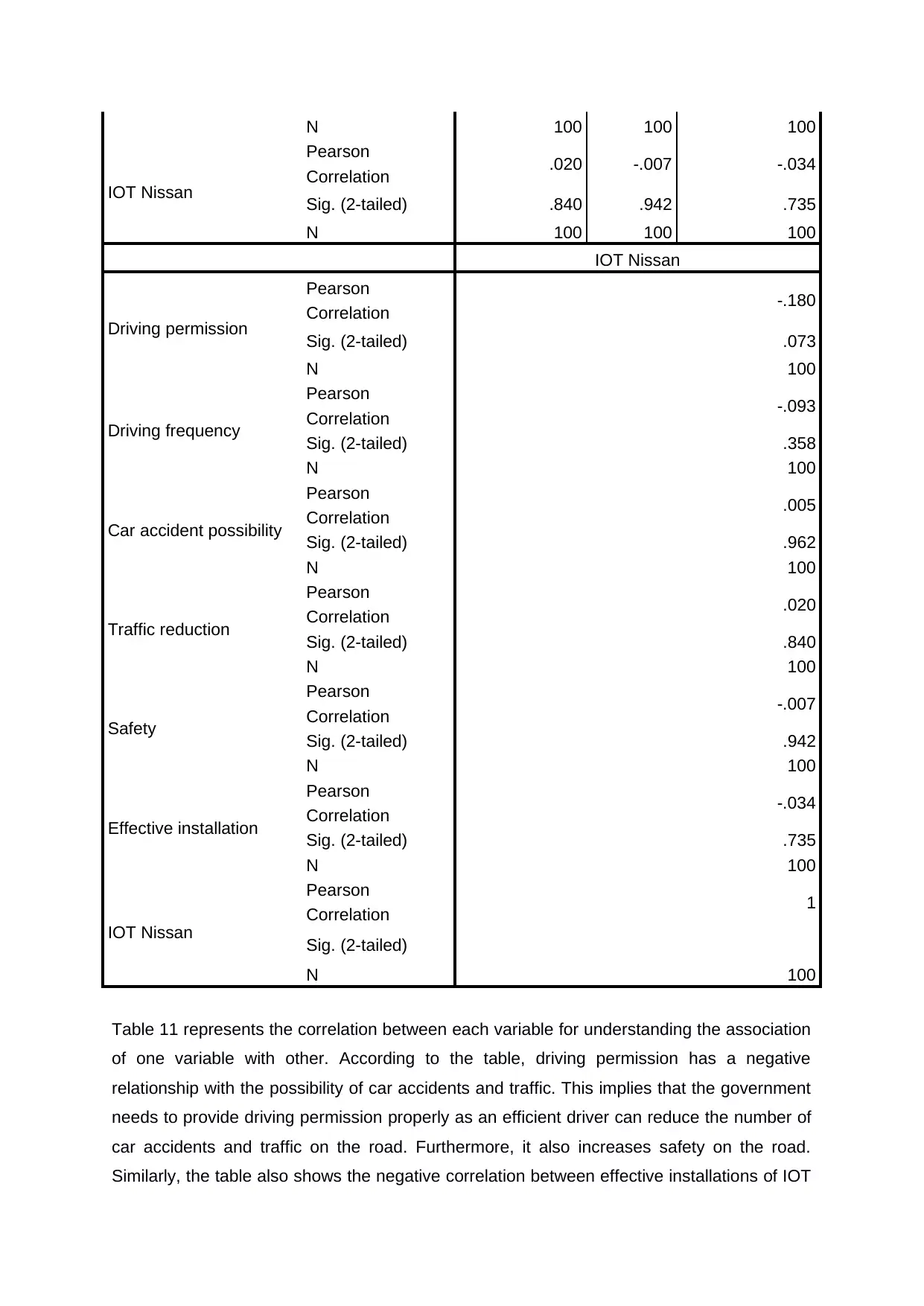
N 100 100 100
IOT Nissan
Pearson
Correlation .020 -.007 -.034
Sig. (2-tailed) .840 .942 .735
N 100 100 100
IOT Nissan
Driving permission
Pearson
Correlation -.180
Sig. (2-tailed) .073
N 100
Driving frequency
Pearson
Correlation -.093
Sig. (2-tailed) .358
N 100
Car accident possibility
Pearson
Correlation .005
Sig. (2-tailed) .962
N 100
Traffic reduction
Pearson
Correlation .020
Sig. (2-tailed) .840
N 100
Safety
Pearson
Correlation -.007
Sig. (2-tailed) .942
N 100
Effective installation
Pearson
Correlation -.034
Sig. (2-tailed) .735
N 100
IOT Nissan
Pearson
Correlation 1
Sig. (2-tailed)
N 100
Table 11 represents the correlation between each variable for understanding the association
of one variable with other. According to the table, driving permission has a negative
relationship with the possibility of car accidents and traffic. This implies that the government
needs to provide driving permission properly as an efficient driver can reduce the number of
car accidents and traffic on the road. Furthermore, it also increases safety on the road.
Similarly, the table also shows the negative correlation between effective installations of IOT
IOT Nissan
Pearson
Correlation .020 -.007 -.034
Sig. (2-tailed) .840 .942 .735
N 100 100 100
IOT Nissan
Driving permission
Pearson
Correlation -.180
Sig. (2-tailed) .073
N 100
Driving frequency
Pearson
Correlation -.093
Sig. (2-tailed) .358
N 100
Car accident possibility
Pearson
Correlation .005
Sig. (2-tailed) .962
N 100
Traffic reduction
Pearson
Correlation .020
Sig. (2-tailed) .840
N 100
Safety
Pearson
Correlation -.007
Sig. (2-tailed) .942
N 100
Effective installation
Pearson
Correlation -.034
Sig. (2-tailed) .735
N 100
IOT Nissan
Pearson
Correlation 1
Sig. (2-tailed)
N 100
Table 11 represents the correlation between each variable for understanding the association
of one variable with other. According to the table, driving permission has a negative
relationship with the possibility of car accidents and traffic. This implies that the government
needs to provide driving permission properly as an efficient driver can reduce the number of
car accidents and traffic on the road. Furthermore, it also increases safety on the road.
Similarly, the table also shows the negative correlation between effective installations of IOT
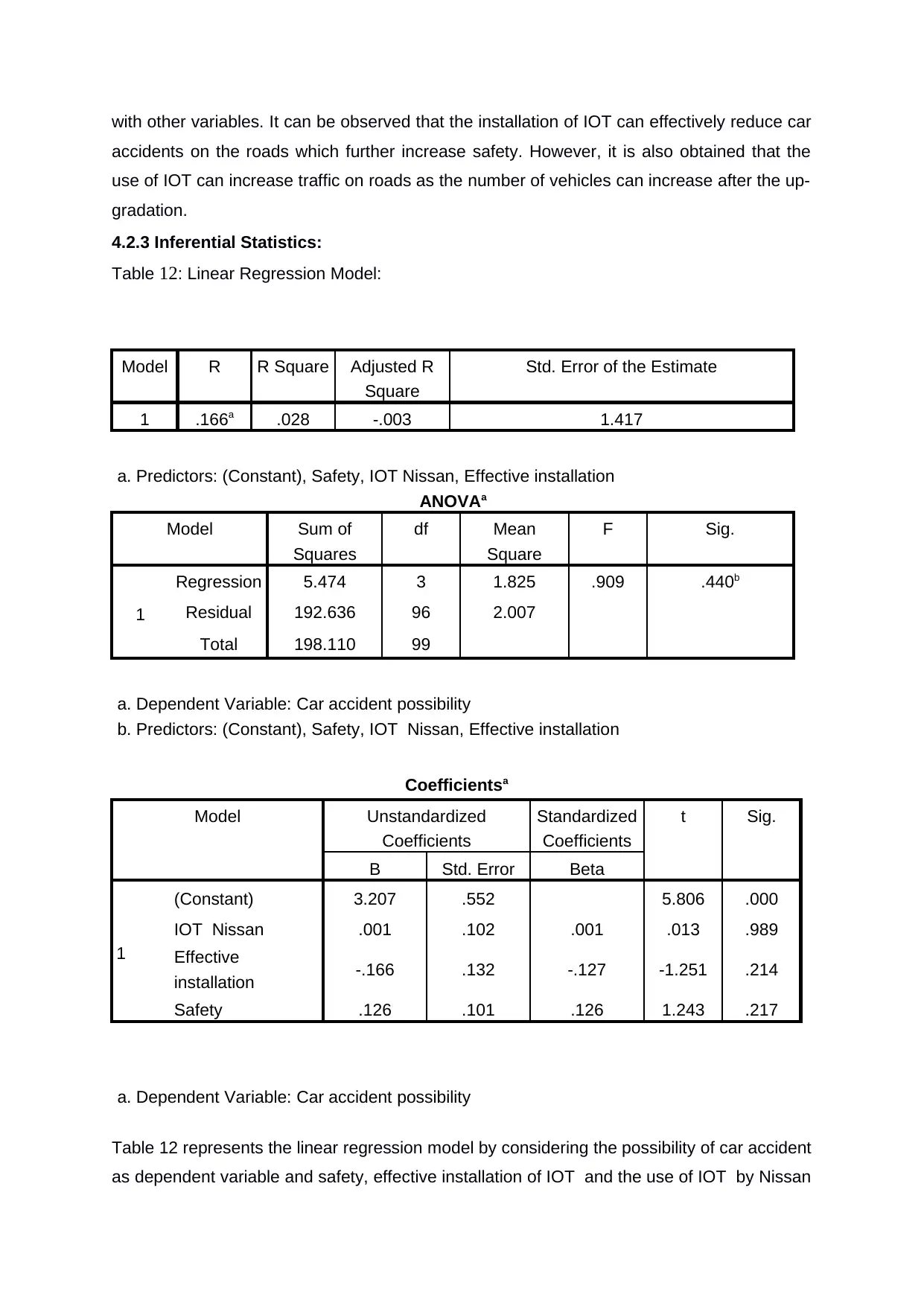
with other variables. It can be observed that the installation of IOT can effectively reduce car
accidents on the roads which further increase safety. However, it is also obtained that the
use of IOT can increase traffic on roads as the number of vehicles can increase after the up-
gradation.
4.2.3 Inferential Statistics:
Table 12: Linear Regression Model:
Model R R Square Adjusted R
Square
Std. Error of the Estimate
1 .166a .028 -.003 1.417
a. Predictors: (Constant), Safety, IOT Nissan, Effective installation
ANOVAa
Model Sum of
Squares
df Mean
Square
F Sig.
1
Regression 5.474 3 1.825 .909 .440b
Residual 192.636 96 2.007
Total 198.110 99
a. Dependent Variable: Car accident possibility
b. Predictors: (Constant), Safety, IOT Nissan, Effective installation
Coefficientsa
Model Unstandardized
Coefficients
Standardized
Coefficients
t Sig.
B Std. Error Beta
1
(Constant) 3.207 .552 5.806 .000
IOT Nissan .001 .102 .001 .013 .989
Effective
installation -.166 .132 -.127 -1.251 .214
Safety .126 .101 .126 1.243 .217
a. Dependent Variable: Car accident possibility
Table 12 represents the linear regression model by considering the possibility of car accident
as dependent variable and safety, effective installation of IOT and the use of IOT by Nissan
accidents on the roads which further increase safety. However, it is also obtained that the
use of IOT can increase traffic on roads as the number of vehicles can increase after the up-
gradation.
4.2.3 Inferential Statistics:
Table 12: Linear Regression Model:
Model R R Square Adjusted R
Square
Std. Error of the Estimate
1 .166a .028 -.003 1.417
a. Predictors: (Constant), Safety, IOT Nissan, Effective installation
ANOVAa
Model Sum of
Squares
df Mean
Square
F Sig.
1
Regression 5.474 3 1.825 .909 .440b
Residual 192.636 96 2.007
Total 198.110 99
a. Dependent Variable: Car accident possibility
b. Predictors: (Constant), Safety, IOT Nissan, Effective installation
Coefficientsa
Model Unstandardized
Coefficients
Standardized
Coefficients
t Sig.
B Std. Error Beta
1
(Constant) 3.207 .552 5.806 .000
IOT Nissan .001 .102 .001 .013 .989
Effective
installation -.166 .132 -.127 -1.251 .214
Safety .126 .101 .126 1.243 .217
a. Dependent Variable: Car accident possibility
Table 12 represents the linear regression model by considering the possibility of car accident
as dependent variable and safety, effective installation of IOT and the use of IOT by Nissan
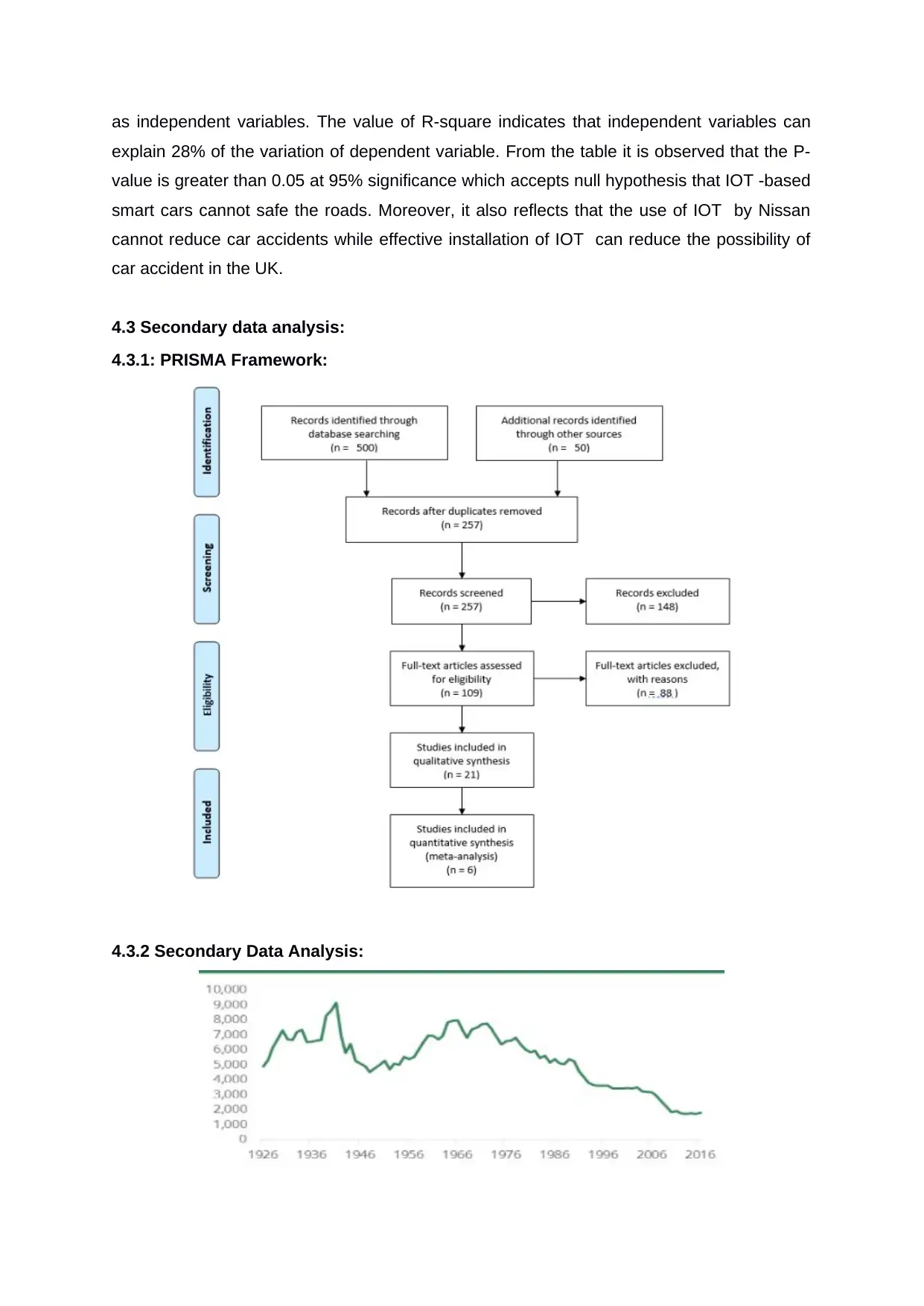
as independent variables. The value of R-square indicates that independent variables can
explain 28% of the variation of dependent variable. From the table it is observed that the P-
value is greater than 0.05 at 95% significance which accepts null hypothesis that IOT -based
smart cars cannot safe the roads. Moreover, it also reflects that the use of IOT by Nissan
cannot reduce car accidents while effective installation of IOT can reduce the possibility of
car accident in the UK.
4.3 Secondary data analysis:
4.3.1: PRISMA Framework:
4.3.2 Secondary Data Analysis:
explain 28% of the variation of dependent variable. From the table it is observed that the P-
value is greater than 0.05 at 95% significance which accepts null hypothesis that IOT -based
smart cars cannot safe the roads. Moreover, it also reflects that the use of IOT by Nissan
cannot reduce car accidents while effective installation of IOT can reduce the possibility of
car accident in the UK.
4.3 Secondary data analysis:
4.3.1: PRISMA Framework:
4.3.2 Secondary Data Analysis:
Paraphrase This Document
Need a fresh take? Get an instant paraphrase of this document with our AI Paraphraser
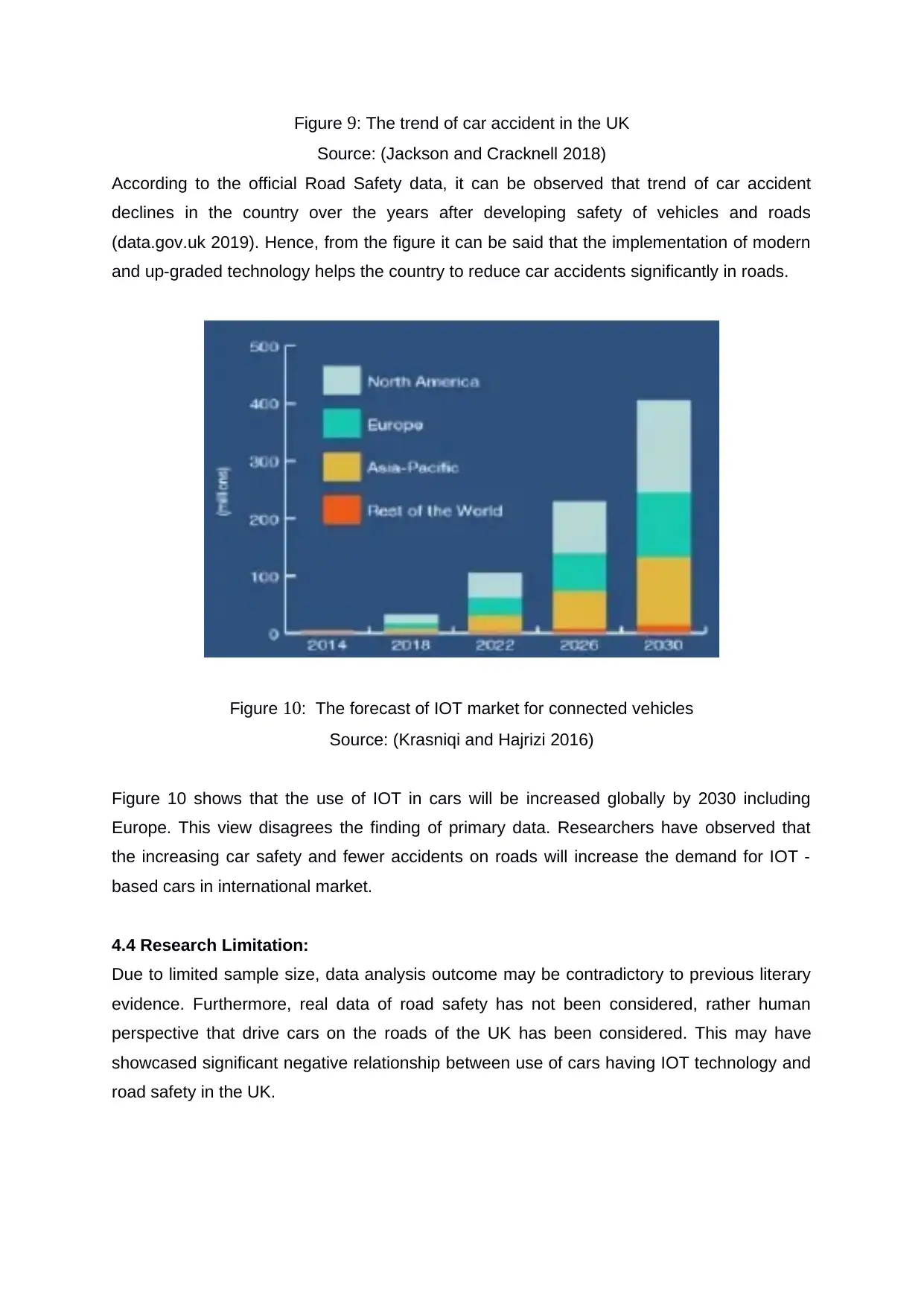
Figure 9: The trend of car accident in the UK
Source: (Jackson and Cracknell 2018)
According to the official Road Safety data, it can be observed that trend of car accident
declines in the country over the years after developing safety of vehicles and roads
(data.gov.uk 2019). Hence, from the figure it can be said that the implementation of modern
and up-graded technology helps the country to reduce car accidents significantly in roads.
Figure 10: The forecast of IOT market for connected vehicles
Source: (Krasniqi and Hajrizi 2016)
Figure 10 shows that the use of IOT in cars will be increased globally by 2030 including
Europe. This view disagrees the finding of primary data. Researchers have observed that
the increasing car safety and fewer accidents on roads will increase the demand for IOT -
based cars in international market.
4.4 Research Limitation:
Due to limited sample size, data analysis outcome may be contradictory to previous literary
evidence. Furthermore, real data of road safety has not been considered, rather human
perspective that drive cars on the roads of the UK has been considered. This may have
showcased significant negative relationship between use of cars having IOT technology and
road safety in the UK.
Source: (Jackson and Cracknell 2018)
According to the official Road Safety data, it can be observed that trend of car accident
declines in the country over the years after developing safety of vehicles and roads
(data.gov.uk 2019). Hence, from the figure it can be said that the implementation of modern
and up-graded technology helps the country to reduce car accidents significantly in roads.
Figure 10: The forecast of IOT market for connected vehicles
Source: (Krasniqi and Hajrizi 2016)
Figure 10 shows that the use of IOT in cars will be increased globally by 2030 including
Europe. This view disagrees the finding of primary data. Researchers have observed that
the increasing car safety and fewer accidents on roads will increase the demand for IOT -
based cars in international market.
4.4 Research Limitation:
Due to limited sample size, data analysis outcome may be contradictory to previous literary
evidence. Furthermore, real data of road safety has not been considered, rather human
perspective that drive cars on the roads of the UK has been considered. This may have
showcased significant negative relationship between use of cars having IOT technology and
road safety in the UK.
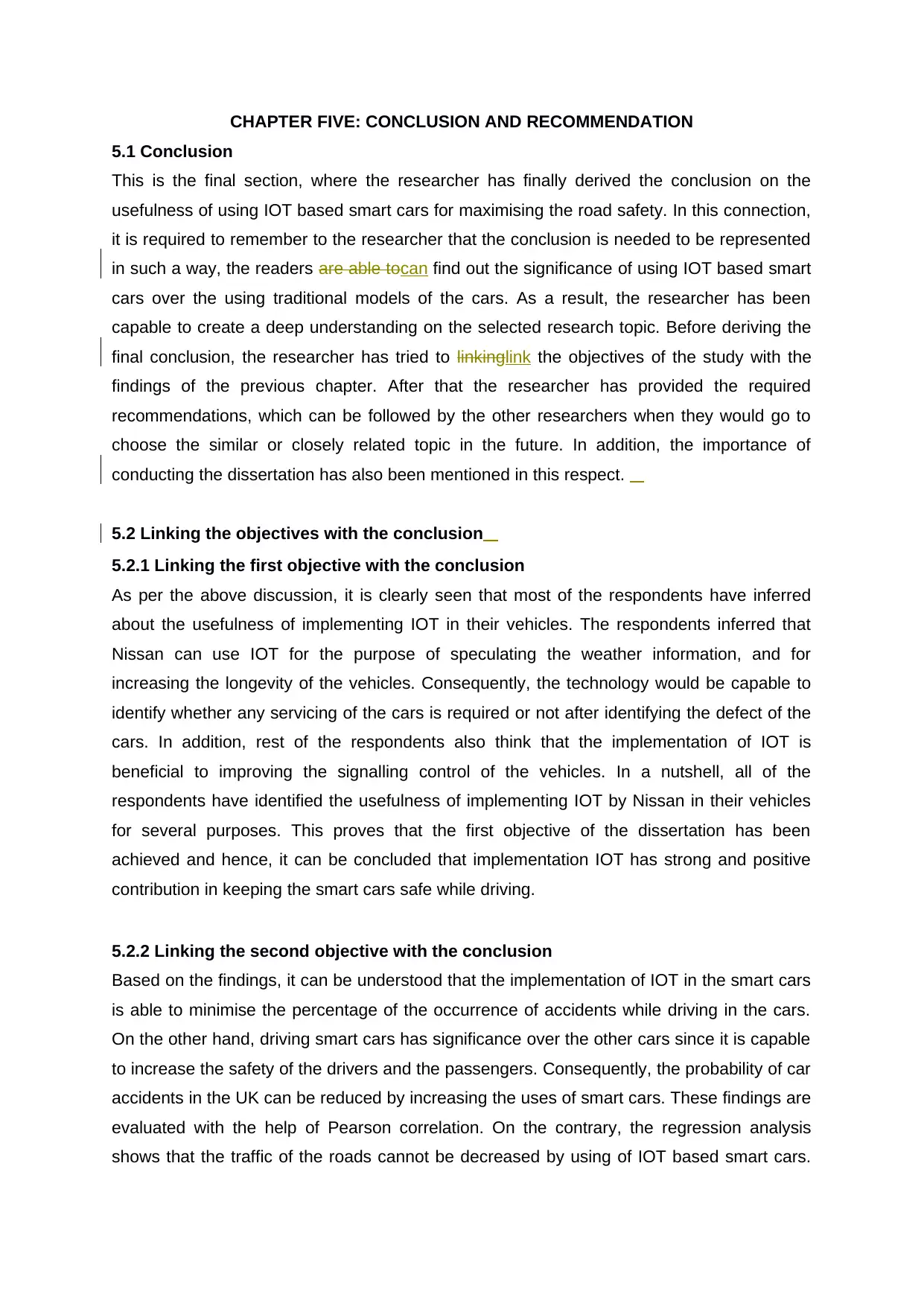
CHAPTER FIVE: CONCLUSION AND RECOMMENDATION
5.1 Conclusion
This is the final section, where the researcher has finally derived the conclusion on the
usefulness of using IOT based smart cars for maximising the road safety. In this connection,
it is required to remember to the researcher that the conclusion is needed to be represented
in such a way, the readers are able tocan find out the significance of using IOT based smart
cars over the using traditional models of the cars. As a result, the researcher has been
capable to create a deep understanding on the selected research topic. Before deriving the
final conclusion, the researcher has tried to linkinglink the objectives of the study with the
findings of the previous chapter. After that the researcher has provided the required
recommendations, which can be followed by the other researchers when they would go to
choose the similar or closely related topic in the future. In addition, the importance of
conducting the dissertation has also been mentioned in this respect.
5.2 Linking the objectives with the conclusion
5.2.1 Linking the first objective with the conclusion
As per the above discussion, it is clearly seen that most of the respondents have inferred
about the usefulness of implementing IOT in their vehicles. The respondents inferred that
Nissan can use IOT for the purpose of speculating the weather information, and for
increasing the longevity of the vehicles. Consequently, the technology would be capable to
identify whether any servicing of the cars is required or not after identifying the defect of the
cars. In addition, rest of the respondents also think that the implementation of IOT is
beneficial to improving the signalling control of the vehicles. In a nutshell, all of the
respondents have identified the usefulness of implementing IOT by Nissan in their vehicles
for several purposes. This proves that the first objective of the dissertation has been
achieved and hence, it can be concluded that implementation IOT has strong and positive
contribution in keeping the smart cars safe while driving.
5.2.2 Linking the second objective with the conclusion
Based on the findings, it can be understood that the implementation of IOT in the smart cars
is able to minimise the percentage of the occurrence of accidents while driving in the cars.
On the other hand, driving smart cars has significance over the other cars since it is capable
to increase the safety of the drivers and the passengers. Consequently, the probability of car
accidents in the UK can be reduced by increasing the uses of smart cars. These findings are
evaluated with the help of Pearson correlation. On the contrary, the regression analysis
shows that the traffic of the roads cannot be decreased by using of IOT based smart cars.
5.1 Conclusion
This is the final section, where the researcher has finally derived the conclusion on the
usefulness of using IOT based smart cars for maximising the road safety. In this connection,
it is required to remember to the researcher that the conclusion is needed to be represented
in such a way, the readers are able tocan find out the significance of using IOT based smart
cars over the using traditional models of the cars. As a result, the researcher has been
capable to create a deep understanding on the selected research topic. Before deriving the
final conclusion, the researcher has tried to linkinglink the objectives of the study with the
findings of the previous chapter. After that the researcher has provided the required
recommendations, which can be followed by the other researchers when they would go to
choose the similar or closely related topic in the future. In addition, the importance of
conducting the dissertation has also been mentioned in this respect.
5.2 Linking the objectives with the conclusion
5.2.1 Linking the first objective with the conclusion
As per the above discussion, it is clearly seen that most of the respondents have inferred
about the usefulness of implementing IOT in their vehicles. The respondents inferred that
Nissan can use IOT for the purpose of speculating the weather information, and for
increasing the longevity of the vehicles. Consequently, the technology would be capable to
identify whether any servicing of the cars is required or not after identifying the defect of the
cars. In addition, rest of the respondents also think that the implementation of IOT is
beneficial to improving the signalling control of the vehicles. In a nutshell, all of the
respondents have identified the usefulness of implementing IOT by Nissan in their vehicles
for several purposes. This proves that the first objective of the dissertation has been
achieved and hence, it can be concluded that implementation IOT has strong and positive
contribution in keeping the smart cars safe while driving.
5.2.2 Linking the second objective with the conclusion
Based on the findings, it can be understood that the implementation of IOT in the smart cars
is able to minimise the percentage of the occurrence of accidents while driving in the cars.
On the other hand, driving smart cars has significance over the other cars since it is capable
to increase the safety of the drivers and the passengers. Consequently, the probability of car
accidents in the UK can be reduced by increasing the uses of smart cars. These findings are
evaluated with the help of Pearson correlation. On the contrary, the regression analysis
shows that the traffic of the roads cannot be decreased by using of IOT based smart cars.
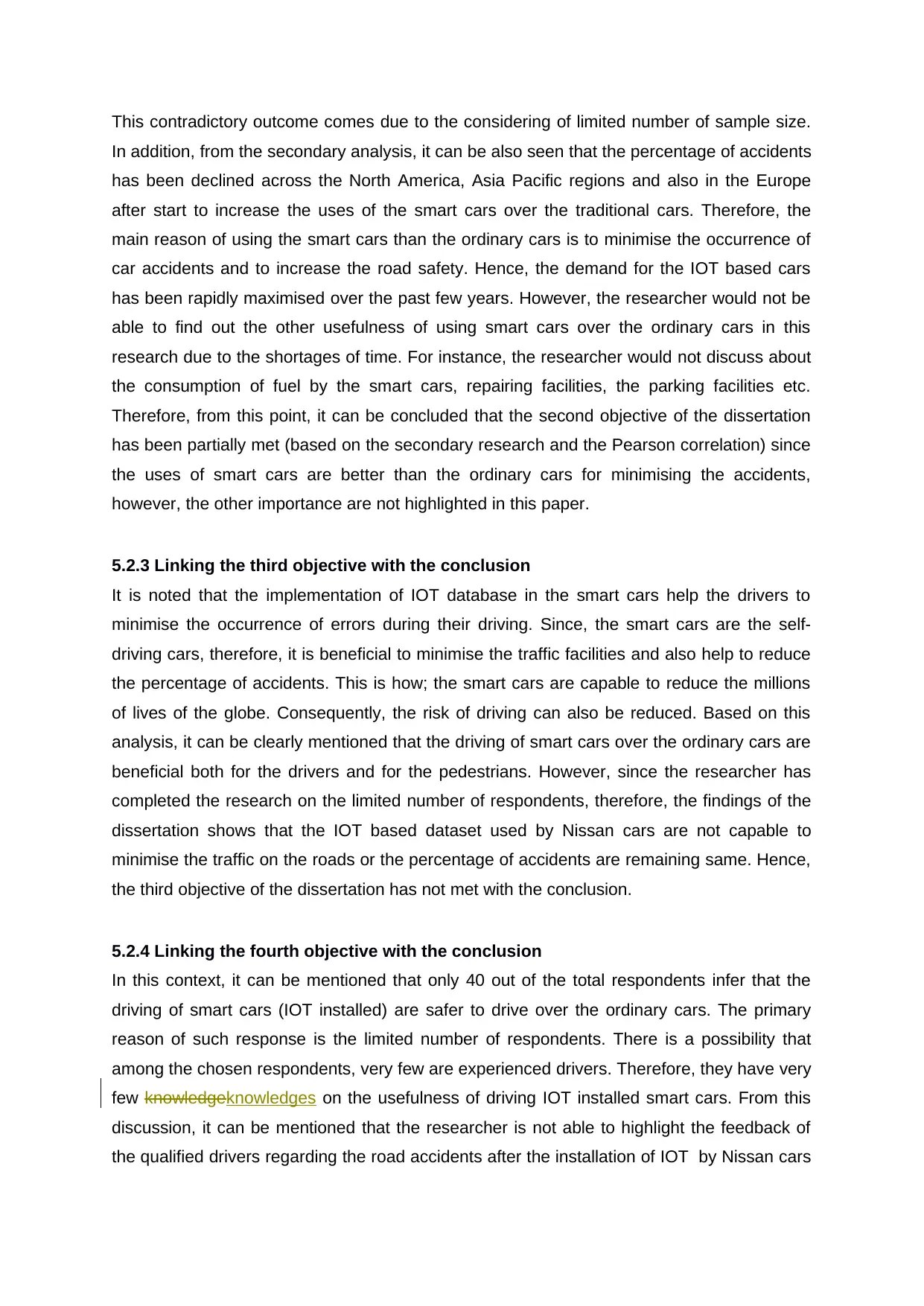
This contradictory outcome comes due to the considering of limited number of sample size.
In addition, from the secondary analysis, it can be also seen that the percentage of accidents
has been declined across the North America, Asia Pacific regions and also in the Europe
after start to increase the uses of the smart cars over the traditional cars. Therefore, the
main reason of using the smart cars than the ordinary cars is to minimise the occurrence of
car accidents and to increase the road safety. Hence, the demand for the IOT based cars
has been rapidly maximised over the past few years. However, the researcher would not be
able to find out the other usefulness of using smart cars over the ordinary cars in this
research due to the shortages of time. For instance, the researcher would not discuss about
the consumption of fuel by the smart cars, repairing facilities, the parking facilities etc.
Therefore, from this point, it can be concluded that the second objective of the dissertation
has been partially met (based on the secondary research and the Pearson correlation) since
the uses of smart cars are better than the ordinary cars for minimising the accidents,
however, the other importance are not highlighted in this paper.
5.2.3 Linking the third objective with the conclusion
It is noted that the implementation of IOT database in the smart cars help the drivers to
minimise the occurrence of errors during their driving. Since, the smart cars are the self-
driving cars, therefore, it is beneficial to minimise the traffic facilities and also help to reduce
the percentage of accidents. This is how; the smart cars are capable to reduce the millions
of lives of the globe. Consequently, the risk of driving can also be reduced. Based on this
analysis, it can be clearly mentioned that the driving of smart cars over the ordinary cars are
beneficial both for the drivers and for the pedestrians. However, since the researcher has
completed the research on the limited number of respondents, therefore, the findings of the
dissertation shows that the IOT based dataset used by Nissan cars are not capable to
minimise the traffic on the roads or the percentage of accidents are remaining same. Hence,
the third objective of the dissertation has not met with the conclusion.
5.2.4 Linking the fourth objective with the conclusion
In this context, it can be mentioned that only 40 out of the total respondents infer that the
driving of smart cars (IOT installed) are safer to drive over the ordinary cars. The primary
reason of such response is the limited number of respondents. There is a possibility that
among the chosen respondents, very few are experienced drivers. Therefore, they have very
few knowledgeknowledges on the usefulness of driving IOT installed smart cars. From this
discussion, it can be mentioned that the researcher is not able to highlight the feedback of
the qualified drivers regarding the road accidents after the installation of IOT by Nissan cars
In addition, from the secondary analysis, it can be also seen that the percentage of accidents
has been declined across the North America, Asia Pacific regions and also in the Europe
after start to increase the uses of the smart cars over the traditional cars. Therefore, the
main reason of using the smart cars than the ordinary cars is to minimise the occurrence of
car accidents and to increase the road safety. Hence, the demand for the IOT based cars
has been rapidly maximised over the past few years. However, the researcher would not be
able to find out the other usefulness of using smart cars over the ordinary cars in this
research due to the shortages of time. For instance, the researcher would not discuss about
the consumption of fuel by the smart cars, repairing facilities, the parking facilities etc.
Therefore, from this point, it can be concluded that the second objective of the dissertation
has been partially met (based on the secondary research and the Pearson correlation) since
the uses of smart cars are better than the ordinary cars for minimising the accidents,
however, the other importance are not highlighted in this paper.
5.2.3 Linking the third objective with the conclusion
It is noted that the implementation of IOT database in the smart cars help the drivers to
minimise the occurrence of errors during their driving. Since, the smart cars are the self-
driving cars, therefore, it is beneficial to minimise the traffic facilities and also help to reduce
the percentage of accidents. This is how; the smart cars are capable to reduce the millions
of lives of the globe. Consequently, the risk of driving can also be reduced. Based on this
analysis, it can be clearly mentioned that the driving of smart cars over the ordinary cars are
beneficial both for the drivers and for the pedestrians. However, since the researcher has
completed the research on the limited number of respondents, therefore, the findings of the
dissertation shows that the IOT based dataset used by Nissan cars are not capable to
minimise the traffic on the roads or the percentage of accidents are remaining same. Hence,
the third objective of the dissertation has not met with the conclusion.
5.2.4 Linking the fourth objective with the conclusion
In this context, it can be mentioned that only 40 out of the total respondents infer that the
driving of smart cars (IOT installed) are safer to drive over the ordinary cars. The primary
reason of such response is the limited number of respondents. There is a possibility that
among the chosen respondents, very few are experienced drivers. Therefore, they have very
few knowledgeknowledges on the usefulness of driving IOT installed smart cars. From this
discussion, it can be mentioned that the researcher is not able to highlight the feedback of
the qualified drivers regarding the road accidents after the installation of IOT by Nissan cars
Secure Best Marks with AI Grader
Need help grading? Try our AI Grader for instant feedback on your assignments.
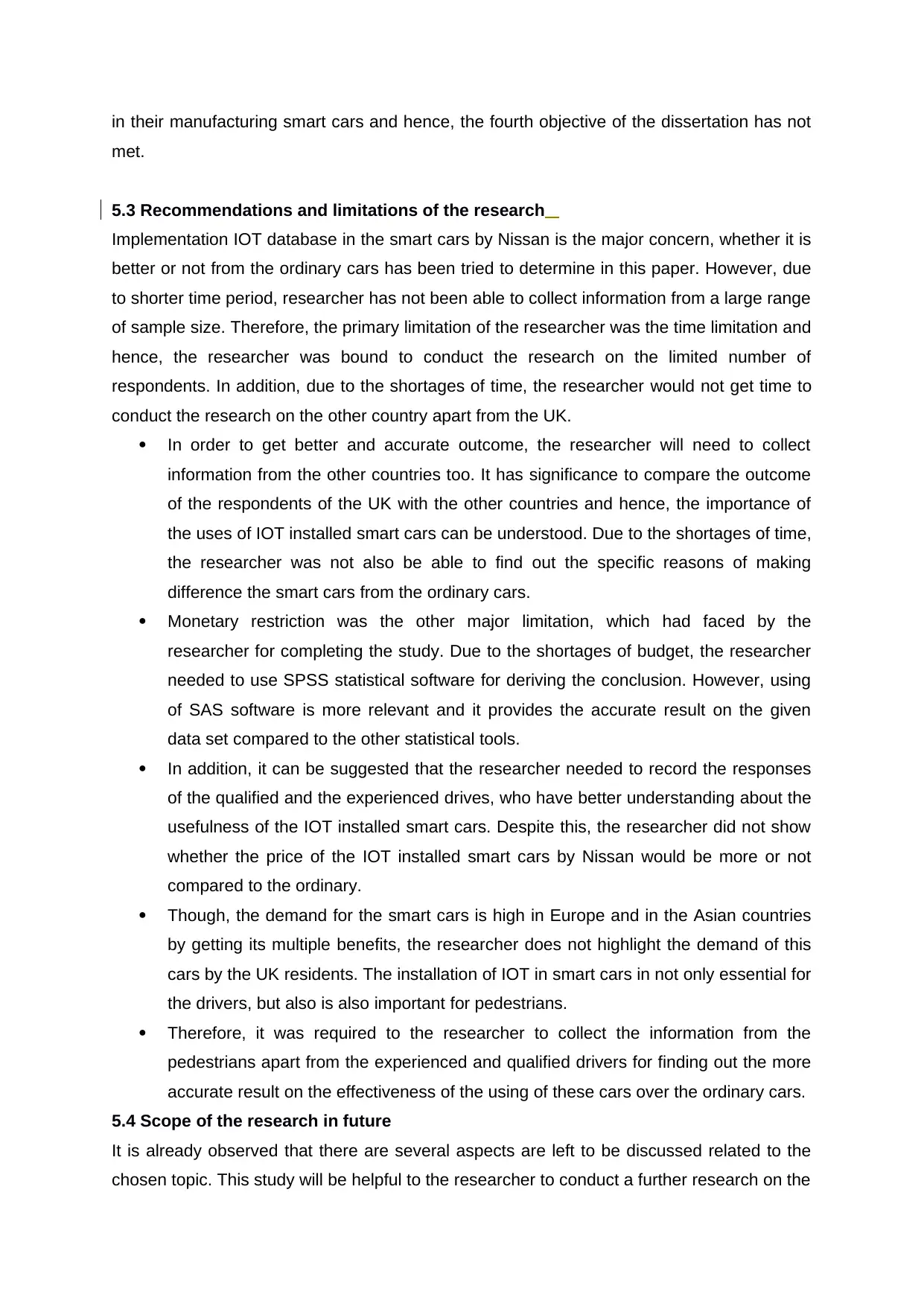
in their manufacturing smart cars and hence, the fourth objective of the dissertation has not
met.
5.3 Recommendations and limitations of the research
Implementation IOT database in the smart cars by Nissan is the major concern, whether it is
better or not from the ordinary cars has been tried to determine in this paper. However, due
to shorter time period, researcher has not been able to collect information from a large range
of sample size. Therefore, the primary limitation of the researcher was the time limitation and
hence, the researcher was bound to conduct the research on the limited number of
respondents. In addition, due to the shortages of time, the researcher would not get time to
conduct the research on the other country apart from the UK.
In order to get better and accurate outcome, the researcher will need to collect
information from the other countries too. It has significance to compare the outcome
of the respondents of the UK with the other countries and hence, the importance of
the uses of IOT installed smart cars can be understood. Due to the shortages of time,
the researcher was not also be able to find out the specific reasons of making
difference the smart cars from the ordinary cars.
Monetary restriction was the other major limitation, which had faced by the
researcher for completing the study. Due to the shortages of budget, the researcher
needed to use SPSS statistical software for deriving the conclusion. However, using
of SAS software is more relevant and it provides the accurate result on the given
data set compared to the other statistical tools.
In addition, it can be suggested that the researcher needed to record the responses
of the qualified and the experienced drives, who have better understanding about the
usefulness of the IOT installed smart cars. Despite this, the researcher did not show
whether the price of the IOT installed smart cars by Nissan would be more or not
compared to the ordinary.
Though, the demand for the smart cars is high in Europe and in the Asian countries
by getting its multiple benefits, the researcher does not highlight the demand of this
cars by the UK residents. The installation of IOT in smart cars in not only essential for
the drivers, but also is also important for pedestrians.
Therefore, it was required to the researcher to collect the information from the
pedestrians apart from the experienced and qualified drivers for finding out the more
accurate result on the effectiveness of the using of these cars over the ordinary cars.
5.4 Scope of the research in future
It is already observed that there are several aspects are left to be discussed related to the
chosen topic. This study will be helpful to the researcher to conduct a further research on the
met.
5.3 Recommendations and limitations of the research
Implementation IOT database in the smart cars by Nissan is the major concern, whether it is
better or not from the ordinary cars has been tried to determine in this paper. However, due
to shorter time period, researcher has not been able to collect information from a large range
of sample size. Therefore, the primary limitation of the researcher was the time limitation and
hence, the researcher was bound to conduct the research on the limited number of
respondents. In addition, due to the shortages of time, the researcher would not get time to
conduct the research on the other country apart from the UK.
In order to get better and accurate outcome, the researcher will need to collect
information from the other countries too. It has significance to compare the outcome
of the respondents of the UK with the other countries and hence, the importance of
the uses of IOT installed smart cars can be understood. Due to the shortages of time,
the researcher was not also be able to find out the specific reasons of making
difference the smart cars from the ordinary cars.
Monetary restriction was the other major limitation, which had faced by the
researcher for completing the study. Due to the shortages of budget, the researcher
needed to use SPSS statistical software for deriving the conclusion. However, using
of SAS software is more relevant and it provides the accurate result on the given
data set compared to the other statistical tools.
In addition, it can be suggested that the researcher needed to record the responses
of the qualified and the experienced drives, who have better understanding about the
usefulness of the IOT installed smart cars. Despite this, the researcher did not show
whether the price of the IOT installed smart cars by Nissan would be more or not
compared to the ordinary.
Though, the demand for the smart cars is high in Europe and in the Asian countries
by getting its multiple benefits, the researcher does not highlight the demand of this
cars by the UK residents. The installation of IOT in smart cars in not only essential for
the drivers, but also is also important for pedestrians.
Therefore, it was required to the researcher to collect the information from the
pedestrians apart from the experienced and qualified drivers for finding out the more
accurate result on the effectiveness of the using of these cars over the ordinary cars.
5.4 Scope of the research in future
It is already observed that there are several aspects are left to be discussed related to the
chosen topic. This study will be helpful to the researcher to conduct a further research on the

similar topic and the researcher will keep aside the flaws of this dissertation. Therefore, the
topics, which are not covered in this paper, can be highlighted in their future studies. In
addition, other researchers will be able to use the result of this dissertation as the secondary
source in their own research as well as for completing the literature review section. The
future scholars can also conduct their research papers on other countries as well.
topics, which are not covered in this paper, can be highlighted in their future studies. In
addition, other researchers will be able to use the result of this dissertation as the secondary
source in their own research as well as for completing the literature review section. The
future scholars can also conduct their research papers on other countries as well.
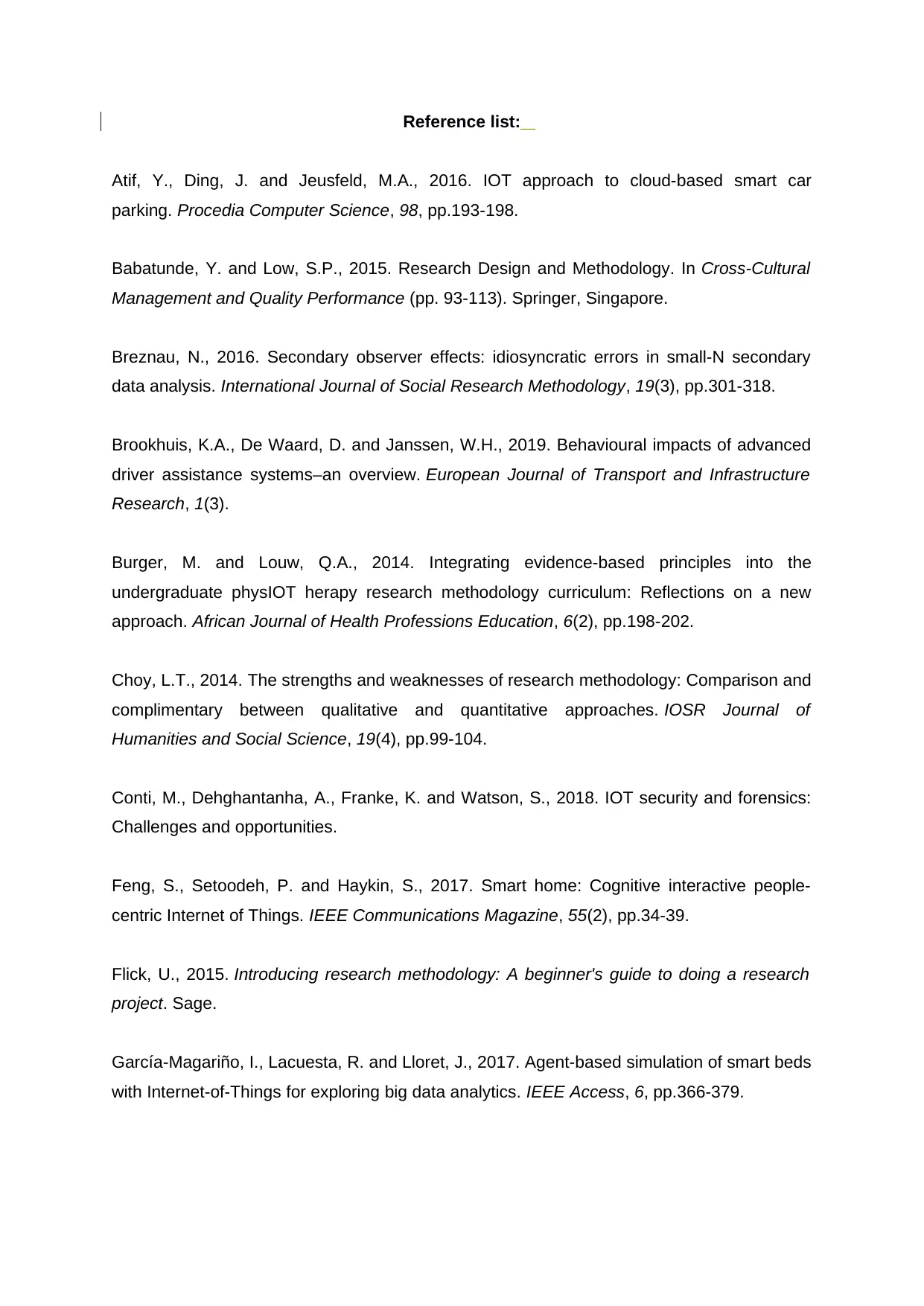
Reference list:
Atif, Y., Ding, J. and Jeusfeld, M.A., 2016. IOT approach to cloud-based smart car
parking. Procedia Computer Science, 98, pp.193-198.
Babatunde, Y. and Low, S.P., 2015. Research Design and Methodology. In Cross-Cultural
Management and Quality Performance (pp. 93-113). Springer, Singapore.
Breznau, N., 2016. Secondary observer effects: idiosyncratic errors in small-N secondary
data analysis. International Journal of Social Research Methodology, 19(3), pp.301-318.
Brookhuis, K.A., De Waard, D. and Janssen, W.H., 2019. Behavioural impacts of advanced
driver assistance systems–an overview. European Journal of Transport and Infrastructure
Research, 1(3).
Burger, M. and Louw, Q.A., 2014. Integrating evidence-based principles into the
undergraduate physIOT herapy research methodology curriculum: Reflections on a new
approach. African Journal of Health Professions Education, 6(2), pp.198-202.
Choy, L.T., 2014. The strengths and weaknesses of research methodology: Comparison and
complimentary between qualitative and quantitative approaches. IOSR Journal of
Humanities and Social Science, 19(4), pp.99-104.
Conti, M., Dehghantanha, A., Franke, K. and Watson, S., 2018. IOT security and forensics:
Challenges and opportunities.
Feng, S., Setoodeh, P. and Haykin, S., 2017. Smart home: Cognitive interactive people-
centric Internet of Things. IEEE Communications Magazine, 55(2), pp.34-39.
Flick, U., 2015. Introducing research methodology: A beginner's guide to doing a research
project. Sage.
García-Magariño, I., Lacuesta, R. and Lloret, J., 2017. Agent-based simulation of smart beds
with Internet-of-Things for exploring big data analytics. IEEE Access, 6, pp.366-379.
Atif, Y., Ding, J. and Jeusfeld, M.A., 2016. IOT approach to cloud-based smart car
parking. Procedia Computer Science, 98, pp.193-198.
Babatunde, Y. and Low, S.P., 2015. Research Design and Methodology. In Cross-Cultural
Management and Quality Performance (pp. 93-113). Springer, Singapore.
Breznau, N., 2016. Secondary observer effects: idiosyncratic errors in small-N secondary
data analysis. International Journal of Social Research Methodology, 19(3), pp.301-318.
Brookhuis, K.A., De Waard, D. and Janssen, W.H., 2019. Behavioural impacts of advanced
driver assistance systems–an overview. European Journal of Transport and Infrastructure
Research, 1(3).
Burger, M. and Louw, Q.A., 2014. Integrating evidence-based principles into the
undergraduate physIOT herapy research methodology curriculum: Reflections on a new
approach. African Journal of Health Professions Education, 6(2), pp.198-202.
Choy, L.T., 2014. The strengths and weaknesses of research methodology: Comparison and
complimentary between qualitative and quantitative approaches. IOSR Journal of
Humanities and Social Science, 19(4), pp.99-104.
Conti, M., Dehghantanha, A., Franke, K. and Watson, S., 2018. IOT security and forensics:
Challenges and opportunities.
Feng, S., Setoodeh, P. and Haykin, S., 2017. Smart home: Cognitive interactive people-
centric Internet of Things. IEEE Communications Magazine, 55(2), pp.34-39.
Flick, U., 2015. Introducing research methodology: A beginner's guide to doing a research
project. Sage.
García-Magariño, I., Lacuesta, R. and Lloret, J., 2017. Agent-based simulation of smart beds
with Internet-of-Things for exploring big data analytics. IEEE Access, 6, pp.366-379.
Paraphrase This Document
Need a fresh take? Get an instant paraphrase of this document with our AI Paraphraser
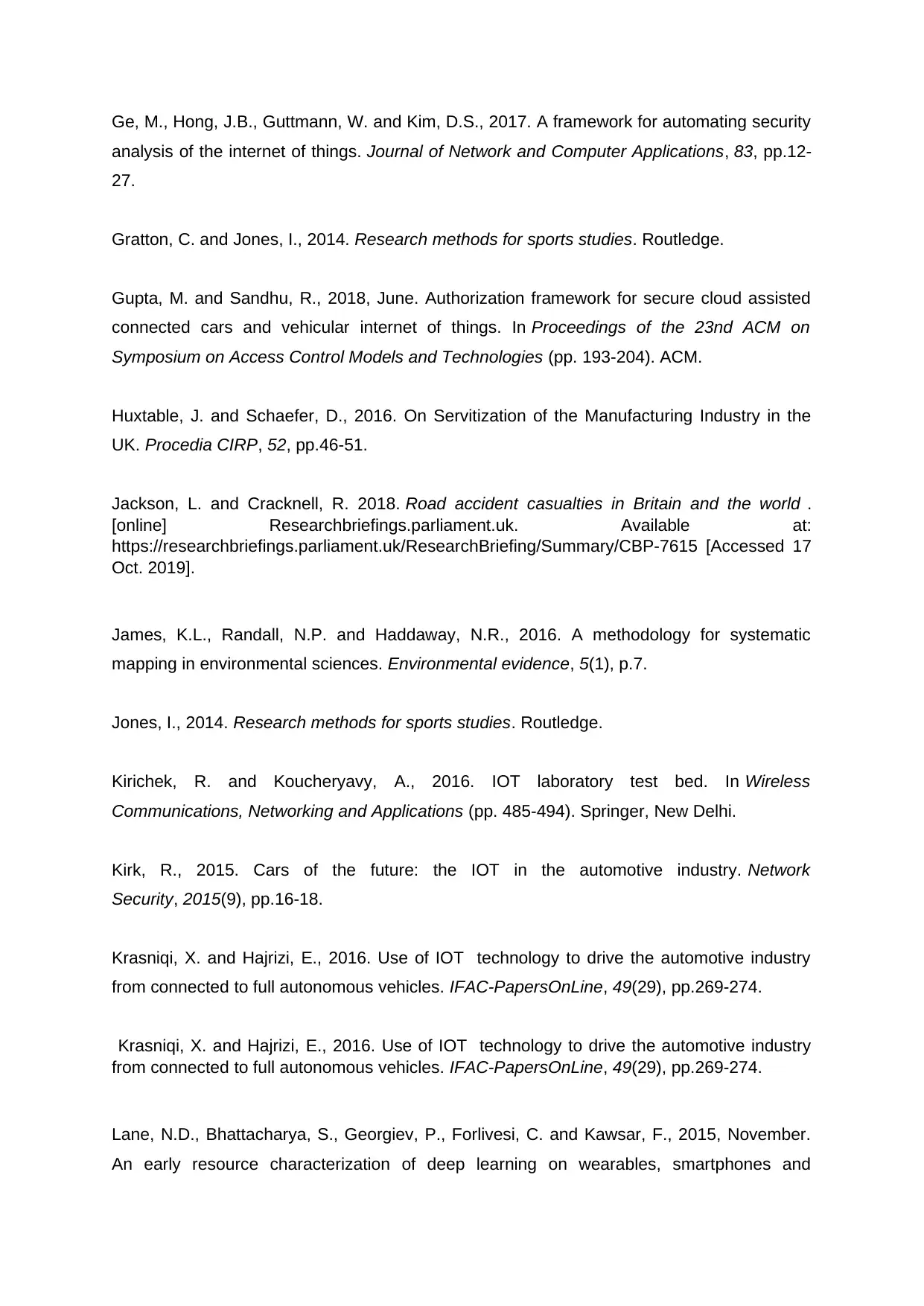
Ge, M., Hong, J.B., Guttmann, W. and Kim, D.S., 2017. A framework for automating security
analysis of the internet of things. Journal of Network and Computer Applications, 83, pp.12-
27.
Gratton, C. and Jones, I., 2014. Research methods for sports studies. Routledge.
Gupta, M. and Sandhu, R., 2018, June. Authorization framework for secure cloud assisted
connected cars and vehicular internet of things. In Proceedings of the 23nd ACM on
Symposium on Access Control Models and Technologies (pp. 193-204). ACM.
Huxtable, J. and Schaefer, D., 2016. On Servitization of the Manufacturing Industry in the
UK. Procedia CIRP, 52, pp.46-51.
Jackson, L. and Cracknell, R. 2018. Road accident casualties in Britain and the world .
[online] Researchbriefings.parliament.uk. Available at:
https://researchbriefings.parliament.uk/ResearchBriefing/Summary/CBP-7615 [Accessed 17
Oct. 2019].
James, K.L., Randall, N.P. and Haddaway, N.R., 2016. A methodology for systematic
mapping in environmental sciences. Environmental evidence, 5(1), p.7.
Jones, I., 2014. Research methods for sports studies. Routledge.
Kirichek, R. and Koucheryavy, A., 2016. IOT laboratory test bed. In Wireless
Communications, Networking and Applications (pp. 485-494). Springer, New Delhi.
Kirk, R., 2015. Cars of the future: the IOT in the automotive industry. Network
Security, 2015(9), pp.16-18.
Krasniqi, X. and Hajrizi, E., 2016. Use of IOT technology to drive the automotive industry
from connected to full autonomous vehicles. IFAC-PapersOnLine, 49(29), pp.269-274.
Krasniqi, X. and Hajrizi, E., 2016. Use of IOT technology to drive the automotive industry
from connected to full autonomous vehicles. IFAC-PapersOnLine, 49(29), pp.269-274.
Lane, N.D., Bhattacharya, S., Georgiev, P., Forlivesi, C. and Kawsar, F., 2015, November.
An early resource characterization of deep learning on wearables, smartphones and
analysis of the internet of things. Journal of Network and Computer Applications, 83, pp.12-
27.
Gratton, C. and Jones, I., 2014. Research methods for sports studies. Routledge.
Gupta, M. and Sandhu, R., 2018, June. Authorization framework for secure cloud assisted
connected cars and vehicular internet of things. In Proceedings of the 23nd ACM on
Symposium on Access Control Models and Technologies (pp. 193-204). ACM.
Huxtable, J. and Schaefer, D., 2016. On Servitization of the Manufacturing Industry in the
UK. Procedia CIRP, 52, pp.46-51.
Jackson, L. and Cracknell, R. 2018. Road accident casualties in Britain and the world .
[online] Researchbriefings.parliament.uk. Available at:
https://researchbriefings.parliament.uk/ResearchBriefing/Summary/CBP-7615 [Accessed 17
Oct. 2019].
James, K.L., Randall, N.P. and Haddaway, N.R., 2016. A methodology for systematic
mapping in environmental sciences. Environmental evidence, 5(1), p.7.
Jones, I., 2014. Research methods for sports studies. Routledge.
Kirichek, R. and Koucheryavy, A., 2016. IOT laboratory test bed. In Wireless
Communications, Networking and Applications (pp. 485-494). Springer, New Delhi.
Kirk, R., 2015. Cars of the future: the IOT in the automotive industry. Network
Security, 2015(9), pp.16-18.
Krasniqi, X. and Hajrizi, E., 2016. Use of IOT technology to drive the automotive industry
from connected to full autonomous vehicles. IFAC-PapersOnLine, 49(29), pp.269-274.
Krasniqi, X. and Hajrizi, E., 2016. Use of IOT technology to drive the automotive industry
from connected to full autonomous vehicles. IFAC-PapersOnLine, 49(29), pp.269-274.
Lane, N.D., Bhattacharya, S., Georgiev, P., Forlivesi, C. and Kawsar, F., 2015, November.
An early resource characterization of deep learning on wearables, smartphones and
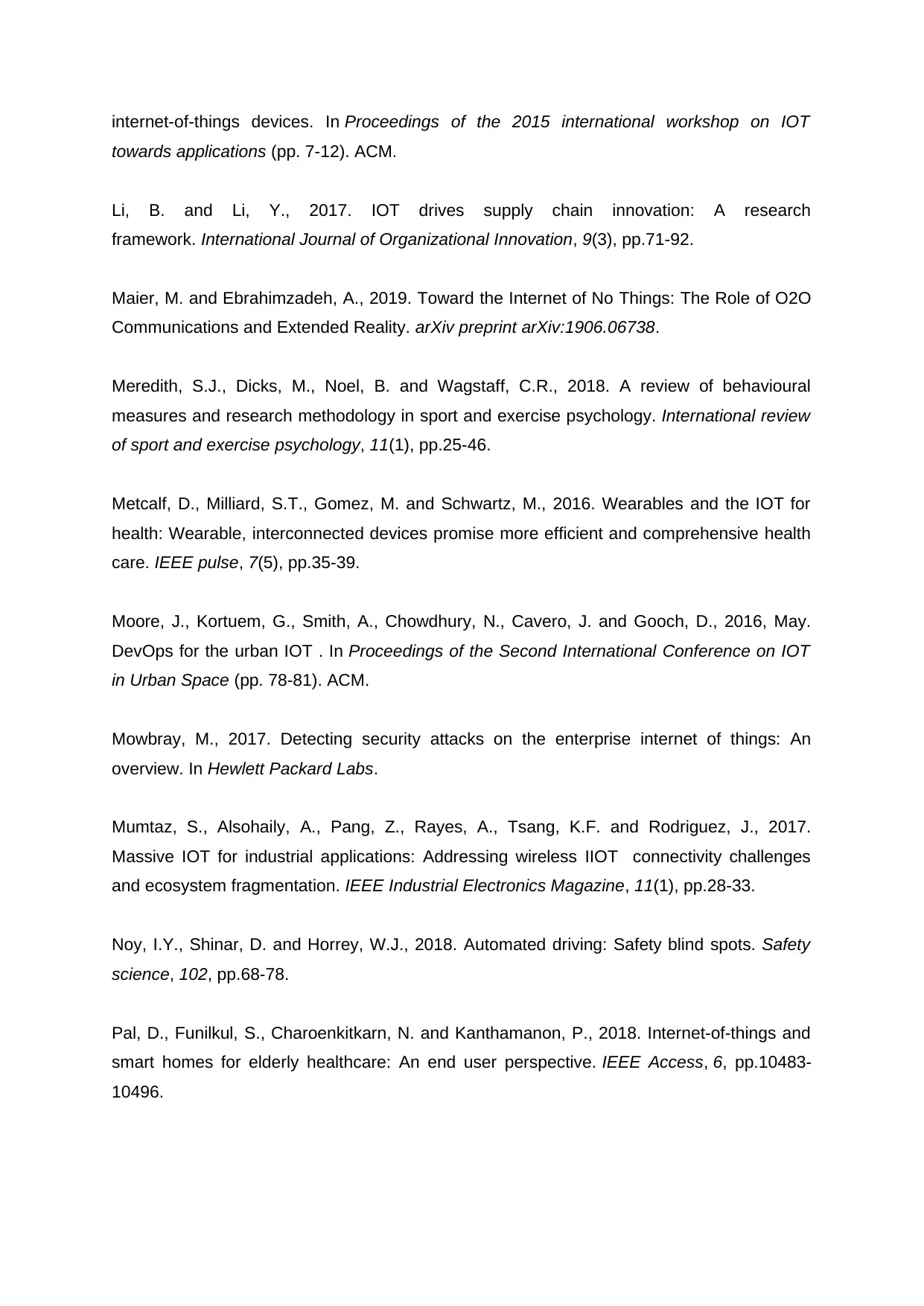
internet-of-things devices. In Proceedings of the 2015 international workshop on IOT
towards applications (pp. 7-12). ACM.
Li, B. and Li, Y., 2017. IOT drives supply chain innovation: A research
framework. International Journal of Organizational Innovation, 9(3), pp.71-92.
Maier, M. and Ebrahimzadeh, A., 2019. Toward the Internet of No Things: The Role of O2O
Communications and Extended Reality. arXiv preprint arXiv:1906.06738.
Meredith, S.J., Dicks, M., Noel, B. and Wagstaff, C.R., 2018. A review of behavioural
measures and research methodology in sport and exercise psychology. International review
of sport and exercise psychology, 11(1), pp.25-46.
Metcalf, D., Milliard, S.T., Gomez, M. and Schwartz, M., 2016. Wearables and the IOT for
health: Wearable, interconnected devices promise more efficient and comprehensive health
care. IEEE pulse, 7(5), pp.35-39.
Moore, J., Kortuem, G., Smith, A., Chowdhury, N., Cavero, J. and Gooch, D., 2016, May.
DevOps for the urban IOT . In Proceedings of the Second International Conference on IOT
in Urban Space (pp. 78-81). ACM.
Mowbray, M., 2017. Detecting security attacks on the enterprise internet of things: An
overview. In Hewlett Packard Labs.
Mumtaz, S., Alsohaily, A., Pang, Z., Rayes, A., Tsang, K.F. and Rodriguez, J., 2017.
Massive IOT for industrial applications: Addressing wireless IIOT connectivity challenges
and ecosystem fragmentation. IEEE Industrial Electronics Magazine, 11(1), pp.28-33.
Noy, I.Y., Shinar, D. and Horrey, W.J., 2018. Automated driving: Safety blind spots. Safety
science, 102, pp.68-78.
Pal, D., Funilkul, S., Charoenkitkarn, N. and Kanthamanon, P., 2018. Internet-of-things and
smart homes for elderly healthcare: An end user perspective. IEEE Access, 6, pp.10483-
10496.
towards applications (pp. 7-12). ACM.
Li, B. and Li, Y., 2017. IOT drives supply chain innovation: A research
framework. International Journal of Organizational Innovation, 9(3), pp.71-92.
Maier, M. and Ebrahimzadeh, A., 2019. Toward the Internet of No Things: The Role of O2O
Communications and Extended Reality. arXiv preprint arXiv:1906.06738.
Meredith, S.J., Dicks, M., Noel, B. and Wagstaff, C.R., 2018. A review of behavioural
measures and research methodology in sport and exercise psychology. International review
of sport and exercise psychology, 11(1), pp.25-46.
Metcalf, D., Milliard, S.T., Gomez, M. and Schwartz, M., 2016. Wearables and the IOT for
health: Wearable, interconnected devices promise more efficient and comprehensive health
care. IEEE pulse, 7(5), pp.35-39.
Moore, J., Kortuem, G., Smith, A., Chowdhury, N., Cavero, J. and Gooch, D., 2016, May.
DevOps for the urban IOT . In Proceedings of the Second International Conference on IOT
in Urban Space (pp. 78-81). ACM.
Mowbray, M., 2017. Detecting security attacks on the enterprise internet of things: An
overview. In Hewlett Packard Labs.
Mumtaz, S., Alsohaily, A., Pang, Z., Rayes, A., Tsang, K.F. and Rodriguez, J., 2017.
Massive IOT for industrial applications: Addressing wireless IIOT connectivity challenges
and ecosystem fragmentation. IEEE Industrial Electronics Magazine, 11(1), pp.28-33.
Noy, I.Y., Shinar, D. and Horrey, W.J., 2018. Automated driving: Safety blind spots. Safety
science, 102, pp.68-78.
Pal, D., Funilkul, S., Charoenkitkarn, N. and Kanthamanon, P., 2018. Internet-of-things and
smart homes for elderly healthcare: An end user perspective. IEEE Access, 6, pp.10483-
10496.
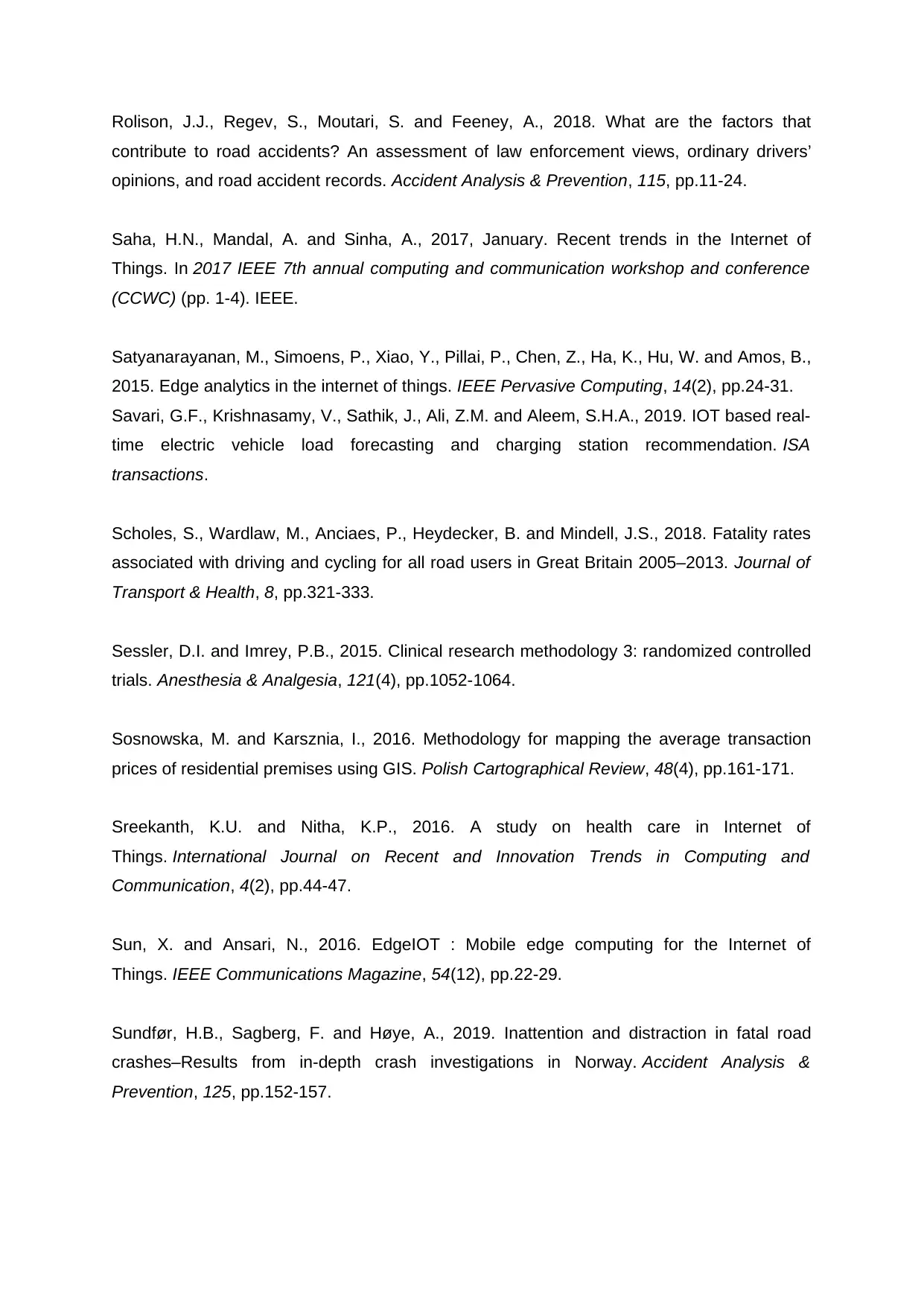
Rolison, J.J., Regev, S., Moutari, S. and Feeney, A., 2018. What are the factors that
contribute to road accidents? An assessment of law enforcement views, ordinary drivers’
opinions, and road accident records. Accident Analysis & Prevention, 115, pp.11-24.
Saha, H.N., Mandal, A. and Sinha, A., 2017, January. Recent trends in the Internet of
Things. In 2017 IEEE 7th annual computing and communication workshop and conference
(CCWC) (pp. 1-4). IEEE.
Satyanarayanan, M., Simoens, P., Xiao, Y., Pillai, P., Chen, Z., Ha, K., Hu, W. and Amos, B.,
2015. Edge analytics in the internet of things. IEEE Pervasive Computing, 14(2), pp.24-31.
Savari, G.F., Krishnasamy, V., Sathik, J., Ali, Z.M. and Aleem, S.H.A., 2019. IOT based real-
time electric vehicle load forecasting and charging station recommendation. ISA
transactions.
Scholes, S., Wardlaw, M., Anciaes, P., Heydecker, B. and Mindell, J.S., 2018. Fatality rates
associated with driving and cycling for all road users in Great Britain 2005–2013. Journal of
Transport & Health, 8, pp.321-333.
Sessler, D.I. and Imrey, P.B., 2015. Clinical research methodology 3: randomized controlled
trials. Anesthesia & Analgesia, 121(4), pp.1052-1064.
Sosnowska, M. and Karsznia, I., 2016. Methodology for mapping the average transaction
prices of residential premises using GIS. Polish Cartographical Review, 48(4), pp.161-171.
Sreekanth, K.U. and Nitha, K.P., 2016. A study on health care in Internet of
Things. International Journal on Recent and Innovation Trends in Computing and
Communication, 4(2), pp.44-47.
Sun, X. and Ansari, N., 2016. EdgeIOT : Mobile edge computing for the Internet of
Things. IEEE Communications Magazine, 54(12), pp.22-29.
Sundfør, H.B., Sagberg, F. and Høye, A., 2019. Inattention and distraction in fatal road
crashes–Results from in-depth crash investigations in Norway. Accident Analysis &
Prevention, 125, pp.152-157.
contribute to road accidents? An assessment of law enforcement views, ordinary drivers’
opinions, and road accident records. Accident Analysis & Prevention, 115, pp.11-24.
Saha, H.N., Mandal, A. and Sinha, A., 2017, January. Recent trends in the Internet of
Things. In 2017 IEEE 7th annual computing and communication workshop and conference
(CCWC) (pp. 1-4). IEEE.
Satyanarayanan, M., Simoens, P., Xiao, Y., Pillai, P., Chen, Z., Ha, K., Hu, W. and Amos, B.,
2015. Edge analytics in the internet of things. IEEE Pervasive Computing, 14(2), pp.24-31.
Savari, G.F., Krishnasamy, V., Sathik, J., Ali, Z.M. and Aleem, S.H.A., 2019. IOT based real-
time electric vehicle load forecasting and charging station recommendation. ISA
transactions.
Scholes, S., Wardlaw, M., Anciaes, P., Heydecker, B. and Mindell, J.S., 2018. Fatality rates
associated with driving and cycling for all road users in Great Britain 2005–2013. Journal of
Transport & Health, 8, pp.321-333.
Sessler, D.I. and Imrey, P.B., 2015. Clinical research methodology 3: randomized controlled
trials. Anesthesia & Analgesia, 121(4), pp.1052-1064.
Sosnowska, M. and Karsznia, I., 2016. Methodology for mapping the average transaction
prices of residential premises using GIS. Polish Cartographical Review, 48(4), pp.161-171.
Sreekanth, K.U. and Nitha, K.P., 2016. A study on health care in Internet of
Things. International Journal on Recent and Innovation Trends in Computing and
Communication, 4(2), pp.44-47.
Sun, X. and Ansari, N., 2016. EdgeIOT : Mobile edge computing for the Internet of
Things. IEEE Communications Magazine, 54(12), pp.22-29.
Sundfør, H.B., Sagberg, F. and Høye, A., 2019. Inattention and distraction in fatal road
crashes–Results from in-depth crash investigations in Norway. Accident Analysis &
Prevention, 125, pp.152-157.
Secure Best Marks with AI Grader
Need help grading? Try our AI Grader for instant feedback on your assignments.
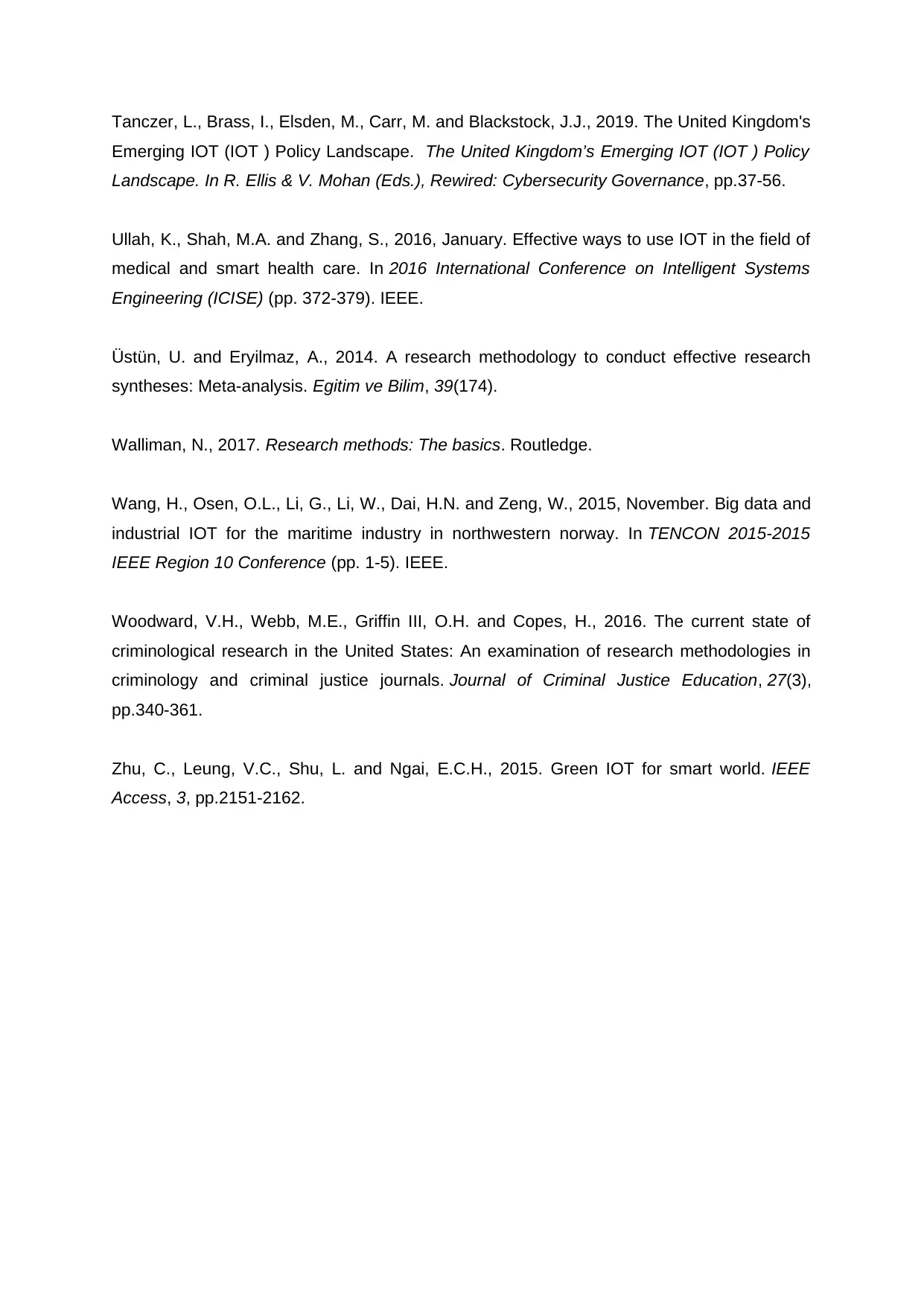
Tanczer, L., Brass, I., Elsden, M., Carr, M. and Blackstock, J.J., 2019. The United Kingdom's
Emerging IOT (IOT ) Policy Landscape. The United Kingdom’s Emerging IOT (IOT ) Policy
Landscape. In R. Ellis & V. Mohan (Eds.), Rewired: Cybersecurity Governance, pp.37-56.
Ullah, K., Shah, M.A. and Zhang, S., 2016, January. Effective ways to use IOT in the field of
medical and smart health care. In 2016 International Conference on Intelligent Systems
Engineering (ICISE) (pp. 372-379). IEEE.
Üstün, U. and Eryilmaz, A., 2014. A research methodology to conduct effective research
syntheses: Meta-analysis. Egitim ve Bilim, 39(174).
Walliman, N., 2017. Research methods: The basics. Routledge.
Wang, H., Osen, O.L., Li, G., Li, W., Dai, H.N. and Zeng, W., 2015, November. Big data and
industrial IOT for the maritime industry in northwestern norway. In TENCON 2015-2015
IEEE Region 10 Conference (pp. 1-5). IEEE.
Woodward, V.H., Webb, M.E., Griffin III, O.H. and Copes, H., 2016. The current state of
criminological research in the United States: An examination of research methodologies in
criminology and criminal justice journals. Journal of Criminal Justice Education, 27(3),
pp.340-361.
Zhu, C., Leung, V.C., Shu, L. and Ngai, E.C.H., 2015. Green IOT for smart world. IEEE
Access, 3, pp.2151-2162.
Emerging IOT (IOT ) Policy Landscape. The United Kingdom’s Emerging IOT (IOT ) Policy
Landscape. In R. Ellis & V. Mohan (Eds.), Rewired: Cybersecurity Governance, pp.37-56.
Ullah, K., Shah, M.A. and Zhang, S., 2016, January. Effective ways to use IOT in the field of
medical and smart health care. In 2016 International Conference on Intelligent Systems
Engineering (ICISE) (pp. 372-379). IEEE.
Üstün, U. and Eryilmaz, A., 2014. A research methodology to conduct effective research
syntheses: Meta-analysis. Egitim ve Bilim, 39(174).
Walliman, N., 2017. Research methods: The basics. Routledge.
Wang, H., Osen, O.L., Li, G., Li, W., Dai, H.N. and Zeng, W., 2015, November. Big data and
industrial IOT for the maritime industry in northwestern norway. In TENCON 2015-2015
IEEE Region 10 Conference (pp. 1-5). IEEE.
Woodward, V.H., Webb, M.E., Griffin III, O.H. and Copes, H., 2016. The current state of
criminological research in the United States: An examination of research methodologies in
criminology and criminal justice journals. Journal of Criminal Justice Education, 27(3),
pp.340-361.
Zhu, C., Leung, V.C., Shu, L. and Ngai, E.C.H., 2015. Green IOT for smart world. IEEE
Access, 3, pp.2151-2162.
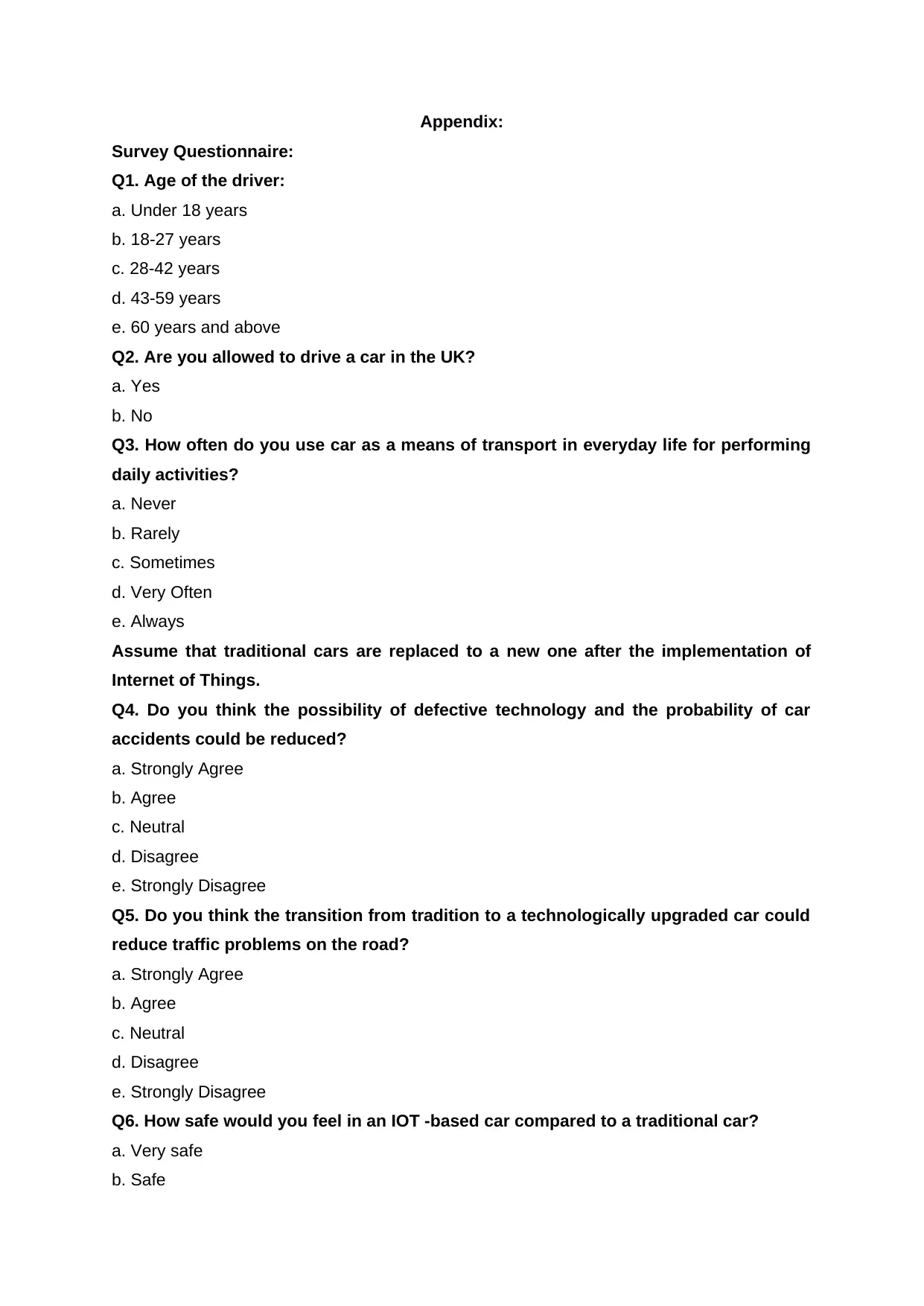
Appendix:
Survey Questionnaire:
Q1. Age of the driver:
a. Under 18 years
b. 18-27 years
c. 28-42 years
d. 43-59 years
e. 60 years and above
Q2. Are you allowed to drive a car in the UK?
a. Yes
b. No
Q3. How often do you use car as a means of transport in everyday life for performing
daily activities?
a. Never
b. Rarely
c. Sometimes
d. Very Often
e. Always
Assume that traditional cars are replaced to a new one after the implementation of
Internet of Things.
Q4. Do you think the possibility of defective technology and the probability of car
accidents could be reduced?
a. Strongly Agree
b. Agree
c. Neutral
d. Disagree
e. Strongly Disagree
Q5. Do you think the transition from tradition to a technologically upgraded car could
reduce traffic problems on the road?
a. Strongly Agree
b. Agree
c. Neutral
d. Disagree
e. Strongly Disagree
Q6. How safe would you feel in an IOT -based car compared to a traditional car?
a. Very safe
b. Safe
Survey Questionnaire:
Q1. Age of the driver:
a. Under 18 years
b. 18-27 years
c. 28-42 years
d. 43-59 years
e. 60 years and above
Q2. Are you allowed to drive a car in the UK?
a. Yes
b. No
Q3. How often do you use car as a means of transport in everyday life for performing
daily activities?
a. Never
b. Rarely
c. Sometimes
d. Very Often
e. Always
Assume that traditional cars are replaced to a new one after the implementation of
Internet of Things.
Q4. Do you think the possibility of defective technology and the probability of car
accidents could be reduced?
a. Strongly Agree
b. Agree
c. Neutral
d. Disagree
e. Strongly Disagree
Q5. Do you think the transition from tradition to a technologically upgraded car could
reduce traffic problems on the road?
a. Strongly Agree
b. Agree
c. Neutral
d. Disagree
e. Strongly Disagree
Q6. How safe would you feel in an IOT -based car compared to a traditional car?
a. Very safe
b. Safe

c. Neutral
d. Slightly unsafe
e. Very unsafe
Q7. How do you think the installation of IOT in smart cars can make the UK road
infrastructure safer?
a. Developing the behaviour of driver
b. reducing car accidents
c. Detecting road conditions
d. Preventing disasters on the road
Q8. How Nissan can use IOT in cars to make the UK roads safer?
a. By collecting road weather data
b. traffic
c. By examining health and maintenance of vehicle
d. Notifying the defect of the system
e. Signalling the administrator to control the car by analysing the physical condition and
driving condition of the driver
d. Slightly unsafe
e. Very unsafe
Q7. How do you think the installation of IOT in smart cars can make the UK road
infrastructure safer?
a. Developing the behaviour of driver
b. reducing car accidents
c. Detecting road conditions
d. Preventing disasters on the road
Q8. How Nissan can use IOT in cars to make the UK roads safer?
a. By collecting road weather data
b. traffic
c. By examining health and maintenance of vehicle
d. Notifying the defect of the system
e. Signalling the administrator to control the car by analysing the physical condition and
driving condition of the driver
1 out of 49
Related Documents
Your All-in-One AI-Powered Toolkit for Academic Success.
+13062052269
info@desklib.com
Available 24*7 on WhatsApp / Email
![[object Object]](/_next/static/media/star-bottom.7253800d.svg)
Unlock your academic potential
© 2024 | Zucol Services PVT LTD | All rights reserved.




